A Canadian Collection
This second of three auction sales of paintings from an important private collection, returning so many major works of Canadian art to the market, is, once again, a cause for joy. With fascinating provenances, as well as exhibition and publication histories, this collection provides a broad survey of the history of Canadian art. Images of early Canada appear in Cornelius Krieghoff’s superb painting of the Royal Mail Crossing the St. Lawrence , in William Napier’s canvas of Montmorency Falls’ famous ice cone, in Daniel Fowler’s watercolour evoking the natural riches of abundant game, in Edward Roper’s glimpse of a Tsleil-Waututh or Coast Salish village and F.M. Bell-Smith reminds us of the rural roots of our contemporary urban environment in Strawberry Picking, Oakville . The mid-nineteenth century nationalist landscape movement is represented by paintings of New Brunswick and Quebec by Allan Edson, John Fraser and Henry Sandham and by three works by William Raphael, including what is probably his first image of Montreal’s bustling Bonsecours Market. Lucius O’Brien’s watercolour Through the Rocky Mountains, a Pass on the Canadian Highway has become a classic image of a moment in Canadian history. The various influences of the French training that attracted so many Canadian artists from the 1870s are seen in the formal genre painting by Robert Harris, in the plein air paintings by William Blair Bruce, Paul Peel and F. M. Bell-Smith, in a painting and rare sculpture by Joseph‒Charles Franchère, in the late Barbizon and realist paintings

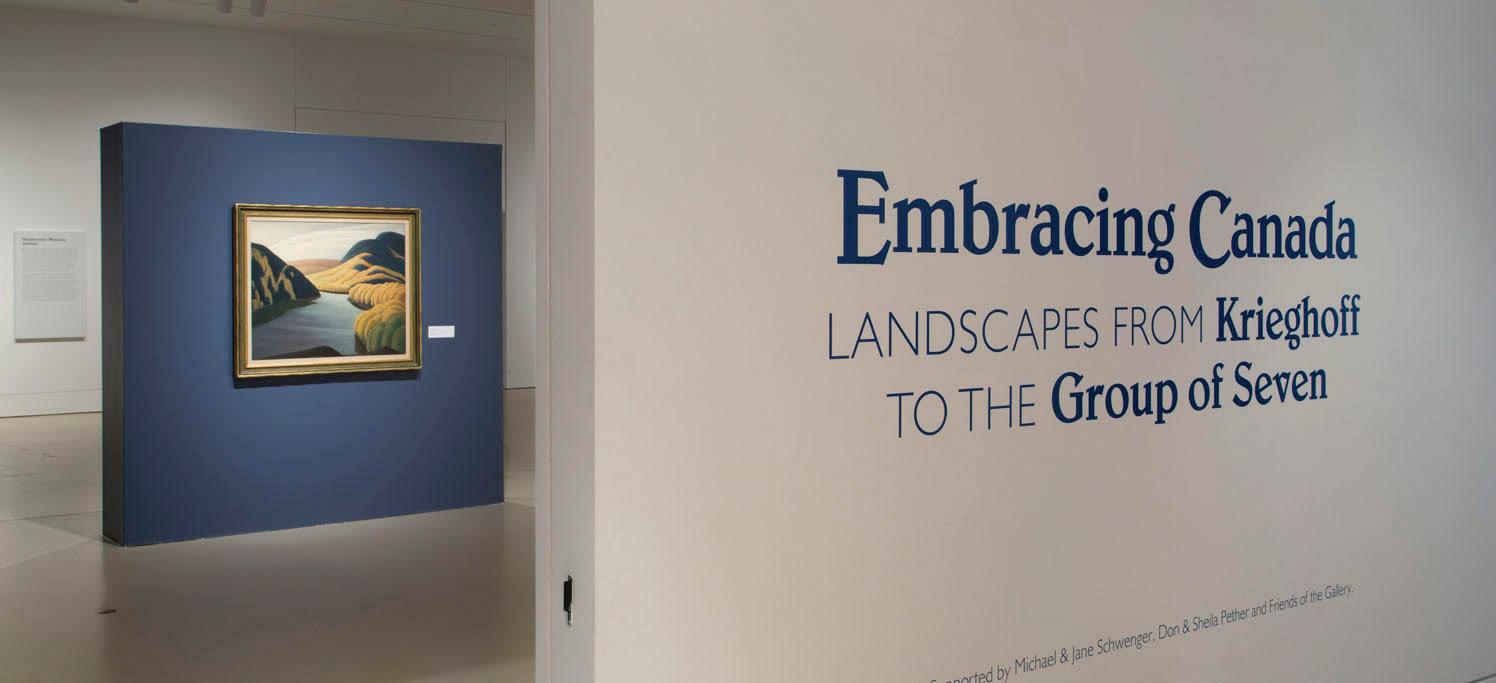
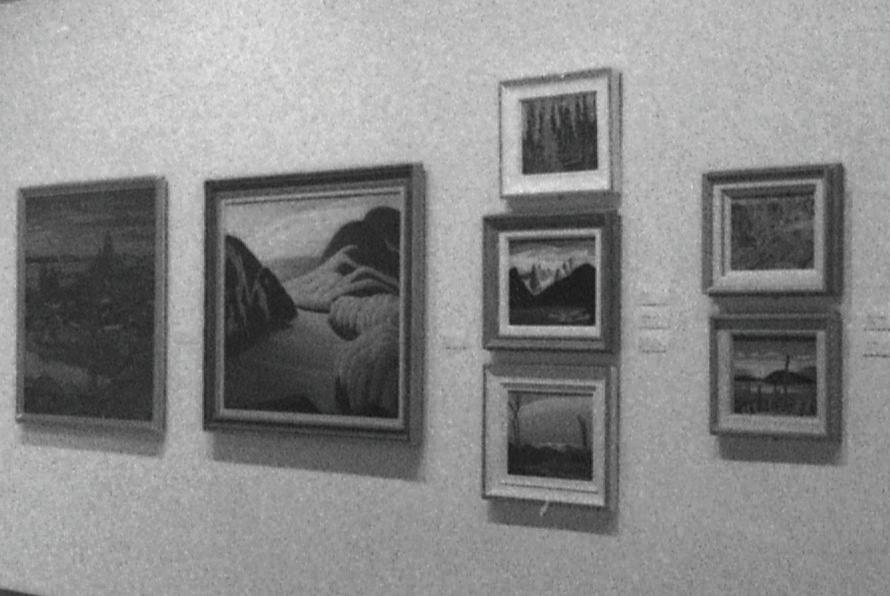 Exhibition of Collector’s Canada: Selections from a Toronto Private Collection Art Gallery of Ontario, 1988
Photo: Art Gallery of Hamilton
Exhibition of Embracing Canada: Landscapes from Krieghoff to the Group of Seven Art Gallery of Hamilton, 2016
Exhibition of Collector’s Canada: Selections from a Toronto Private Collection Art Gallery of Ontario, 1988
Photo: Art Gallery of Hamilton
Exhibition of Embracing Canada: Landscapes from Krieghoff to the Group of Seven Art Gallery of Hamilton, 2016
by Charles Huot, Henri Julien and Horatio Walker, and in two very contrasting works by Suzor-Coté: a luscious still life of 1897 and an Impressionist portrait of 1918. Paintings by Henry Rosenberg, Henri Beau, Mary Bell Eastlake, Franklin Brownell and W.H. Clapp demonstrate the evolution from plein air painting to Impressionism, and the complexities and importance of these international cross currents culminate in the rich harmonies of the sensuous painting by James Wilson Morrice and the analytical colour structures of David Milne. Delightful images of children abound in the paintings by Blair Bruce, Paul Peel, Henry Rosenberg, Mary Bell Eastlake and Henri Beau.
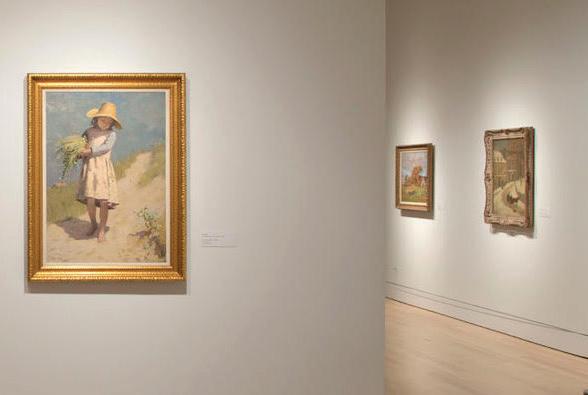
Paintings by James Kerr‒Lawson, and Clapp, Walker and Morrice, exemplify the internationalist ambitions of the Canadian Art Club in the early twentieth century, to evolve into the nationalist visions of the members of the Group of Seven. The superb oil sketches by Tom Thomson, Franklin Carmichael and J.E.H. MacDonald are symphonies of colour. Frank Johnston is represented by a dramatic Algoma painting of the Montreal River, Arthur Lismer by a study for his iconic painting September Gale , Lawren Harris by a serene and scintillating canvas of the Lake Superior landscape, Fred Varley by his evocative painting of Lynn Valley and A.Y. Jackson and Albert Robinson create two very different moods in their paintings of Quebec villages on the north shore of the Lower Saint Lawrence. Chronologically the sale culminates in Emily Carr’s canvas of poles in the village of Kitwancool and her haunting wood interior.

Once again one is impressed by the intelligence behind the formation of this private collection that resulted in the 1988 exhibitions Collector’s Canada , organized by Dennis Reid for the Art Gallery of Ontario, and Embracing Canada , organized by Ian Thom for the Vancouver Art Gallery in 2015. Both exhibitions travelled to venues across Canada.
Walking through this collection, we are privileged to get a rich overview of the development of Canadian art from the early nineteenth to the midtwentieth century. It is a collection that reflects the great curiosity, hard work, passion and visual acuity of the two collectors.
Photo: Art Gallery of Ontario
Photo: Art Gallery of Hamilton
101
FREDERIC MARLETT BELL-SMITH
Strawberry Picking, Oakville, circa 1900
oil on canvas
signed lower left
25 ins x 36 ins; 62.5 cms x 90 cms
PROVENANCE
Mr. and Mrs. Jules Loeb, Toronto Private Collection
EXHIBITED
Ontario Society of Artists 29th Exhibition , from 2 March 1901, no. 3 Pan-American Exposition , Canadian Art Gallery, Buffalo, 1 May‒2 November 1901, no. 3
Frederic Marlett Bell-Smith (1846-1923), Art Gallery of Greater Victoria; travelling to Glenbow‒Alberta Institute, Calgary; The Robert McLaughlin Gallery, Oshawa; The Art Gallery of Stratford; Agnes Etherington Art Centre, Queens University, Kingston; London Art Gallery; Art Gallery of Windsor, 15 September 1977‒30 July 1978, no. 3
The Private Eye: Art, Collectors and Their Stories, McMichael Canadian Art Collection, Kleinburg, 1 July‒14 November 2004 as Strawberry Pickers, Oakville, Ontario, circa 1900
Embracing Canada: Landscapes from Krieghoff to the Group of Seven , Vancouver Art Gallery; travelling to the Glenbow Museum, Calgary; Art Gallery of Hamilton, 30 October 2015‒25 September 2016
Our Children: Reflections of Childhood in Historical Canadian Art, Varley Art Gallery, Markham, 13 April‒23 June 2019, as Picking Strawberries in Oakville, circa 1900
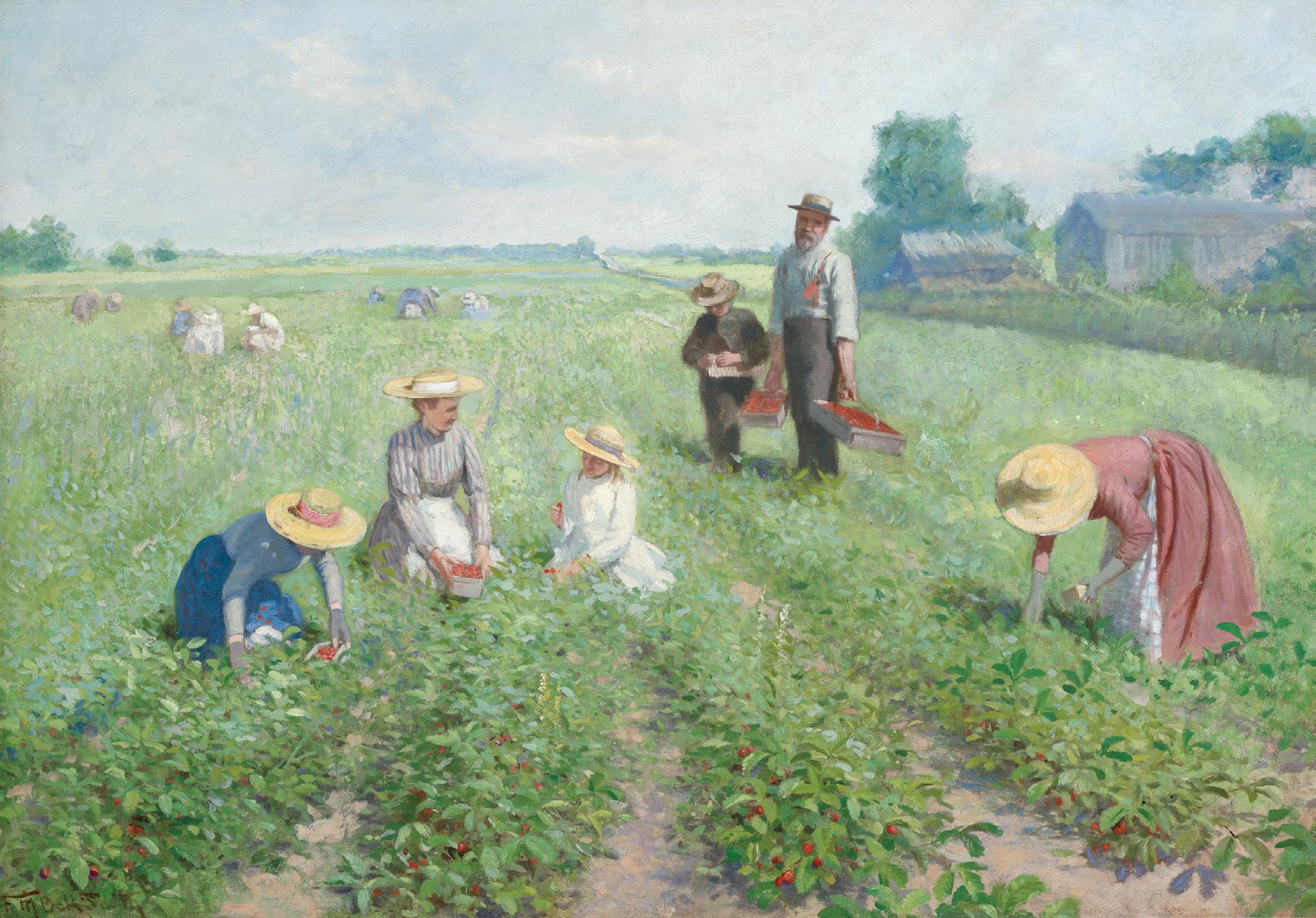
LITERATURE
Roger Boulet, Frederic Marlett Bell-Smith (1846-1923), Art Gallery of Greater Vancouver, 1977, plate 3, reproduced page 40 as Gathering Strawberries
Ian Thom, et al., Embracing Canada: Landscapes from Krieghoff to the Group of Seven , Vancouver/London, 2015, page 200, reproduced page 78
In Strawberry Picking, Oakville, Frederic Marlett Bell-Smith captures a favourite summer pastime for many Ontario residents. As an article of historical documentation, the picture gives insight into the summer fashions at the turn of the century. The women all wear widebrimmed straw hats and crisp long-sleeved dresses. The male figures, who are carrying the crates of picked strawberries, are both wearing brown and donning boater hats. Bell-Smith excelled in the painting of atmospheric effects, as demonstrated by the warm sunlight that reaches the figures through the clouds, and the soft and muted paint application which evoke the sensation of a humid summer day.
Bell-Smith returned to Europe many times throughout his career, and he established a reputation for himself in Britain after being granted a personal sitting by Queen Victoria in 1895. The artist contemplated moving to Britain during this time, but he decided to remain based in Canada. Strawberry Picking, Oakville was painted in 1900, shortly after completing the Queen’s portrait, during the height of the artist's career. Back in Ontario, where he taught and practiced, Bell–Smith advocated for a distinctly Canadian style and believed that it would rival the masterworks of Europe.
$30,000–$50,000
COWLEY ABBOTT | An Important Private Collection of Canadian Art - Part II - Spring 2023 10
HORATIO WALKER
A Load of Wood, Winter oil on canvas signed and dated 1916 lower right 18 ins x 24 ins; 45 cms x 60 cms
PROVENANCE
Montross Gallery, New York Private Collection, United States
Sotheby’s, auction, Toronto, 12-13 May 1987, lot 176 as Loading the Sleigh, Dusk Private Collection
Fraser’s Auctions, Montreal, October 1988 Private Collection
Walter Klinkhoff Gallery, Montreal
Acquired by the present Private Collection, 1989
EXHIBITED
Embracing Canada: Landscapes from Krieghoff to the Group of Seven , Vancouver Art Gallery; travelling to the Glenbow Museum, Calgary; Art Gallery of Hamilton, 30 October 2015‒25
September 2016
LITERATURE
Lyne Gravel, Les Oeuvres d’Horatio Walker, Musée du Québec, 1987
A.K. Prakash, “Horatio Walker A.R.C.: le vieux maître de l’Île d’Orléans,” Magazin’Art 7:4 (Ète/Summer 1995), pages 76-81, reproduced page 79
A.K. Prakash, Canadian Art Selected Masters from Private Collections, Ottawa, 2003, reproduced page 33 Ian Thom, et al., Embracing Canada: Landscapes from Krieghoff to the Group of Seven , Vancouver/ London, 2015, reproduced page 54 Highlights from ‘Embracing Canada’, Annual Loan Exhibition, Galerie Eric Klinkhoff, Montreal, 22 October–5 November 2016, no. 16
A Load of Wood, Winter was most likely painted at the village of Ste-Pétronille on Île d’Orléans, across the St. Lawrence River from Quebec City. Horatio Walker had begun visiting the island several years before the end of the nineteenth century, had purchased a residence, and was spending more and more time there until he finally moved permanently to the village in 1928. Although he had been born in Listowel, Ontario in 1858, he had a longstanding love affair with French Quebec.
By 1916, however, Walker’s vision of Ste-Pétronille had become largely frozen in time. Twelve years later, in 1928, the Montreal art critic and journalist Jean Chauvin, in his book Ateliers, observed that Walker’s representations of Île d’Orléans often seemed to be documenting long-ago French-Canadian life, or even mid-nineteenth-century peasant life in France, when farmers wore clogs and lived lives in thatched-roof houses, largely isolated from the modern world. Walker stoutly resisted the inescapable coming of the twentieth century to Île d’Orléans, unsuccessfully opposing both the arrival of automobiles and the building of a bridge linking the island with Quebec City. A Load of Wood, Winter, however, is less atemporal than many of Walker’s other paintings, even if his fondness for nostalgic romanticism is manifested in the evocatively symbolic background sunset and the wooden ox cart.
A Load of Wood, Winter was painted either shortly before or shortly after the 1916 collapse of the Canadian Art Club. The CAC had been formed in 1908 with the goal of raising the level of interest in Canadian art exhibitions by, in part, encouraging largely expatriate artists such as Walker and James Wilson Morrice to spend more time showing in Canada. (Walker was so closely identified with the United States and its art market that he was regularly assumed to be an American artist.) Walker’s membership in the CAC did encourage him to participate more actively in Canadian exhibitions, and he was even elected president of the club in 1915, with the result that Canadian awareness of his work was heightened. That awareness that would have been bolstered by canvases such as A Load of Wood, Winter, in which his lusciously generous paint application lent his nostalgic imagery a contemporary look that proved popular with critics and collectors. Walker’s star would subsequently be eclipsed following the formation in 1920 of the Group of Seven and the Beaver Hall Group; but for the time being his warmly painted, empathetic views of rural French-Canadian life appealed strongly to appreciative audiences.
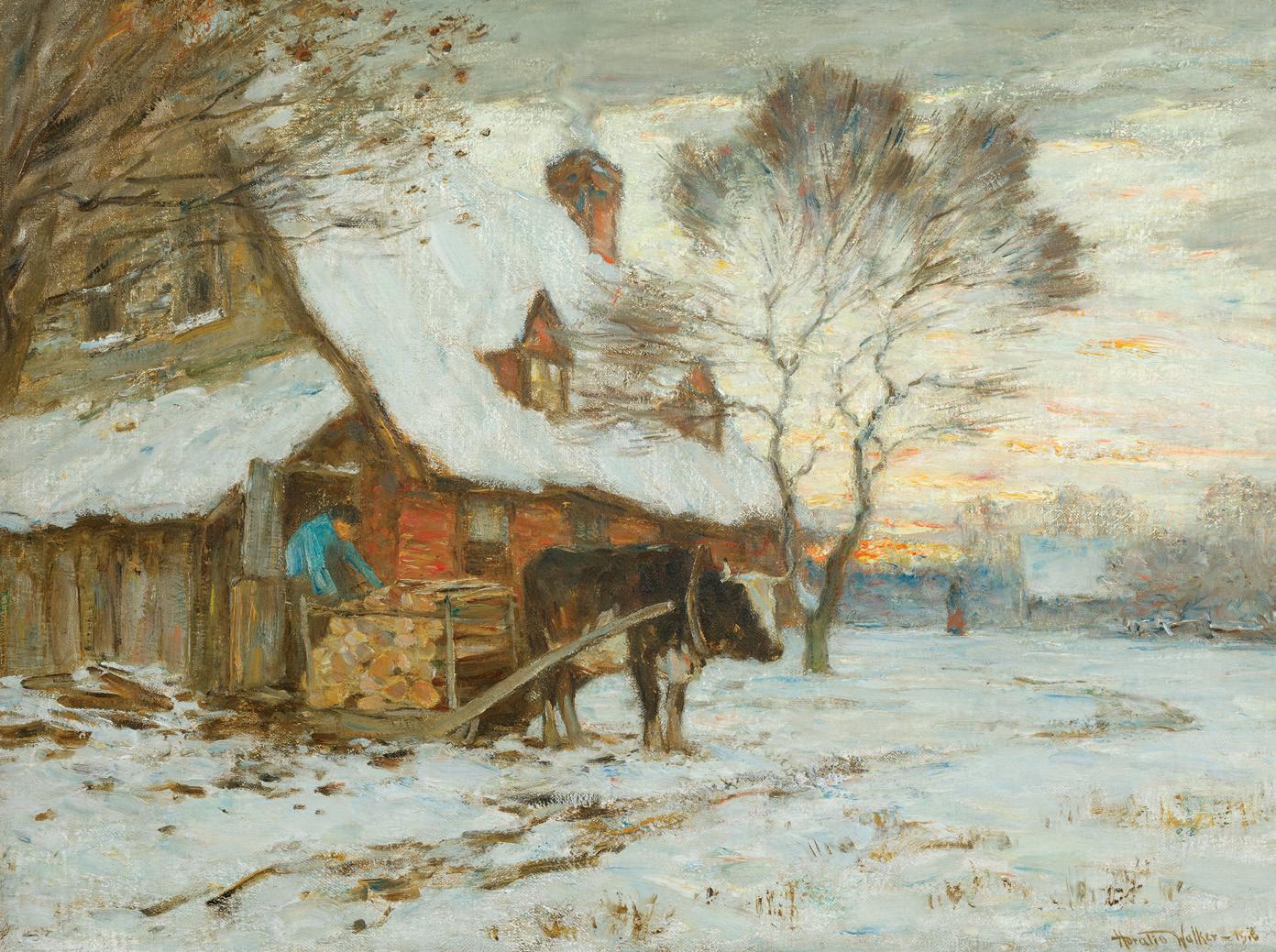
We extend our thanks to Brian Foss, Carleton University Chancellor’s Professor of Art & Architectural History, and co‒curator of 1920s Modernism in Montreal: The Beaver Hall Group for his assistance in researching this artwork and for contributing the preceding essay.
$20,000–$30,000
COWLEY ABBOTT | An Important Private Collection of Canadian Art - Part II - Spring 2023 11 102
JAMES EDWARD HERVEY MACDONALD
Cedars, Little Turtle Lake, 1922
oil on wood-pulp board signed, titled and inscribed “Studio Building, 25 Severn St.” on the reverse 8.5 ins x 10.5 ins; 21.3 cms x 26.3 cms
PROVENANCE
R.A. Laidlaw, Toronto
Acquired by the present Private Collection, March 1981
EXHIBITED
Collector’s Canada: Selections from a Toronto Private Collection , Art Gallery of Ontario, Toronto; travelling to Musée du Québec, Quebec City; Vancouver Art Gallery; Mendel Art Gallery, Saskatoon, 14 May
1988‒7 May 1989, no. 59, as circa 1919
Embracing Canada: Landscapes from Krieghoff to the Group of Seven , Vancouver Art Gallery; travelling to the Glenbow Museum, Calgary; Art Gallery of Hamilton, 29 October 2015‒5 September 2016, as circa 1919
LITERATURE
L.S. Harris, “The Group of Seven in Canadian History,” The Canadian Historical Association, Report of the Annual Meeting Held at Victoria and Vancouver, June 16-19, 1948, Toronto, 1948, page 34
Nancy Robertson, J.E.H. MacDonald, R.C.A, 1873-1932, Toronto, 1965, page 53, no. 81
Paul Duval, The Tangled Garden: The Art of J.E.H. MacDonald , Scarborough, 1978, pages 141-142
Dennis Reid, Collector’s Canada: Selections from a Toronto Private Collection , Toronto, 1988, no. 59, reproduced page 60 as circa 1919
David Milne Jr. and David P. Silcox, David B. Milne: Catalogue Raisonné of the Paintings, Toronto, 1998, vol. II, pages 732-734
Ian Thom, et al., Embracing Canada: Landscapes from Krieghoff to the Group of Seven , Vancouver/London, 2015, page 200, reproduced page 92, caption page 202 as circa 1919
In a talk given to the Canadian Historical Association in 1948, Lawren Harris observed, “We found … that there was a wild richness and clarity of colour in the Algoma woods which made the colour in southern Ontario seem grey and subdued.” This “wild richness and clarity of colour” is especially evident in the oil sketches J.E.H. MacDonald painted in Algoma from 1918 to 1920 and in the resultant canvases he worked on into 1922. This superb sketch has all the vivid colour of his oil sketch, On Montreal Lake, Algoma of 1919, sold as lot 118 at Cowley Abbott on 1 December 2022. But this was not painted in Algoma but on Little Turtle Lake on the Gull River, north of Coboconk in Haliburton. David Milne would also paint there in the fall of 1940. As noted by Paul Duval, at Coboconk MacDonald visited an old colleague from Grip Ltd., Fred Peel, who owned a lumber mill and cottage in the area. He first painted on the Gull River as early as 1911 as evidenced by dated sketches, such as the charming Logs on Gull River (sold Sotheby’s Canada-Ritchie’s, 30 May 2005, lot 32). That painting is probably the work titled Logs in the River that MacDonald exhibited at the Canadian National Exhibition late August 1911 together with Summer Clouds, Little Turtle Lake and Moonlight, Gull River
While MacDonald had been able to paint in October in Algoma from 1918 to 1920, he was appointed instructor in decorative art and commercial design at the Ontario College of Art in the fall of 1921. Given his teaching commitments, sketching expeditions were now limited to summers. He returned to Little Turtle Lake during the summers of 1921, 1922 and 1923, as evidenced by oil sketches dated and titled by the artist; however a sketch included in the 1965 MacDonald retrospective exhibition, titled and dated by the artist Birches in Autumn, Gull River, Coboconk, 1922 (catalogue no. 81, private collection), confirms an autumn visit, which would explain the autumnal colours evident in Cedars, Little Turtle Lake.
In this remarkable jewel of a sketch, the cedar’s branches extend over the water, creating a complex linear pattern framing the autumn foliage. The leaves range from dark greens and browns upper left to the contrasting bright oranges, pale greens and deep reds that reach across to the autumn foliage on the far shore. The smoothly brushed water glistens with blues, pinks and whites. Cedars, Little Turtle Lake was definitely painted with memories of autumn in Algoma.
We extend our thanks to Charles Hill, Canadian art historian, former Curator of Canadian Art at the National Gallery of Canada and author of The Group of Seven‒Art for a Nation , for his assistance in researching this artwork and for contributing the preceding essay.
$70,000–$90,000
COWLEY ABBOTT | An Important Private Collection of Canadian Art - Part II - Spring 2023 12
103
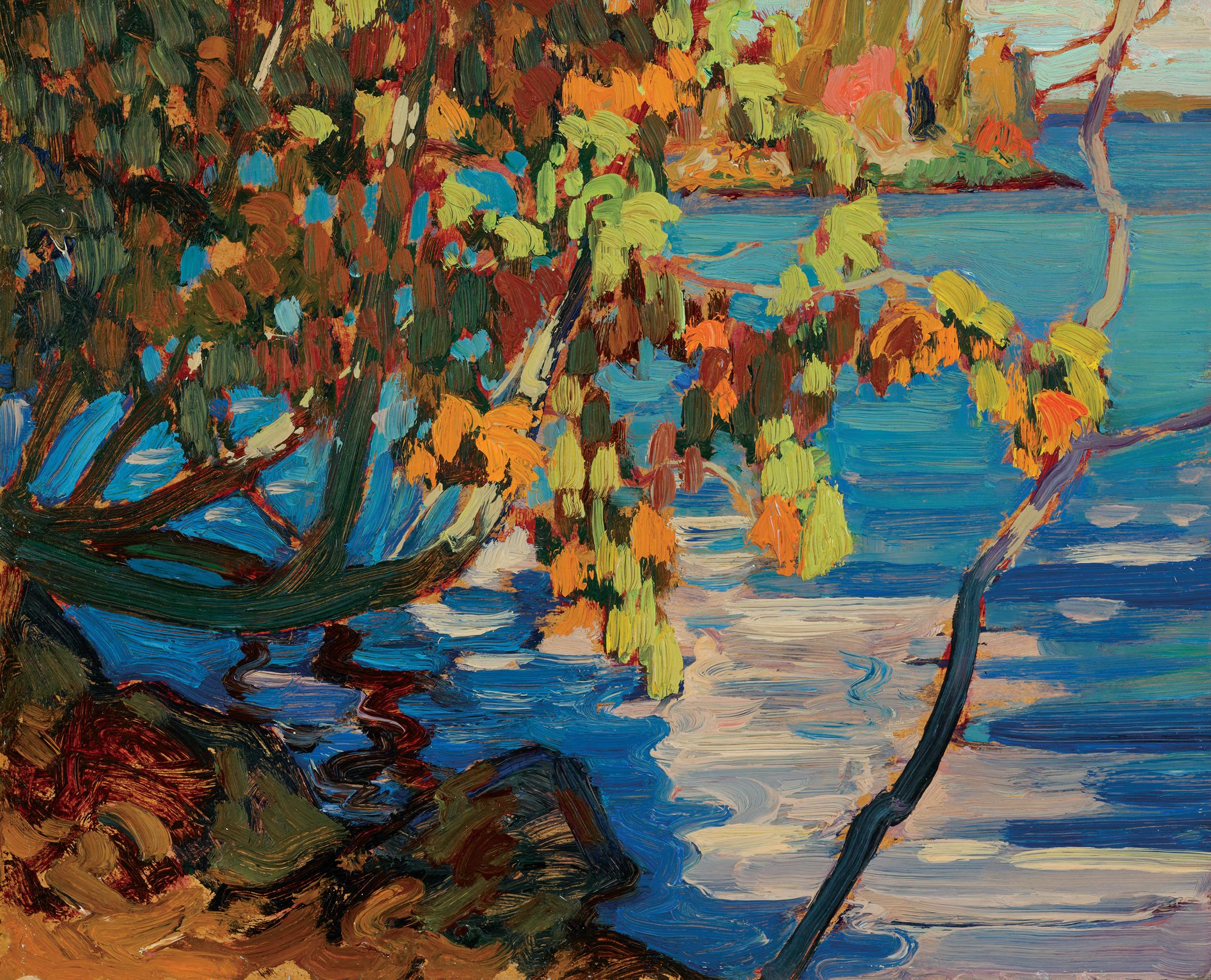
COWLEY ABBOTT | An Important Private Collection of Canadian Art - Part II - Spring 2023 13
ALBERT HENRY ROBINSON
Les Éboulements en haut, circa 1928 oil on panel titled to a gallery label and inscribed “Baie St. Paul” on the reverse 11.25 ins x 13 ins; 28.1 cms x 32.5 cms
PROVENANCE
The Artist
Roseanne Gasse Mayer
By descent to family of Roseanne Gasse Mayer
Walter Klinkhoff Gallery, Montreal
Acquired by the present Private Collection, November 1992
EXHIBITED
Hommage à Albert H. Robinson , Galerie Walter Klinkhoff, Montreal, September 1994, no. 3 as Baie St-Paul, circa 1928
LITERATURE
A.Y. Jackson to Clarence Gagnon, 20 March 1927
Arthur Lismer, Canadian Picture Study, Art Gallery of Toronto, 1940
The Collection of Mitzi and Mel Dobrin , Alan Kinkhoff Gallery, Toronto, 2020
The subject of this sketch is identified by a penciled note on the verso, written in an unidentified hand, as Baie-Saint-Paul. However, it can be confirmed as a view of Les Éboulements en haut, thanks to the prominent spire of the Église de l’Assomption de la Sainte Vièrge. The sketch postdates a 1921 trip Albert Robinson made with A.Y. Jackson to Cacouna, on the south shore of the Saint Lawrence River: the first of what became Robinson’s yearly late winter/early spring sketching expeditions along the Saint Lawrence below Quebec City. But despite his initial 1921 foray along the south shore, Robinson’s preference was for the north shore where, throughout the 1920s and into the early 1930s, his annual trips in Beaupré and Charlevoix counties included visits to Saint-Tite-des-Caps, Baie-Saint-Paul, Les Éboulements, Murray Bay (now La Malbaie), Saint-Fidèle and Saint-Siméon.
Robinson’s precise movements on these trips are often uncertain. He can be securely placed in Les Éboulements only in 1926 (Falling Snow, Les Éboulements, Art Gallery of Hamilton), and 1929 (when Jackson documented the two of them working there). But Les Éboulements en haut might have been painted at another time during the 1920s, as Robinson is known to have been in nearby locales such as La Malbaie and, most often, Baie-Saint-Paul: towns that were just 30 and 17 km, respectively, from Les Éboulements. It may, for example, have
been made the same year that Jackson painted his oil sketch titled Winter Scene, Les Éboulements (formerly in the Mitzi and Mel Dobrin collection), as the two sketches are painted from a similar vantage point and with the church steeple positioned slightly left of centre. There are significant differences between the sketches, although these are not sufficient to obviate the possibility that they were painted at the same time‒and, indeed, the verso label indicates that Robinson at one point owned the Jackson. Robinson treats the buildings more individualistically, whereas Jackson abstracts them to emphasize their compositional rhythm: a decision that perhaps accounts for his omission of Robinson’s decorative trees and his simplification of the foreground fences. However, if the two sketches were painted at the same time, it cannot have been in 1922, as the verso label states. Both Jackson’s autobiography and his 1922 correspondence place him only on the south‒not the north‒shore of the St Lawrence that year, and don’t mention Robinson at all.
However, whenever in the 1920s Les Éboulements en haut was painted, it embodies the qualities for which Arthur Lismer praised Robinson in one of his 1940 Canadian Picture Study booklets: “In Robinson’s pictures we expect no great dramatic subject treatment, nor dynamic lines and sombre tones. His art is the colorful expression of daily life, full of charm, devoid of sentimentality….” The qualities of intimacy and harmonious colour that Jackson associated with the north shore are certainly present in Robinson’s intimate sketch: “The south shore,” wrote Jackson, “… depends more on the contours of its big spaces … its [sic] too intricate for sketching”. Indeed, part of the attraction of Les Éboulements en haut‒like that of many other 1920s sketches by Robinson‒resides in the deceptively simple compositional contrasts, in this case between the horizontality of the clustered buildings, and the soft diagonals of the foreground road, posts and snowdrifts. Equally characteristic of Robinson’s sketches is the refined colour scheme, with the subdued purplish tonality of the buildings punctuated by carefully placed areas of warm pink, orange, yellow and white, under a beautifully painted two-toned sky. These qualities in the sketch were for the most part retained in the larger (21.5” x 25.25”), highly finished canvas of the same name (Sotheby’s, 12 May 1987). The only striking compositional difference between the sketch and the canvas is a rearrangement of the sketch’s foreground fences: an alteration presumably made to increase the speed with which the eye travels from foreground to middle ground.
We extend our thanks to Brian Foss, Carleton University Chancellor’s Professor of Art & Architectural History, and co‒curator of 1920s Modernism in Montreal: The Beaver Hall Group for his assistance in researching this artwork and for contributing the preceding essay.
$40,000–$60,000
COWLEY ABBOTT | An Important Private Collection of Canadian Art - Part II - Spring 2023 14 104

COWLEY ABBOTT | An Important Private Collection of Canadian Art - Part II - Spring 2023 15
JAMES WILSON MORRICE
À Venise (Study for “Red Houses, Venice”) oil on wood panel signed lower left; titled and inscribed “J.W. Morrice”, “Bordeaux”, "chez M. Guichardaz 29 Rue T. Dragon”, “G. Lege...” on the reverse; stamped “Emilio Aikelin/Via 22 Marzo N. 2578/Venezia” (inversed) on the reverse; inscribed “Morrice. 2.” on a P. Ferret label on the reverse (stamped faintly “Salon de Bordeaux 1911”) 13 ins x 9.25 ins; 32.5 cms x 23.1 cms
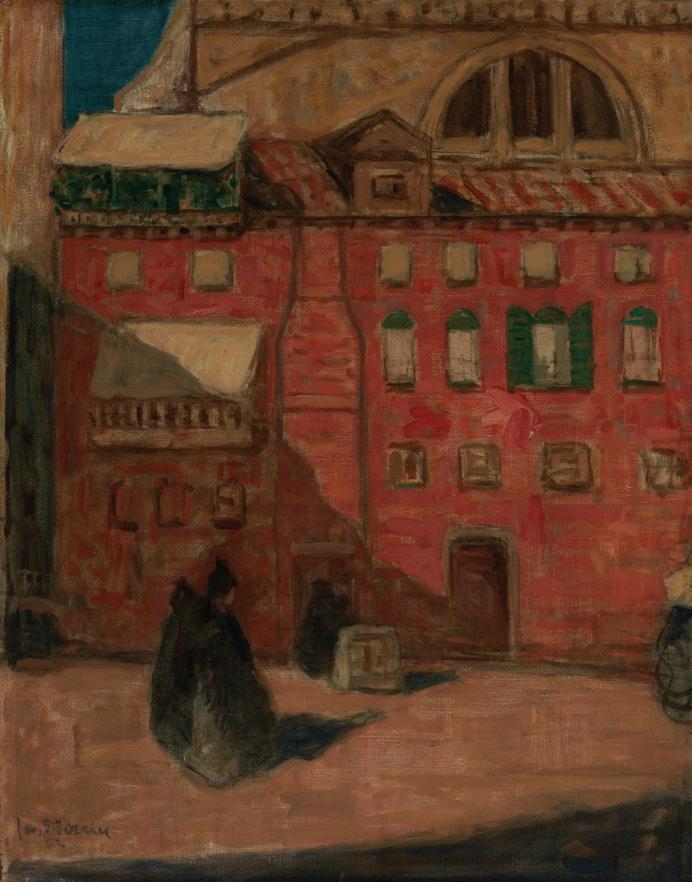
PROVENANCE
G. Léger, France (?)
Purchased in France by a woman from Kent, England Sotheby’s, auction, Toronto, 11 May 1994, lot 95
Private Collection
EXHIBITED
Possibly Salon d’Automne, 6e Exposition , Grand Palais, Paris, France, 1 October‒8 November 1908, no. 1485 as À Venise
59e Exposition de la Société des Amis des Arts de Bordeaux , Terrasse du Jardin‒Public, Bordeaux, France, 4 February‒April 1911, no. 421 as Maisons rouges à Venise
Exposition de la Société Nouvelle sous la présidence d'Auguste Rodin , Galerie Georges Petit, Paris, France, 18 March‒5 April 1914, no. 59 as La Maison rouge, Venise
Summer Exhibition , Goupil Gallery, London, U.K., June‒July 1914, no. 38 as The Red House, Venice
Collectors’ Treasures II/Trésors des collectionneurs II, Galerie Eric Klinkhoff, Montreal, 24 October‒7 November 2020, no. 24 as Old House, Venice
LITERATURE
J.W. Morrice, Sketchbook #6, page 63 “Red House W. Leger/33 x 24/ No 239", over a sketch of the corner of its frame (same as today); page 62 represents the grouping of Morrice’s entries at the 1914 exhibition of the Société Nouvelle. Both pages drawn at the opening, where he was seen by “Antoinette”
Roger Marx, "Le vernissage du Salon d'Automne", Chronique des Arts et de la Curiosité, Paris, 10 October 1908, page 327 (mentions Venise ‒if it is this Study)
Louis Vauxcelles, “Expositions diverses”, Gil Blas (Paris), 27 March 1914, page 4 "coloriste libre et savoureux."
Louis Hautecoeur, "La 'Société Nouvelle' (Galerie Georges Petit)”, Chronique des Arts et de la Curiosité (Paris), 28 March 1914, page 99 Antoinette, "Causerie de Paris", The Gazette (Montreal), 1 April 1914, page 2 "Among the pictures which attracted the most attention... a Venetian house with an exquisite note of color." (She saw Morrice there, just back from Tunis.)
Special correspondant [Antoinette?], “Our Paris Letter‒Société Nouvelle”, The Montreal Star, 11 April 1914, page 24 mentions "a Venetian study”
John O’Brian, “Morrice. O'Conor, Gauguin, Bonnard et Vuillard", Revue de l’Université de Moncton, 15 April-December 1982, pages 9-34 Nhajjar, Campo San Vidal, https://veniceblog.typepad.com/ veniceblog/2006/09/index.html, September 2006
Morrice visited Venice at least seven times between 1894 and 1907, often for weeks at a time. The paintings he brought back to his Paris studio illustrate his artistic development during that period: early small pochades, then beautiful Impressionist studies of facades at sunset on the Grand Canal, and finally the last, almost Fauve burst of oranges and turquoises under blue skies. With its vivid red and yellow, this painting belongs to that last period, probably painted during a visit in the Fall of 1906.
Art historian John O’Brian once compared the Red Houses canvas (Montreal Museum of Fine Arts), an enlarged version of this Study, to the well-known Venice at the Golden Hour in the same museum, still influenced by Whistler and Impressionism; his comments also apply to their respective studies. That for Golden Hour (also MMFA) is based on a grid pushed back by the canal at bottom, reducing the figures on the opposite riva to silhouettes; everything is getting darker under the failing light. Beside it, the Study for “Red Houses” bursts with sun and colour, and there is no water in sight. The two yellow ochre bands, pavement and church, with their complementary patch of dark blue sky, are all on the picture plane, and the black shawls of the popolane are there too. The grid, less rigid, is broken by the shadow on the facade; the composition is cropped more tightly, and not only at the top; a narrow canal at left is only hinted at, and there is no clue that an enclosed garden, with tall cypresses, borders the space on the right.
O’Brian rightly attributes these differences, especially the use of colour, to Morrice’s discovery of Gauguin. Another influence was also at work, that of the “Fauves”, whose pure colours and flat surfaces had shocked the critics of the 1905 Salon d’Automne; indeed, the vivid green shutters on the pure red wall could have been painted by Henri Matisse. If the Golden Hour panel is still a “sketch”, our Study, slightly larger in format, is not. It is so finished that it was probably not painted on the motif, but in the comfort of a studio or hotel room, based on drawings in a sketchbook; unfortunately, none has survived from this 1906 trip. Also, there was (and still is) no welcoming caffè terrace on small Campo San Vidal, the subject of this painting; is it why it did not inspire any other artist before him?
COWLEY ABBOTT | An Important Private Collection of Canadian Art - Part II - Spring 2023 16 105
James Wilson Morrice
Red House, Venice, circa 1906
oil on canvas, 64.1 x 49.5 cms
The Montreal Museum of Fine Arts, gift of James Wilson Morrice Estate, Inv. 1925.335
Photo MMFA, Jean-François Brière Not for sale with this lot
The site is particularly attractive in mid-afternoon, as here; and it is visible to anyone navigating on the Grand Canal or descending from the Accademia Bridge. But the boats don’t stop, and neither do the pedestrians hurrying towards the large Campo Santo Stefano behind the church, or San Marco further away. “A place to be rushed through, not savored. An artery.”
The humble housings, painted “Venetian Red”, are attached to the Church of San Vidal; the white form in the center of the painting is a public well. It is still there, and comparison with a rare 1899 photograph of the site (Alinari) shows that Morrice was faithful to its 1906 aspect: the chimney’s tall white shaft was already gone, but its flue facing was still attached to the facade (it will disappear soon after); the altana on the roof at left, beautifully adorned with flowers, and the balcony below it, are still extent.
On the back of the panel, the doubly underlined “Bordeaux” and the Ferret shipping label confirm the exhibition of the painting in 1911, together with an unidentified Plage ; the title, Maisons rouges à Venise, later also given to the canvas, was coined there, since À Venise was
hidden. Written with a different pencil, and followed by the artist’s name and the return address of his colour-man, the longer inscription suggests an earlier exhibition.
We first find the title À Venise in the catalogue of the 1908 Salon d’Automne; since the 1965 MMFA Morrice retrospective, is identified with the canvas (cat. no. 57), although there is no corresponding information on its back. Furthermore, in the Fall of 1912, Morrice listed “Venice, red house. (unfinished)” among pictures in his studio (MMFA, Sketchbook #17, page 7); it cannot be our Study, exhibited the year before. Morrice and Matisse were both on the painting jury of the 1908 Salon d’Automne, and the Canadian, with À Venise, might have intended to make his own “Fauve” statement; if so, we think that the panel better fits this role.

We extend our thanks to Lucie Dorais, Canadian art historian and author of J.W. Morrice (National Gallery of Canada, 1985), for contributing the preceding essay.
$90,000–$120,000
COWLEY ABBOTT | An Important Private Collection of Canadian Art - Part II - Spring 2023 17
EDWARD ROPER
A Northwest Coast Indian Village, circa 1887 oil and watercolour on paper laid on board signed lower right; inscribed “P.C. 381” on a label on the reverse 12.5 ins x 20.5 ins; 31.3 cms x 51.3 cms
PROVENANCE
Sotheby's, auction, Toronto, 20‒21 October 1975, lot 138
G. Blair Laing Ltd., Toronto
Kenneth Thomson, Toronto
A.K. Prakash & Associates, Inc., Toronto Private Collection
EXHIBITED
Embracing Canada: Landscapes from Krieghoff to the Group of Seven , Vancouver Art Gallery; travelling to the Glenbow Museum, Calgary; Art Gallery of Hamilton, 30 October 2015‒25 September 2016
LITERATURE
Marius Barbeau, “Tsawati, Knight Inlet”, Bulletin 119-Vol III
W.H. Allen, By Track and Trail: a journey through Canada , London, 1891, pages 204-206
Blair Laing, Memoirs of An Art Dealer 2, Toronto, 1982, no. 36, reproduced page 85
Ian Thom, et al., Embracing Canada: Landscapes from Krieghoff to the Group of Seven , Vancouver/London, 2015, reproduced page 26
Edward Roper is the quintessential Victorian imperial artist. Born in England, he emigrated with his family to Canada as a child in 1844, but went to Australia in 1853, then to England in 1857, and returned to Canada with his newlywed wife in 1858. He worked as a printer and amateur artist in Hamilton, Ontario, working for the earlier, Hamilton based version of the Canadian Illustrated News (1862‒1864). In 1865 he went back to England, and then spent three years in Australia from 1870‒1873, before making his home in England for the rest of his life, becoming a full-time artist and writer. However, he maintained his
Canadian connections with his family, traveling back to Canada several times over the next two decades, and publishing several illustrated accounts about different parts of the country, including Muskoka (1883) and Anticosti Island (1889). The most notable work was Roper’s account of his cross-country journey on the CPR in 1887, By Track and Trail: a journey through Canada ; with numerous original sketches by the author.
By this point, Roper had a thriving career, whose participation in a Burlington Gallery exhibition of Colonial Pictures in 1886 was recorded in the Daily Telegraph, which noted that “To Mr. E. Roper all persons desirous of acquiring real and varied knowledge…. will acknowledge a great and lasting debt… depicted with vigour and accuracy”. The exhibition included works by prominent Australian and New Zealand artists, including William Strutt, Nicholas Chevalier, Charles Edward Henn, and John Gully (1819-1888), but there were no less than 49 works by Roper. The Canadian and American section included no works by Roper, but did include four major paintings by Frances Anne Hopkins, three works by Frederick Verner, and three by Allan Edson, among others. Roper also organized another major and well-received exhibition of colonial pictures in 1889, and lectured widely about colonial life. It may have been because of his wide travels, the success of these exhibitions, and his speeches and presentations that Roper was elected a member of the Royal Geographical Society on December 9, 1889.
Roper’s practice was to sketch from life in pencil or watercolour, and then to complete paintings based on his plein air sketches. He wrote about visiting several Northwest Coast Indigenous villages during his weeks in British Columbia in June 1887. The actual site of this image is not identified, but in By Track and Trail Roper describes a visit to a village on the north shore of Burrard Inlet, possibly belonging to the Coast Salish or Tsleil-Waututh First Nation. The work fits closely with Roper’s written description of the village and represents a sympathetic and seemingly accurate image of First Nations life.
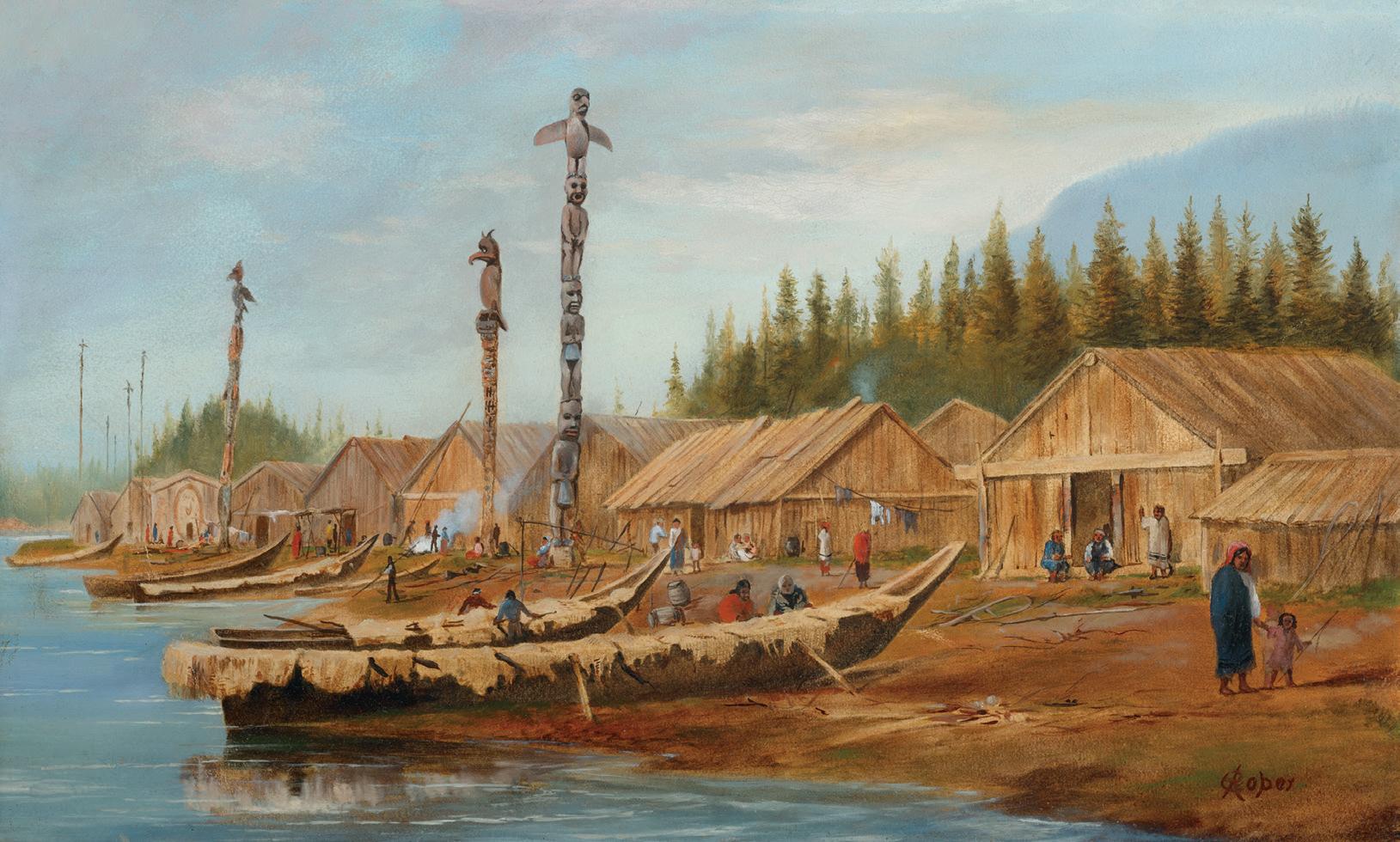
We extend our thanks to Jim Burant, art historian and curator, for contributing the preceding essay.
$10,000–$15,000
COWLEY ABBOTT | An Important Private Collection of Canadian Art - Part II - Spring 2023 18 106
107
WILLIAM RAPHAEL
Rafting on the Ottawa River oil on canvas signed lower left
12 ins x 17 ins; 30 cms x 42.5 cms
PROVENANCE
Private Collection, Montreal
Kaspar Gallery, Toronto, circa 2000 Private Collection, Calgary
The Collectors’ Gallery of Art, Calgary Acquired by the present Private Collection, 2019
LITERATURE
John W. Hughson and Courtney C. J. Bond, Hurling Down the Pine, Gatineau, 1964, pages 63, 110‒111
Sharon Rose Goelman, William Raphael, R.C.A. (1833-1914) (M.A. thesis, Concordia University, 1978) page 346, no. 109 as Logging Scene with Paddle Steamer
John Wadland, “Places,” in Charles C. Hill & Dennis Reid, Tom Thomson , Toronto/Ottawa/Vancouver, 2002, pages 101-102, 261, 282, 321 note 50
William Raphael painted landscapes as early as 1870 when he exhibited, at the Society of Canadian Artists’ second exhibition, a currently unlocated painting titled Falls of Le Trou , a site popular with the summer residents of Murray Bay. In most instances he included figures to animate the landscape and, with a few exceptions, the paintings are of relatively modest dimensions. In spite of Sharon Goelman’s ground-breaking thesis on Raphael, there is much that is unknown about the artist’s artistic development and production. He
was an infrequent exhibitor in Canadian art exhibitions, often showing the same paintings at low prices. The dimensions and prices may have been determined by his ability or inability to sell.
This painting was sold to the current owners by The Collectors’ Gallery in Calgary as Rafting on the Ottawa River. The source of this title is not certain though there are traces of an old label on the lower stretcher bar, which may or may not have provided the original title; however, Raphael exhibited no painting by this title during his lifetime. The subject, however, is not rafting for pleasure but logging, on what is probably the Ottawa or an adjacent river. Logging remained an important factor in the economies of the Ottawa Valley until around 1900. A diminutive tugboat pulls two small log rafts towards the dock at the left. The central character is the young man holding the rope joining the two rafts while a steamboat approaches in the distance. The sawn lumber piled on the dock is being loaded on, or unloaded from, a “blue barge” capable of passing through the canals on the Ottawa River. The bow of a ‘pointer’, a shallow, oared boat manufactured in Ottawa and Pembroke, used in lumbering to direct logs, can be seen lower left. Tom Thomson painted similar pointers in Algonquin Park in 1916 (Art Gallery of Ontario and Hart House, University of Toronto).

However the labours of the workers and the smoke from the wood furnaces of the boats are not the subjects of this painting, but the river landscape painted in soft, atmospheric colours. The mauve water and blue sky are masterfully painted and the human activity animates the wide expanse of the river.
We extend our thanks to Charles Hill, Canadian art historian, former Curator of Canadian Art at the National Gallery of Canada and author of The Group of Seven‒Art for a Nation , for his assistance in researching this artwork and for contributing the preceding essay.
$6,000–$8,000
COWLEY ABBOTT | An Important Private Collection of Canadian Art - Part II - Spring 2023 19
EMILY CARR
Kitwancool, circa 1928
oil on canvas
signed lower right; inscribed “Kispiax” on the reverse 44 ins x 26.75 ins; 110 cms x 66.875 cms
PROVENANCE
The Artist
Dominion Gallery, Montreal Glen Frankfurter Collection, 1945
First City Trust, 1987
Christopher Varley, Toronto
Acquired by the present Private Collection, May 1991
EXHIBITED
Emily Carr: Paintings and Watercolours, Dominion Gallery, Montreal, 19 October‒4 November 1944, no. 6
Emily Carr Retrospective Exhibition , Walter Klinkhoff Gallery, Montreal, 2002, no. 18
Max Stern , Concordia University/Montreal Museum of Fine Arts, 2004, no. 49
Pop Up Museum , Canadian Friends of the Israel Museum, 9 August 2017
LITERATURE
Marius Barbeau, Totem Poles of the Gitskan, Upper Skeena River, British Columbia , Ottawa, 1929, page 108‒109, 118, poles photographed on page 257
Emily Carr, Klee Wyck , Toronto, 1941, 2003 edition, pages 138, 142‒143
MagazinArt, 12:1 (Fall 1999), reproduced page 138
MagazinArt, 15:1 (Fall 2002), reproduced page 47
Emily Carr Retrospective Exhibition , Walter Klinkhoff Gallery, Montreal, 2002, no. 18, reproduced page 8
Max Stern , Concordia University/Montreal Museum of Fine Arts, 2004, no. 49, reproduced page 7
Emily Carr’s work was introduced to the Canadian art world when the anthropologist Marius Barbeau included her paintings in the monumental exhibition, Canadian West Coast Art: Native and Modern , held at the National Gallery of Canada in 1927. The exhibition included an important group of Carr’s 1912 paintings of First Nations totems and villages painted using the knowledge that she had gained during her training in France. This body of work was warmly received by other artists, most notably for Carr, Lawren Harris and other members of the Group of Seven. After years of her work being little appreciated in her home province, Carr was encouraged and resolved to return to painting with a new conviction.
On her 1912 trip to Northern British Columbia to paint Indigenous subjects, Carr was unable to visit the village of Gitanyow, or Kitwancool, renowned for the totem poles there, because the Gitsxan elders had little time for outsiders in their village. In 1928, however, Carr was able to secure passage to the village and produced a fine body of work from this visit.
Carr’s trip to Kitwancool (now Gitanyow), the Gitxsan village on the Kitwanga River, a tributary of the larger Skeena River, is recounted in her story, Kitwancool, which appears in Klee Wyck , her Governor
General’s Award-winning book of 1941. Carr writes, “the thought of those old Kitwancool poles pulled at me.” After a difficult wagon journey, Carr, upon her arrival, is asked by the elder Mrs. Douse why she had come to the village and replies, “I want to make some pictures of the totem poles…because they are beautiful.” Carr was able to remain in the village for six days, working intensively.
Several canvases were produced from studies done in Kitwancool when Carr returned to her studio in Victoria. There is a fine canvas, Kitwancool, 1928-30, (Glenbow Museum) but more interestingly, in relation to this canvas, there is a similar work, Corner of Kitwancool Village (McMichael Canadian Art Collection). Both canvases depict two poles in the village in some detail and show several other poles and longhouses in the background and a distant mountain.
We know from Marius Barbeau’s, Totem Poles of the Gitskan, Upper Skeena River, British Columbia , that the two poles belong to Malee (the one on the right of the image) and Weerhae (on the left). Barbeau describes the pole belonging to Malee as follows: “The figures on the third pole, the nearest to the river are: the Cormorant (Ha-o’ts) at the top and farther below; a Bear cub; and the ancestress Disappeared (Temdee-mawks), at the bottom.” The pole belonging to Weerhae: “The fourth pole, the most recent, also bears the name of Mountain-eagle or Thunder-bird (Skaimsem). It stands on the lower terrace, nearer to the river, and represents in simplified form the same mythic adventures and emblems: the Mountain-eagle, at the top; Tsiwiladaw, the mythic ancestress with a child in her arms; four of her chilred; and Largenosed-person (Git’weedzarat).” In both the present canvas and the McMichael version, the top of the pole, the Mountain-eagle, is unseen: only the Tsiwiladaw with her child; a roughly indicated grouping of the children below this and then the figure of the Git’weedzarat (largenosed-person) are depicted. Sadly, it is not possible to securely identify the other poles in either image, nor the longhouses behind. In both canvasses, strongly painted blue mountains rise above the village in the background. In Kitwancool, Carr has slightly shifted her viewpoint to the right, and the pole belonging to Weerhae, pushes against the left edge of the image. The change in viewpoint also means that we see another pole in distance and, more importantly, there is a greater immediacy to the image than in the McMichael version, because the pole of Malee is also brought closer to the picture plane.
Both works, were first shown in the exhibition Emily Carr: Paintings and Watercolours held at the Dominion Gallery, Montreal in 1944. Kitwancool was sold the following year, and Corner of Kitwancool Village, remained in the collection of Dr. Max Stern, the Dominion Gallery owner, until he gave it to the McMichael in 1977. While it is perhaps unusual to have two compositions so closely related, a strong case can be made that Kitwancool, the more dynamic work, is the later of the two paintings. It is more challenging compositionally, with a vigourously delineated fore and mid-ground, and Carr has eliminated a small structure behind the pole at the left (seen in the McMichael canvas) clarifying the composition to great effect. The sky in Kitwancool is also more active, than in the earlier canvas.
Carr wrote of the village of Kitwancool: “The sun enriched the old poles grandly. They were carved elaborately and with great sincerity. Several times the figure of a woman that held a child was represented.” This mother figure appears, notably, in the pole of Weerhae, on the left, and, perhaps most famously in, Totem Mother, Kitwancool, 1928 (Vancouver Art Gallery).
COWLEY ABBOTT | An Important Private Collection of Canadian Art - Part II - Spring 2023 20 108
What is most striking about Kitwancool is how vividly Carr has captured the beauty of these majestic poles, proud sentinels of the Gitxsan nation, Kitwancool (Gitanyow) and the families of Weerhae and Malee. The poles are indeed “enriched” by the sunlight which streams in from the left and Carr has conveyed their sincerity and power.
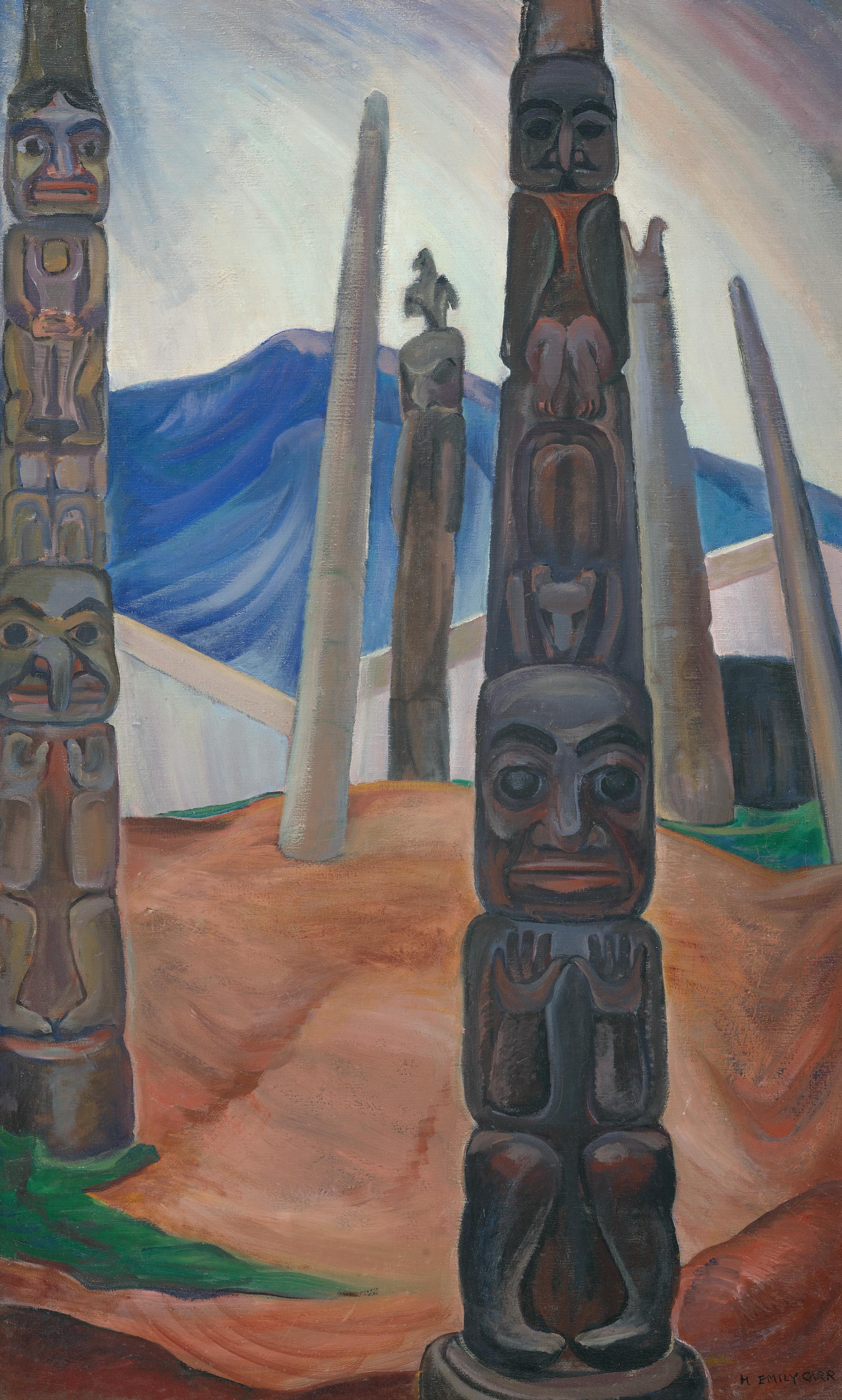
We extend our thanks to curator and art historian, Ian Thom, for his assistance in researching this artwork and for contributing the preceding essay.
$1,000,000–$1,500,000
COWLEY ABBOTT | An Important Private Collection of Canadian Art - Part II - Spring 2023 21
ALEXANDER YOUNG JACKSON
Le Boulanger, Baie-Saint-Paul, circa 1925 oil on canvas signed lower left 21 ins x 26 ins; 52.5 cms x 65 cms
PROVENANCE
Acquired from the artist by N. D. (Jack) Young, Toronto by 1953 Mrs. Linda Wilson, Toronto, by descent Acquired by the present Private Collection through Christopher Varley, Toronto, April 1998
EXHIBITED
A.Y. Jackson Paintings 1902-1953, Art Gallery of Toronto, travelling to the National Gallery of Canada, Ottawa, October 1953‒January 1954, no. 41 as circa 1925
A.Y. Jackson: The Canadian Landscape, London Public Library and Art Museum, 29 January‒20 February 1960, also shown as A.Y. Jackson A Retrospective Exhibition , Art Gallery of Hamilton, March‒April 1960, no. 86
LITERATURE
A.Y. Jackson, Baie‒Saint‒Paul, to Florence Clement, 16 March [1923] and 10 January [1924]; McClelland & Stewart Ltd., Toronto to A.Y. Jackson, Westmount, 16 January 1924; memo to Mr. McClelland, 10 April 1924 and Jack McClelland to A.Y. Jackson, Toronto, 21 October 1924, all in Naomi Jackson Groves fonds, Library and Archives Canada, Ottawa (MG30 D351, Box 95, files 11 & 12, and Box 91, file 5)
A.Y. Jackson, Baie‒Saint‒Paul, to J.E.H. MacDonald, 12 January 1924, in J.E.H. MacDonald fonds, Library and Archives Canada, Ottawa (MG 30 D111, vol. 1-2a)
A.Y Jackson, Baie-Saint-Paul to Norah Thomson, Toronto, 16 January [1924] in Norah de Pencier Fonds, Library and Archives Canada, Ottawa (MG 30 D322, vol. 1)
Adjutor Rivard, translated by W.H. Blake, Chez Nous (Our Old Quebec Home), Toronto, 1924
A.Y. Jackson Paintings 1902-1953, Toronto, 1953, plate 10 reproduced
Jean Burness, Alan Suddon, Grace Pincoe, “A.Y. Jackson,” in Who’s Who in Ontario Art, Part 19, Section 2 (May 1954) and Part 21 (August 1954), unpaginated
A.Y. Jackson, A Painter’s Country: The Autobiography of A.Y. Jackson , Toronto, 1958, pages 54, 59‒60
Jennifer Davidson, A.Y. Jackson: On a Personal Note. Letters A.Y. wrote to my Grandfather 1949-1969, Blurb, 2014, pages 53‒54, reproduced
Beginning in late February 1921, and for more than two decades, A.Y. Jackson explored the many topographies and villages of the Lower Saint Lawrence. He first visited Baie-Saint-Paul on the north shore in 1923, writing from the Hotel Victoria to his cousin Florence Clement in Kitchener on 16 March. “It’s snowing in Baie St. Paul. It seldom seems to stop and soon there won’t be anything to paint but snow. The fences have all disappeared and the houses are piled up till they look like mushrooms. It’s almost impossible to get around. .… The village is rather fine. New church, very awful architecture replacing a fine old one, and a lot of gaily painted houses but rather hard to compose. … I have to fill up 50 panels before I leave here.”
The following year Jackson returned to Baie-Saint-Paul and on 12 January he wrote to J.E.H. MacDonald in Toronto. “Here we are in Christmas card country, at least it looks that way very often. I see cards all waiting to be done;” and four days later to Norah Thomson, book buyer for the T. Eaton Company stores. “Just a line as I am going out to make some pencil notes for Chez Nous. I have not done much yet but have a lot of it in my head and can visualize the completed book and you advising everyone to buy it next autumn. I hope you won’t loose your reputation through it. … Lots of snow - always more of that here. It just looks like last winter except that the houses that had new paint have faded, thank the lord for Canadian paint.”
In Le Boulanger, Baie-Saint-Paul, the closely-knit houses are arranged across the canvas in a palette of mauves, blues, oranges, browns, reds and yellows. The bright red sleigh of the baker accentuates the foreground. The flattened arrangement of houses and shallow recession create a superbly decorative composition with a sentiment of intimacy that sets it apart from Jackson’s other Quebec canvases.
Le Boulanger, Baie-Saint-Paul was clearly conceived at the same time as Jackson’s illustrations for W.H. Blake’s translation of Adjutor Rivard’s book Chez Nous, published in 1924. A drawing in the book of smoke rising from chimneys above the snow-covered rooftops of the village has the same intimacy as the painting. Chez Nous was a project suggested by Clarence Gagnon who lived and worked in Baie-SaintPaul, most likely during Jackson’s visit in 1923, as McClelland and Stewart did not commit to publication until January 1924. Jackson
A.Y. Jackson
Studies of Horses and Covered Sleigh, 1923 graphite on paper, 21 x 12.7 cms Gift of Dr. Naomi Jackson Groves McMichael Canadian Art Collection 1984.17.5 Not for sale with this lot
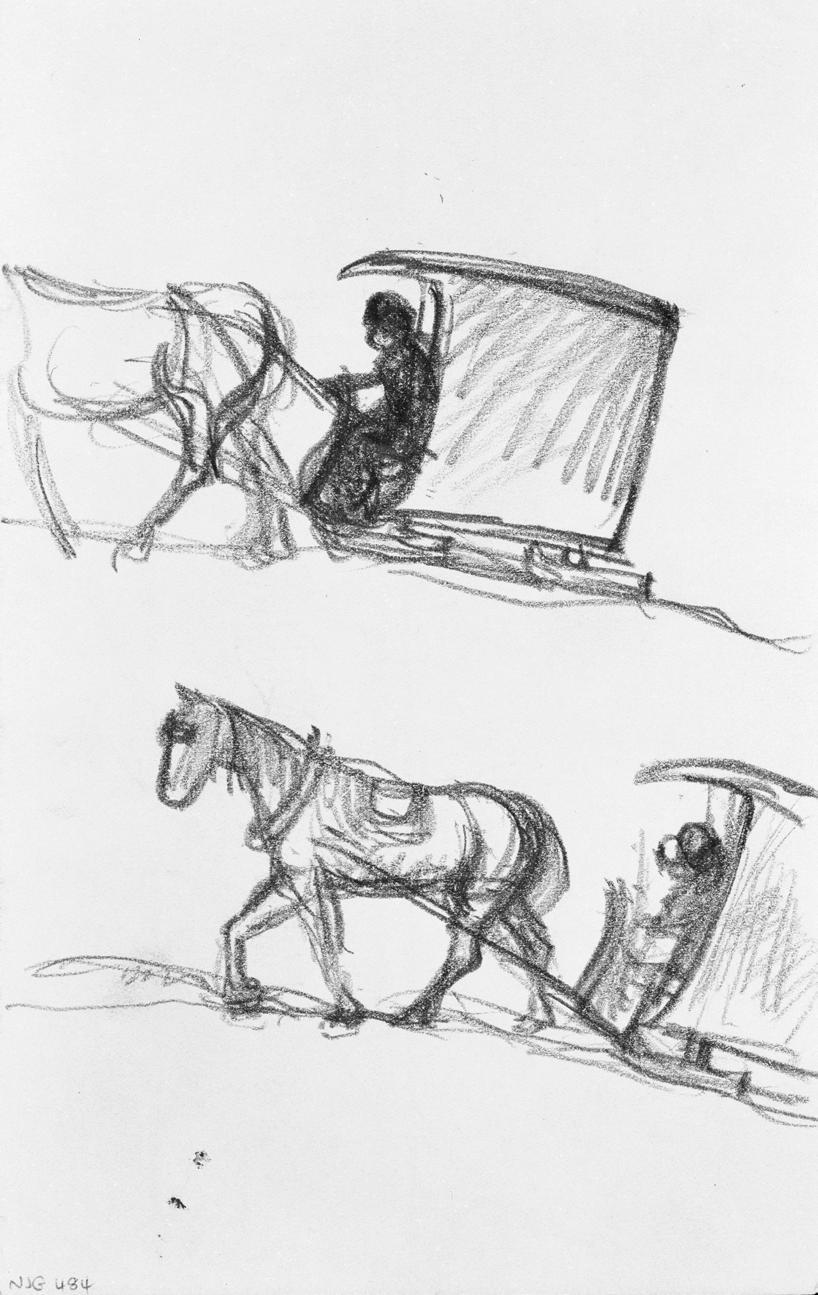
COWLEY ABBOTT | An Important Private Collection of Canadian Art - Part II - Spring 2023 22
109
produced drawings for the cover and end papers as well as eleven chapter headings that were printed as full page illustrations, much to Jackson’s annoyance when the book was first printed in October 1924. As Jackson later noted the book was a great success, for in three months the publishers issued three printings.
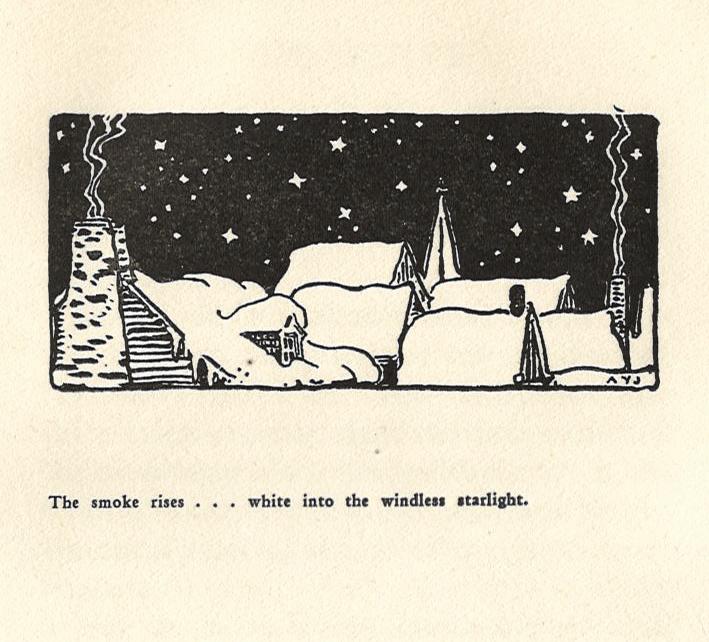
No preparatory oil sketch for this canvas has been located but the McMichael Canadian Art Collection has a wonderful rapid sketch of the baker’s sleigh. Nor has it been possible to surely identify this painting with any of the many Quebec village canvases Jackson exhibited in the twenties. The grand-daughter of Jack Young, Jackson’s financial manager and friend and the previous owner of this painting, has recounted that it was found neglected in Jackson’s studio, purchased by Young and hung in his home some time in the 1940s.
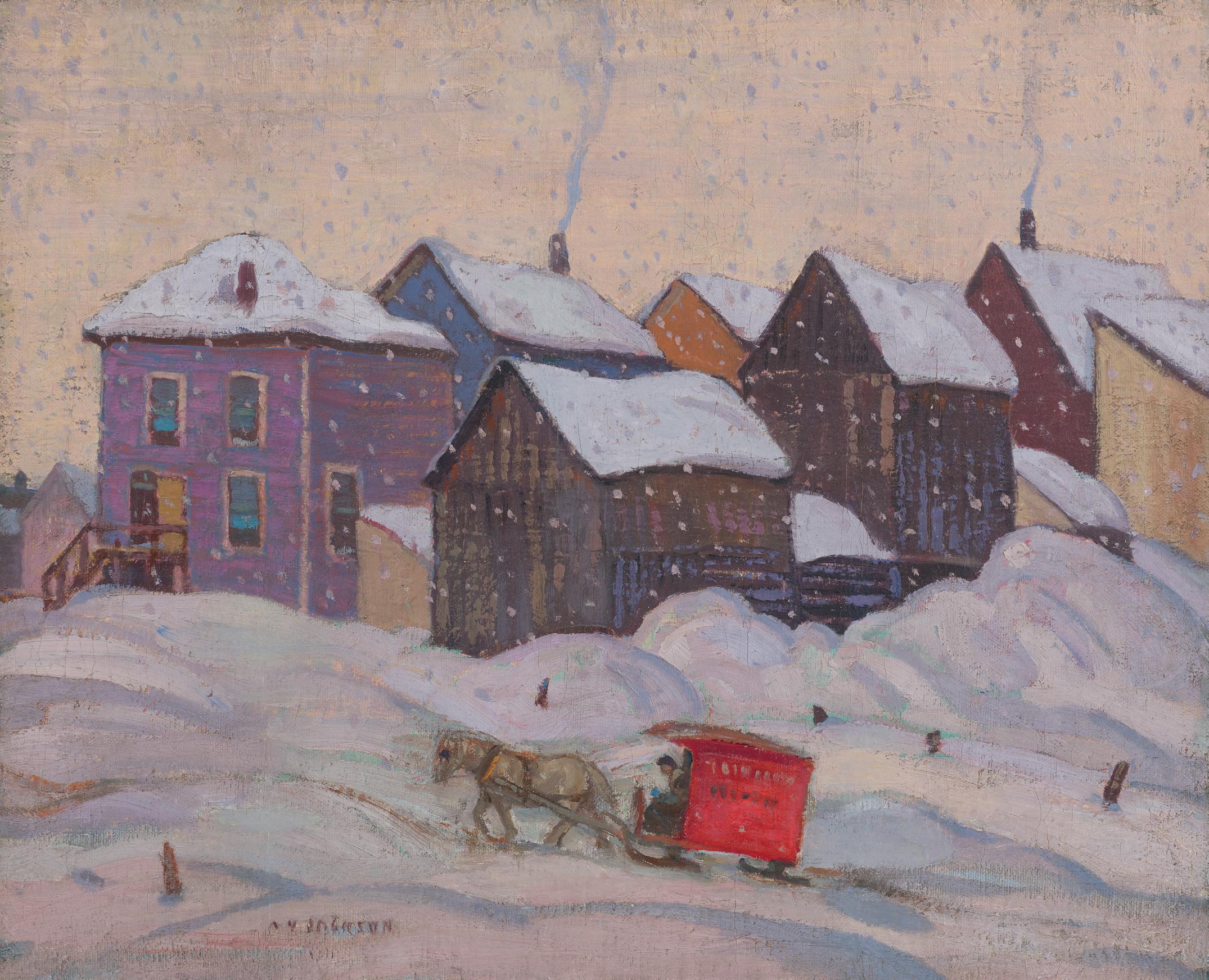
We extend our thanks to Charles Hill, Canadian art historian, former Curator of Canadian Art at the National Gallery of Canada and author of The Group of Seven‒Art for a Nation , for his assistance in researching this artwork and for contributing the preceding essay.
$200,000–$300,000
COWLEY ABBOTT | An Important Private Collection of Canadian Art - Part II - Spring 2023 23
Adjutor Rivard, Chez Nous Toronto, 1924 Not for sale with this lot
HENRY SANDHAM
Low Tide, Murray Bay
oil on canvas
signed and dated 1884 lower right; inscribed “Murray Bay/Hy Sa…/Low Tide” on a label on the stretcher on the reverse 20 ins x 34 ins; 50 cms x 85 cms
PROVENANCE
Hollis-Taggart Galleries, New York
Pierce Galleries, Boston, 2007
A.K. Prakash & Associates, Inc., Toronto, 2007
Acquired by the present Private Collection, 2009
EXHIBITED
Fifth Annual Exhibition of the Royal Canadian Academy of Arts, Art Association of Montreal, 15 April‒4 May 1884, no. 10 as Low Tide at $150
Twelfth Annual Exhibition of the Ontario Society of Artists, Society’s Galleries, Toronto, from 17 May 1884, no. 31 as Low Tide at $150
Embracing Canada: Landscapes from Krieghoff to the Group of Seven , Vancouver Art Gallery, travelling to the Glenbow Museum, Calgary; Art Gallery of Hamilton, 30 October 2015‒25 September 2016
Our Children: Reflections of Childhood in Historical Canadian Art, Varley Art Gallery, Markham, Ontario, 13 April‒23 June 2019
LITERATURE
George W. Beers, “Canadian Sports” Scribner’s Monthly, vol. XIV, (August 1877), pages 506-527, illustrated by Sandham
“The Canadian Art Association,” The Witness (Montreal) 11 April 1880
George M. Grant, “The Dominion of Canada,” Scribner’s Monthly, vol. XX (May-August 1880) pages 80‒95, 241‒256, 433‒449, 553‒568, illustrated by Sandham
“Ontario Society of Artists, The Globe (Toronto), 20 May 1884, page 2 Annie Fréchette, “Summer Resorts on the Saint Lawrence,” Harpers New Monthly Magazine, 69:410 (July 1884), pages 197-209, illustrated by Sandham
Dennis Reid, "Our Own Country Canada”: being an account of the national aspirations of the principal landscape artists in Montreal and Toronto 1860-1890, Ottawa, 1979, pages 92-94, 112-117, 185-189, 352-360
Christine Boyanoski, “Figures in the Landscape en plein air,” in Ian Thom, et al., Embracing Canada: Landscapes from Krieghoff to the Group of Seven , Vancouver, 2015, pages 61, 203, reproduced pages 64-65 François Tremblay, David Mendel, Judy Bross, Charlevoix, une tradition d’acceuil, Québec, 2018, reproduced page 20
A native of Montreal, Henry Sandham first exhibited at the Art Association of Montreal in 1865, the year he married Agnes Fraser, sister of the artist John A. Fraser. He was employed by the photographer William Notman from 1864, becoming a partner in Sandham & Notman from 1877 to 1882. That same year, 1877, he was commissioned to prepare illustrations on Canadian subjects for the American periodical Scribner’s Monthly, for which he would also illustrate four Canadian articles by George Munro Grant in 1880. While active as a photographer and illustrator, Sandham also
exhibited with Montreal’s Society of Canadian Artists from 1868, with the Ontario Society of Artists from 1874, and was appointed a charter member of the Canadian Academy of Arts in 1880. At the first annual meeting of the Academy on 6 March 1880 he submitted a diploma painting, Beacon Light, St. John Harbour, as required by all academicians, to be deposited in a still to be realized National Gallery. On 11 April it was announced that he was moving to Boston.
Sandham continued to be a prolific illustrator of articles of both Canadian and American subjects and in July 1884 his illustrations for the article “Summer Resorts on the Saint Lawrence” by the Ottawa writer Annie Fréchette were published in Harper’s New Monthly Magazine. Approaching Murray Bay by steamer, “[f]ive hours after leaving Quebec, symptoms of an important landing begin to be visible amongst the majority of Canadians on board …. The tourist … moves his chair to the land side of the deck, and calmly takes in the grandeur of the hills which rise almost sheer from the water at the wharf of Murray Bay,” wrote Fréchette. “Struck by the simplicity of the accommodation at Murray Bay, she continued: “There are no costly toilets displayed. The dressing is simple, and entirely appropriate to the place and its requirements, which are rather those of the country town grown into popular favour, and crowded with ‘summer boarders,’ … Murray Bay impresses one as being managed on strictly economical principles. Prices are kept down by its habitual visitors, as neither French nor English Canadians are, as a rule, given to lavish expenditure… So strongly is the spirit of conservatism intrenched here that the same families come year after year from Quebec, Montreal, and even Toronto, to occupy the same rooms or cottages. …There are always a few Americans to be found summering here, generally of a class seeking rest and quiet rather than gayety. They certainly do not come for the bathing, as the mere mention of it sets them shivering. Even amongst the Canadians, who can stand such cold baths, I found that bathing was the exception rather than the rule…. The children get over the difficulty of coldness by one of the happy expedients of quick-witted childhood. They appropriate the deep hollows in the great rocks along the beach, which the ebbing tide has left brimful of water, tempered to a pleasant warmth by the sun. In these natural bath-tubs they splash and frolic about to their hearts’ content. They patter over the rocks in their bare feet, dripping garments and high-peaked straw hats, rosy and happy, and are delightfully quaint little pictures.”
This romantic account of summering at Murray Bay (La Malbaie) could well describe this painting by Henry Sandham, undoubtedly conceived during the summer of 1883 when he visited to prepare illustrations for Fréchette’s article. A mother and grandmother sit knitting and crocheting on a rock, while the children’s nurse appreciates the moment of reprieve and admires the distant hills. Three young girls play in the sand by the shores of the Malbaie River. It is a bucolic image enlivened by the brilliant colouring as noted by the writer in Toronto’s Globe when it was exhibited with the Ontario Society of Artists in May 1884. “‘Low Tide ’ by Mr. Sandham is a very quiet subject, treated with all that delicacy of feeling and happy effects in atmosphere for which the artist is noted. The colouring is enlivened by the bright wraps cleverly associated with the figures in the foreground. Altogether the picture is a singularly pleasing one.”
We extend our thanks to Charles Hill, Canadian art historian, former Curator of Canadian Art at the National Gallery of Canada and author of The Group of Seven‒Art for a Nation , for his assistance in researching this artwork and for contributing the preceding essay.
$60,000–$75,000
COWLEY ABBOTT | An Important Private Collection of Canadian Art - Part II - Spring 2023 24 110

COWLEY ABBOTT | An Important Private Collection of Canadian Art - Part II - Spring 2023 25
PELEG FRANKLIN BROWNELL
Tea Time
oil on canvas laid on board signed and dated 1901 centre left, signed and dated 1901 upper right
15.5 ins x 11.5 ins; 38.8 cms x 28.8 cms
PROVENANCE
A.K. Prakash & Associates, Inc., Toronto
Acquired by the present Private Collection, May 2011
EXHIBITED
Canada and Impressionism: New Horizons 1880-1930, National Gallery of Canada, Ottawa; travelling to Kunsthalle der Hypo‒Kulturstiftung, Munich; Fondation de l’Hermitage, Lausanne; Musée Fabre, Montpellier, 19 July 2019‒3 July 2021, no. 64
LITERATURE
Jim Burant and Robert Stacey, North by South: The Art of Peleg Franklin Brownell, 1857-1946, Ottawa Art Gallery, 1998, pages 29, 73, 82‒84
Katerina Atanassova, Canada and Impressionism: New Horizons 1880 ‒1930, Ottawa, 2019, no. 64, reproduced page 188 as Tea Time
This exquisite portrait of his wife Louise by the Massachusetts-born Franklin Brownell, and who trained as an artist in Boston and Paris, is entitled Tea Time, although it bears no inscription nor does it have an early exhibition history. Brownell’s long career as a Canadian artist was for decades forgotten or dismissed by art historians. But in the past few decades, his contributions to Canadian art have come to be more deeply appreciated as scholars recognized his work as a Canadian Impressionist. He has been included in several major surveys on the subject, in 1995 (Lowrey et. al.), 2015 (Prakash), and most recently in the Canada and Impressionism: New Horizons exhibition organized by Katerina Atanassova of the National Gallery of Canada in 2019, as well as having a major retrospective at the Ottawa Art Gallery in 1998.
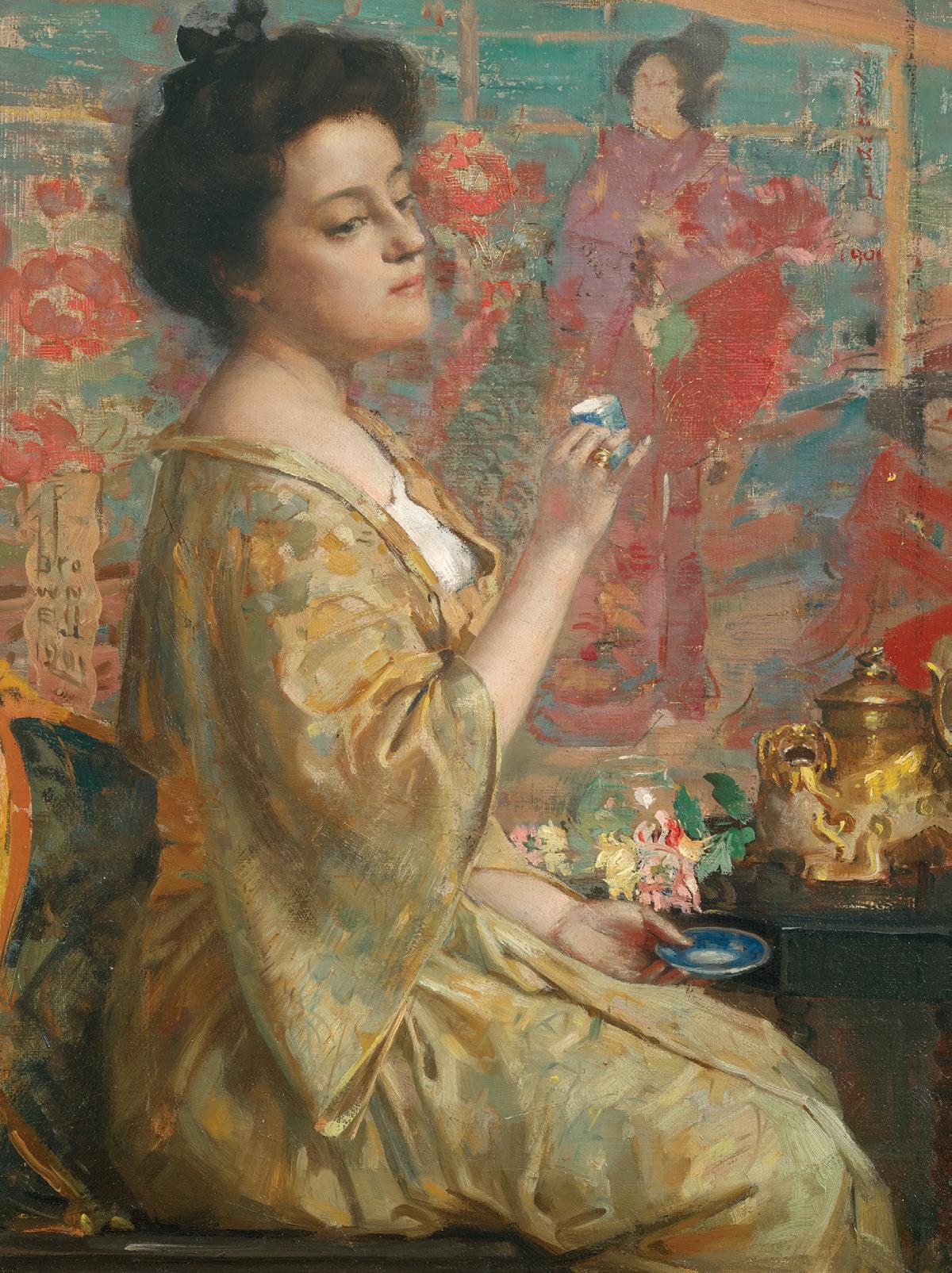
As early as 1888, John W. H. Watts, acting curator of the National Gallery of Canada from 1882 to 1897, had written to artist Homer Watson that: “Brownell … has a faculty of getting light all through his work and more poetic”. A critical reviewer of the 1892 RCA exhibition described his work using the terms “Impression” and “tonal pensiveness”. Soon after he arrived in Canada in 1887, Brownell had already begun to push the limits of Canadians’ acceptance of more advanced international art movements. Canadian art lovers remained extremely conservative for a long period of time. The National Gallery of Canada only acquired a work by Claude Monet or any other Impressionist artist until 1914, while the Montreal Museum of Fine Arts acquired its first Monet in 1918, and the Art Gallery of Toronto (now the AGO) did not own a Monet until 1929. Modernism took a long time to be accepted in Canada, but Brownell was among the first to try and gain acceptance for new directions in artistic endeavour.
Here, two different aspects of Brownell’s work in relation to wider international developments appear. The choice of subject matter, the tea set, and the firescreen in the background all reflect the influence of “Japonisme”, linking him to such diverse artists as Edouard Manet, Alfred Stevens, James MacNeill Whistler, and James Tissot. This is likely one of Brownell’s earliest essays in the style, but he seems not to have exhibited it publicly, although a later work, The Blue Kimono, appeared at the Art Association of Montreal spring exhibitions in 1905 and 1906. Brownell’s work also reflects a theme in American Impressionism, the image of women, which art historian W.G. Gerdt noted was “the one most acknowledged and discussed in the critical literature”. In this work, Brownell echoes the work of many of his American contemporaries, including Frank Benson, Edmund Tarbell, and Thomas Eakins, as well as Canadian counterparts, including George Agnew Reid, William Brymner, and Frederick S. Challener. Although Brownell had built a reputation as a portrait painter, he rarely painted women, with the exception of his wife and daughter, who acted as his models for many such genre pieces.
We extend our thanks to Jim Burant, art historian and curator, for contributing the preceding essay. He spent four decades with the art and photo holdings of Library and Archives Canada. He has organized or co‒organized many exhibitions and has written and lectured widely about aspects of Canada’s visual heritage, his most recent publication being about the History of Art in Ottawa, published by the Art Canada Institute. He was awarded the Queen’s Golden Jubilee Medal for services to Canada in 2002, and is a member of the Algonquins of Pikwàkanagàn First Nation.
$12,000–$15,000
COWLEY ABBOTT | An Important Private Collection of Canadian Art - Part II - Spring 2023 26 111
112
MARC-AURÈLE DE FOY SUZOR-COTÉ
Still Life with Pears oil on canvas signed and dated 1897 lower right 12 ins x 20 ins; 30 cms x 50 cms
PROVENANCE
Galerie Walter Klinkhoff, Montreal Private Collection
EXHIBITED
Marc-Aurèle de Foy Suzor-Coté, Retrospective Exhibition , Galerie Walter Klinkhoff, Montreal, 13-27 October 2018, no. 28
In his still lifes, Marc-Aurèle de Foy Suzor-Coté was primarily interested in exploring the duality between the ideal representation of everyday subjects and the affirmation of the art of painting. The painterly qualities of his works reflect his experiments in both style and composition, which he undertook in the early 1890s as a promising young artist, like so many of his French-Canadian contemporaries who made the pilgrimage to Paris to further their artistic training.
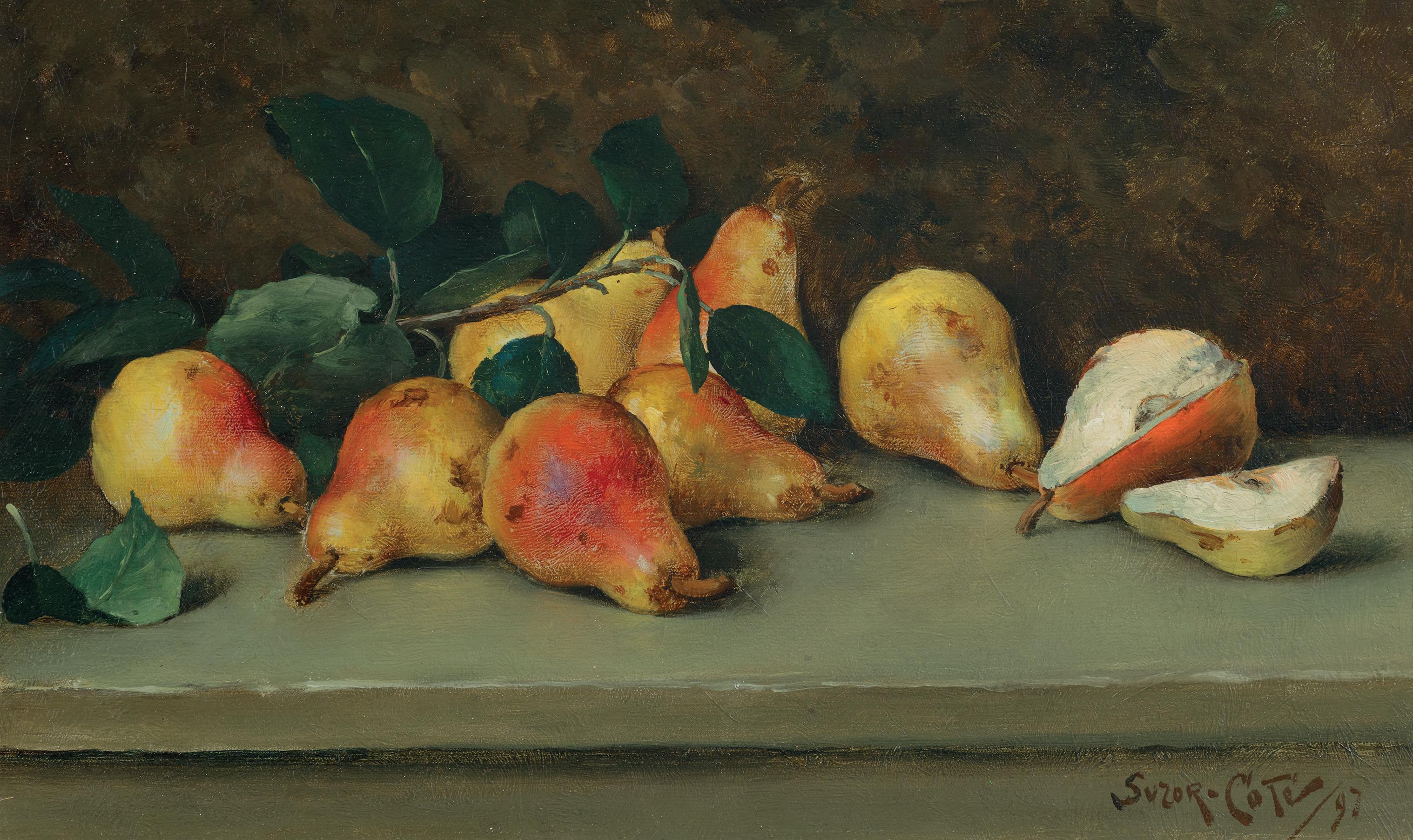
Presenting a vibrant arrangement of squat, round pears set on a ledge against a sombre background, Suzor-Coté achieved the illusion of ripe fruits by juxtaposing yellow tones with a blush of orange and rendering the texture of wrinkled skin through freely applied brush strokes. As in many other paintings of the period, the artist scraped the pictorial layer to create texture and depth in the background before using his palette knife to trace the distinctive contours of the pears. While the illusion is mesmerizing from a distance, upon closer inspection, the paint takes on a life of its own. The viewer’s gaze finds itself inevitably drawn to the pearly white cut pieces at the right. It evokes the buttery texture and flavour of a freshly harvested fruit as if it had just recently been plucked from the leafy branch leaning against the ledge.
While Suzor-Coté’s still lifes, ranging from trophy game to floral arrangements, offer faithfully replicated inanimate objects, they also appeal to the viewer’s senses beyond sight, inviting contemplation through sensory perception. Ultimately, by adopting an intense palette of colours and rich textures, the artist emphasizes the ability of art to give the illusion of reality, thus breathing life within simple and often overlooked subjects.
$8,000–$12,000
COWLEY ABBOTT | An Important Private Collection of Canadian Art - Part II - Spring 2023 27
FRANKLIN CARMICHAEL
Autumn Tangle
oil on beaverboard
inscribed “No. 28” with the artist estate stamp verso 9.75 ins x 12 ins; 24.4 cms x 30 cms
PROVENANCE
Estate of the Artist
Galerie Dresdnere, Toronto
S.C. Trono, Toronto
Peter Bronfman, Montreal
Waddington Galleries, Montreal Private Collection
EXHIBITED
Frank Carmichael: Group of Seven, Retrospective Exhibition , Galerie Dresdnere, Toronto, 14‒31 October 1964, no. 28
Collector’s Canada: Selections from a Toronto Private Collection , Art Gallery of Ontario, Toronto; travelling to Musée du Québec, Quebec City; Vancouver Art Gallery; Mendel Art Gallery, Saskatoon, 14 May 1988‒7 May 1989, no. 78
Embracing Canada: Landscapes from Krieghoff to the Group of Seven , Vancouver Art Gallery; travelling to Glenbow Museum, Calgary; Art Gallery of Hamilton, 29 October 2015‒25 September 2016
LITERATURE
Frank Carmichael: Group of Seven, Retrospective Exhibition , Galerie Dresdnere, Toronto, 1964, no. 28, listed
Dennis Reid, Collector’s Canada: Selections from a Toronto Private Collection , Toronto, 1988, no. 78, reproduced page 72
Ian Thom, et. al, Embracing Canada: Landscapes from Krieghoff to the Group of Seven , Vancouver/London, 2015, reproduced page 111
In 1920, Franklin Carmichael became a founder of the Group of Seven landscape painting collective, a moment that marked his first significant recognition as a contributor to modern art in Canada. Beginning in 1912, he had participated in exhibitions of the Ontario Society of Artists (elected 1917), Canadian National Exhibition, and the Royal Canadian Academy of Arts. But, participation in the Group movement with just six other artists versus the huge group-artist society exhibitions, shone a spotlight on his practice that had not been possible before. Showing a total of forty-two works in the first three exhibitions of 1920, 1921 and 1922, visitors to the Art Gallery of Toronto could begin to experience the evolution of an artist. And it was in these early years of the Group’s formation that Carmichael’s artistic voice began to take shape as a masterful colourist and painter of light.
Carmichael had been consistently engaged in plein air sketching in oil since his return from study in Antwerp, Belgium in the fall of 1914. The previous summer on July 14, 1914, Carmichael scurried to Sheffield, England to spend his summer respite from study, residing with the Arthur Lismer family. He narrowly escaped being stuck
in Belgium which Germany had begun to invade on July 24, 1914. Without means to remain in England, and no prospect of returning to Belgium to complete his studies at the Académie Royale des beaux art in Antwerp, Carmichael boarded the HMS Olympic to New York on September 23, amidst the reality of the First World War. On his arrival in Toronto in early October, without work, he promptly set up a lean camp with Tom Thomson in the Shack adjacent to the famous Studio Building. It was that winter that he began painting snow scenes, and gradually, he moved into exploring the other three seasons of the year.
By the time of the 1920 exhibition, Carmichael had resolved that the fall season offered immense painterly possibilities, notably the glorious pageantry of fall colour offered by the changing colours of the deciduous trees‒red, yellows and oranges‒set against the evergreens. He would explore the beauty of fall change for the rest of his landscape painting career. In Autumn Tangle, Carmichael concentrates on these effects in one of his shallowest compositions from this period of his work, similar to his renown easel painting, Silvery Tangle, 1921 (Art Gallery of Ontario) and to the sketch Autumn Foliage against Grey Rock (National Gallery of Canada). While his use of colour is stunning, and dominates the overall impression, the bald rock face in the foreground occupies nearly half of the composition. It was a strategic decision that set the middle ground colours into sharp relief. In the far distance, only a tiny portion of the composition is dedicated to a distant hazy sky. However, it is not truly a hazy day for the lighting in the foreground bears witness to a blast of sunlight from behind the artist to illuminate his subject, resulting in the striking palette of reds, yellows, and oranges.
This warm and joyful sketch is unsigned but bears the estate stamp, proof positive of its larger quality provenance. As well, in the twenties, Carmichael often worked on an incorporated product called Beaverboard, made of compressed fibreboard building materials, a practice consistent with this sketch too. As well, it was included in the Carmichael’s first solo exhibition with a gallerist, Toronto’s
Autumn Foliage Against Grey Rock, circa 1920 oil on wood-pulp board, 25.2 x 30.5 cms Gift of Mary Mastin, Toronto, 1996 National Gallery of Canada, Ottawa Not for sale with this lot

COWLEY ABBOTT | An Important Private Collection of Canadian Art - Part II - Spring 2023 28 113
Franklin Carmichael
Simon Dresdnere; the painting was number 28 in that exhibition, a detail confirmed on the verso of the panel. The Dresdnere exhibition has remained one of the few commercial solo shows in the whole of Carmichael’s posthumous exhibition legacy. Wisely, Dresdnere saw the need for the exhibition to also be a retrospective, drawing on works beginning in the 1920s and continuing to the 1940s. In this context, Autumn Tangle offered gallery visitors an introduction to the artist’s early work of the 1920s.
We extend our thanks to Catharine Mastin, PhD, art historian, curator and Adjunct Member of the Faculty of Graduate Studies in Art History at York University for contributing the preceding essay. Mastin also curated the exhibition Franklin Carmichael: Portrait of a Spiritualist, an exhibition organized by the National Gallery of Canada, Ottawa which toured Canada between 1999 and 2001. $60,000–$80,000
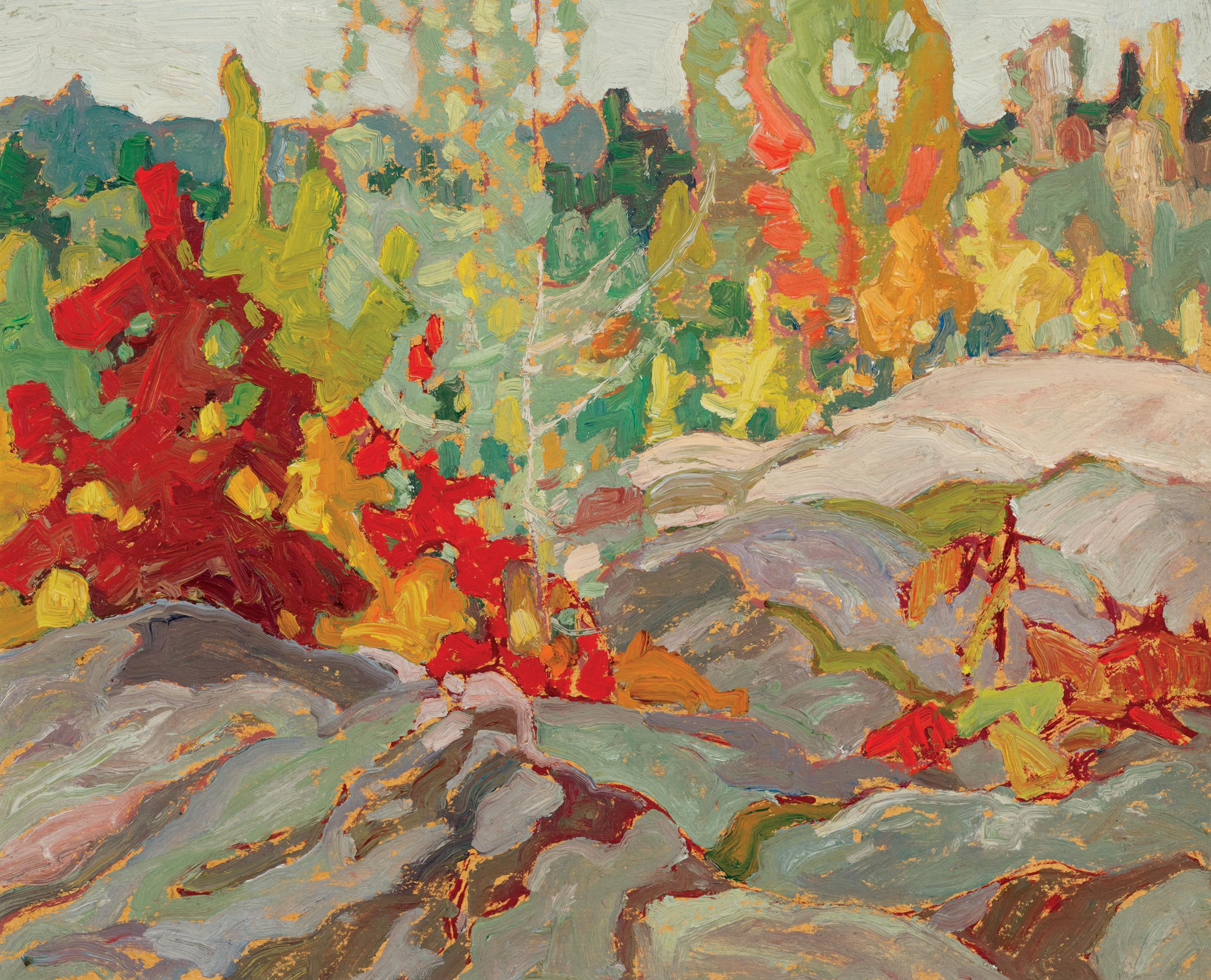
COWLEY ABBOTT | An Important Private Collection of Canadian Art - Part II - Spring 2023 29
DAVID BROWN MILNE
The Black Couch, 1914
oil on canvas
inscribed “David Milne: The Black Couch (1914)” on the stretcher; Milne catalogue raisonné no.105.101 20 ins x 22 ins; 50 cms x 55 cms
PROVENANCE
The Artist
By descent to Mrs. Kathleen Milne, Bancroft, Ontario Picture Loan Society, Toronto
Acquired by the present Private Collection, circa 1967
EXHIBITED
Collector’s Canada: Selections from a Toronto Private Collection , Art Gallery of Ontario, Toronto; travelling to Musée du Québec, Quebec City; Vancouver Art Gallery; Mendel Art Gallery, Saskatoon, 14 May 1988‒7 May 1989, no. 89
David Milne, Modern Painting, Dulwich Picture Gallery, London; travelling to Vancouver Art Gallery, McMichael Canadian Art Collection, Kleinburg, 14 February 2018‒13 January 2019
Collectors’ Treasures/Trésors des collectioneurs, Annual Loan Exhibition , Galerie Eric Klinkhoff Inc., Montreal, 19 October‒2 November 2019, no. 35
LITERATURE
Dennis Reid, Collector’s Canada: Selections from a Toronto Private Collection , Toronto, 1988, no. 89, reproduced page 80
David P. Silcox, Painting Place: The Life and Work of David B. Milne, Toronto, 1996, page 56, reproduced page 58
David Milne Jr. and David P. Silcox, David B. Milne: Catalogue Raisonné of the Paintings, Volume 1: 1882‒1928, Toronto, 1998, listed and reproduced page 126, no.105.101
Sarah Milroy and Ian A.C. Dejardin, David Milne, Modern Painting, Dulwich Picture Gallery, London, 2018, reproduced page 56
David Milne’s profound differences from most of his Canadian contemporaries‒especially Tom Thomson and the Group of Seven‒announce themselves powerfully in the early though supremely confident painting The Black Couch. Though he would later be known and admired as a landscape painter in both the USA and Canada, he did not begin in that mode. Born in Bruce County in rural southwestern Ontario, at age 21, the ever-courageous Milne enrolled at the progressive Arts Students’ League in New York City (1903-05) and stayed in the metropolis until 1916, when he moved to Boston Corners in New York State. Milne joined the Canadian Army in 1917 and returned to the USA afterwards. David and Patsy Milne moved back to Canada permanently in 1929.
In The Black Couch, we see some of what Milne learned about the then‒radical, modernist tendencies of the American Ashcan School‒also called ‘The Eight’‒European Impressionism, Post-Impressionism, and Fauvism, movements that would underpin his own unique painting style. The figure here is his wife Patsy, shown in the small front room of a store near the cottage they had rented up the Hudson River from New York in the summer of 1914. The multi‒colored treatment of her face suggests the impact of Matisse and other Fauve painters on Milne’s sensibility. Milne had shared the limelight with Matisse in the famous Armory Exhibition of 1913. The only Canadian in this now famous exhibition of the avant-garde in the USA, Milne contributed five paintings.
Generically, the portrait is intimate; it also resonates with the early 20th-century European art movement of Intimism, championed especially by Edouard Vuillard and Pierre Bonnard. The visual vibrancy of the closely integrated surface is achieved by vibrant accents in red, orange, and blue leaping out from the darker hues, all animated by significant areas of off-white, unpainted canvas. Always one to set himself an aesthetic challenge, Milne delineates Patsy’s form even though she sits on a black sofa in a black dress. She both appears and disappears.
The Black Couch is a painting about painting, a work by a bold artist. Milne had every reason to be confident at this time. By circa 1910, his work was exhibited regularly and reviewed approvingly in the New York press. Thinking about the legacy of Milne’s work as early as 1912, a reviewer in the New York Times wrote, “We fancy that the truth lovers and truth haters of tomorrow will alike see in such pictures as these brisk little paintings by Mr. Milne a genuine effort toward individual research in the wide field of art, an effort toward cutting loose from formulas that have served for twenty or more years…”. Again, like Matisse, with The Black Couch Milne provides us with the visual means not only to take pleasure in what we see but also to ponder what representation is. On the left and right of this picture we glimpse two other framed paintings. Between them are what look like decorated plates, flowers, and possibly a mirror. All forms are embedded in a democratizing mesh of marks and colours. Significantly, the sitter is not named here. Instead, she is part of a shifting web of colour and form, part of an animate still life more than a traditional portrait.
Mark A. Cheetham is a freelance writer and curator and a professor of art history at the University of Toronto. He is author of Abstract Art Against Autonomy: Infection, Resistance, and Cure since the '60s (Cambridge University Press).
$300,000–$400,000
COWLEY ABBOTT | An Important Private Collection of Canadian Art - Part II - Spring 2023 30 114

COWLEY ABBOTT | An Important Private Collection of Canadian Art - Part II - Spring 2023 31
WILLIAM BLAIR BRUCE
Picking Pears in Barbizon (The Pear Orchard), 1882
oil on canvas
signed and dated 1882 lower left
29.5 ins x 59 ins; 73.8 cms x 147.5 cms
PROVENANCE
Sotheby’s, auction, Toronto, 2 October 1974, lot 14
G. Blair Laing Ltd., Toronto
Mr. & Mrs. Kenneth R. Thomson, Toronto
A.K. Prakash & Associates, Inc., Toronto
Acquired by the present Private Collection, August 2005
EXHIBITED
Royal Academy, London, 1883, no. 1476
Autumn Exhibition , Walker Art Gallery, Liverpool, 1883, no. 360
Forging the Path: The Forerunners (1870-1920), McMichael Canadian Art Collection, Kleinburg, 2 October 2010‒30 January 2011 as Picking
Pears, Giverny
Into the Light: The Paintings of William Blair Bruce (1859-1906), Art Gallery of Hamilton; traveling to Owens Art Gallery, Sackville, 24 May 2014-5 April 2015, no. 11
Embracing Canada: Landscapes from Krieghoff to the Group of Seven , Vancouver Art Gallery; traveling to Glenbow Museum, Calgary; Art Gallery of Hamilton, 29 October 2015‒25 September 2016
Canada and Impressionism: New Horizons 1880‒1930, National Gallery of Canada, Ottawa; travelling to Kunsthalle der Hypo‒
Kulturstiftung, Munich; Fondation de l’Hermitage, Lausanne; Musée
Fabre, Montpellier, 19 July 2019‒3 July 2021, no. 2 as Picking Pears in Barbizon (The Pear Orchard), 1882
LITERATURE
Joan Murray, ed., Letters Home 1859-1906: The Letters of William Blair Bruce, Moonbeam, Ontario, 1982
Katerina Atanassova, Forging the Path: The Forerunners (1870-1920), Kleinburg, 2010, reproduced page 5 as Picking Pears, Giverny Tobi Bruce, ed., Into the Light: The Paintings of William Blair Bruce (1859-1906), Art Gallery of Hamilton, 2014, pages 70‒71, reproduced page 53
A.K. Prakash, Impressionism in Canada: A Journey of Rediscovery, Stuttgart, 2015, plate 7.1
Ian Thom, ed., Embracing Canada: Landscapes from Krieghoff to the Group of Seven , Vancouver/London, 2015, page 60, reproduced page 64
Katerina Atanassova, Canada and Impressionism: New Horizons, 18801930, Ottawa, 2019, no. 2, pages 236, 248, reproduced page 143
William Blair Bruce studied art privately in his native Hamilton with his father (an amateur watercolourist), with John Herbert Caddy and with Henry Martin. He then briefly attended the Hamilton Art School before traveling in mid-1881 to Liverpool, en route to Paris, where he arrived in July. Like many other North American students, in the French capital he enrolled at the Académie Julian, and there he received instruction from the popular academic painter Tony Robert-Fleury. Bruce stayed at the Académie for only the autumn 1881 session, however, leaving Paris in January 1882 for the more affordable village of Barbizon, just south of the city and on the edge of the Forest of Fontainebleau. Jean-François Millet and Théodore Rousseau, two of the Barbizon School’s most influential figures, had settled in the village in the late 1840s, and by 1882 it was a pilgrimage site for painters attracted by the original Barbizon artists’ naturalistic, unromanticised depictions of the local landscape and rural life. Bruce was enchanted with the area. He remained based in Barbizon for most of the next four years, until the autumn of 1885, when financial desperation and the emotional distress resulting from his failure to establish a major reputation for himself in Paris, sent him back to Hamilton for a year of recuperation.
The Pear Orchard is one of Bruce’s earliest large surviving canvases. Its width‒just under five feet‒reflects the recommendation of Louis Welden Hawkins, an English painter who met Bruce in Paris and who in the spring of 1882 gave the ambitious and self-confident Canadian artist guidance on maximizing his chances of success at the Paris Salon. “[H]e advised me to take a couple of ‘six foot’ canvasses [sic] and make a bold strike for notoriety (or whatever you like to call it),” Bruce wrote to his mother and grandmother on March 25th. “He says it is the only way to become famous in a short time….” Hawkins had himself won a coveted Salon medal, and so knew from personal experience how popular large, often sentimental genre paintings of picturesque peasants, winsome children, or juxtaposed elderly and youthful figures were with Salon juries and audiences. Bruce accordingly settled in to paint the kinds of Salon‒friendly pictures that Hawkins had suggested. An important example for him, as for other artists not ready or willing to embrace the more radical techniques of the impressionist artists (who had staged the first of their group exhibitions eight years earlier, in 1874), was Jules Bastien-Lepage, whose immensely popular juste milieu depictions of country dwellers combined a contemporarylooking plein air freshness with a solid academic approach. That combination of qualities would echo through Bruce’s art for the rest of his career.
In the same March 25th letter in which he first mentioned Hawkins, Bruce was jubilant about a recent change in his palette, which “only consists … of fifteen colors, sometimes perhaps eighteen, and I have discarded almost altogether that former bane of my existence, BLACK PAINT and I now live in a dreamy dreamy world of color…. I have joined the hopeful band who detest darkness and earnestly turn their thoughts and actions towards the light … I feel my heart thrill, like a freed bird, and I cannot help but offer thanks to The Great Giver, of that, which lets me see the real beauties of this universe…."
COWLEY ABBOTT | An Important Private Collection of Canadian Art - Part II - Spring 2023 32 115
The Pear Orchard , begun sometime in the summer of 1882 and completed in time for exhibition at the Royal Academy in London the next year, is an effective expression of those qualities. It combines a warm plein air naturalism, a subtle tonalist treatment of a circumscribed range of subdued colours melting into each other, and a general suppression of detail. The three casually posed children are crucially placed compositional elements: points of psychological interest in the loosely painted meadow. The two seated figures act as anchors at the centre of the canvas, while their standing companion reinforces the contrasting verticality of the tree by which he stands. He looks up into the tree’s branches and leaves, which in turn blend into a cross‒canvas horizontal play of green that parallels the soothing horizontality of the meadow itself. The Pear Orchard hints at the more

overtly impressionist elements that would appear in Bruce’s paintings made at Giverny in the later 1880s. But in the warmth of its response to its subject, its open-air freshness, and its pleasingly manipulation of an expanse of colour and light that envelops and unifies the entire scene, The Pear Orchard exemplifies the charm and emotional accessibility of Bruce’s earliest work from France.
We extend our thanks to Brian Foss, Carleton University Chancellor’s Professor of Art & Architectural History, and co‒curator of 1920s Modernism in Montreal: The Beaver Hall Group for his assistance in researching this artwork and for contributing the preceding essay.
$70,000–$90,000
COWLEY ABBOTT | An Important Private Collection of Canadian Art - Part II - Spring 2023 33
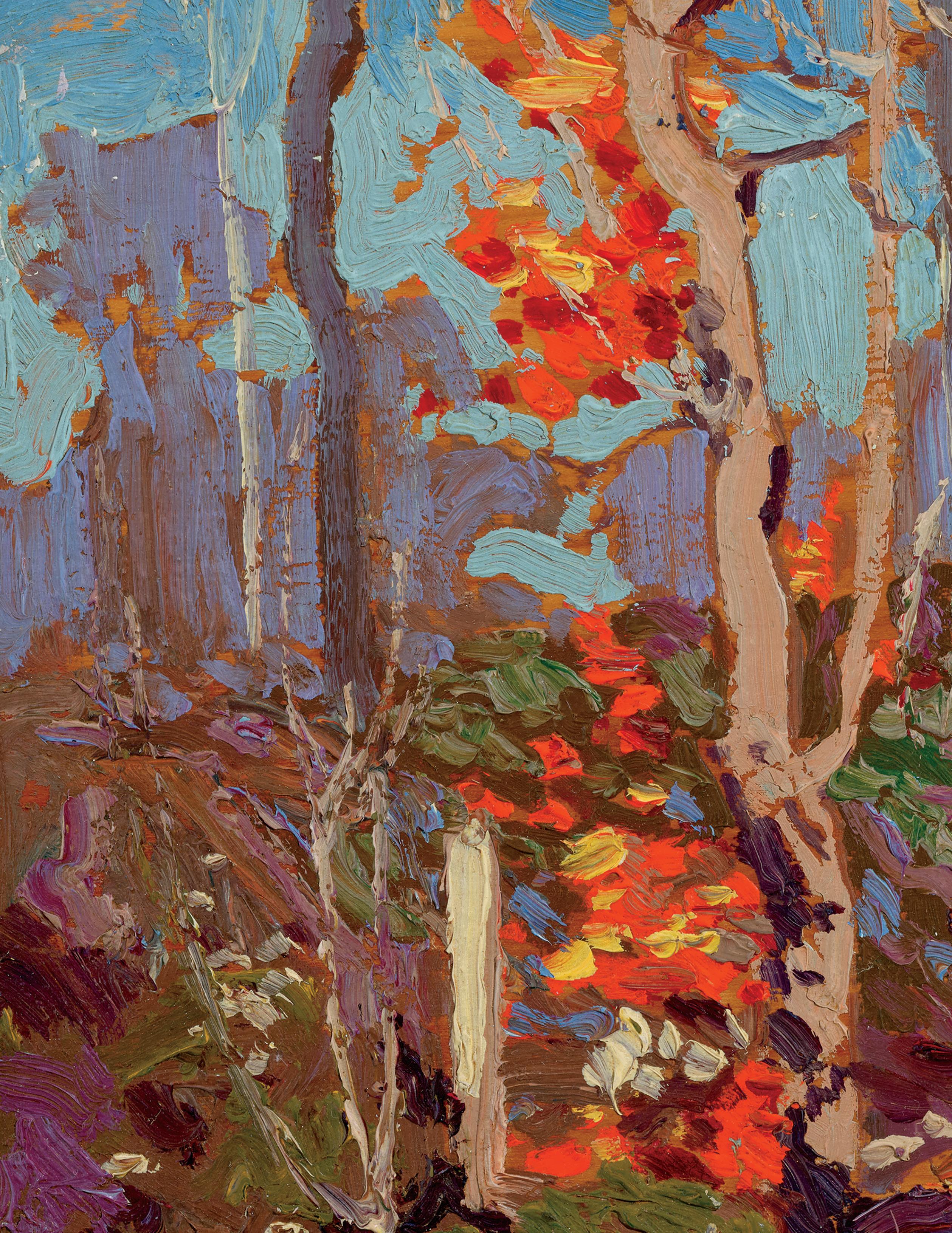
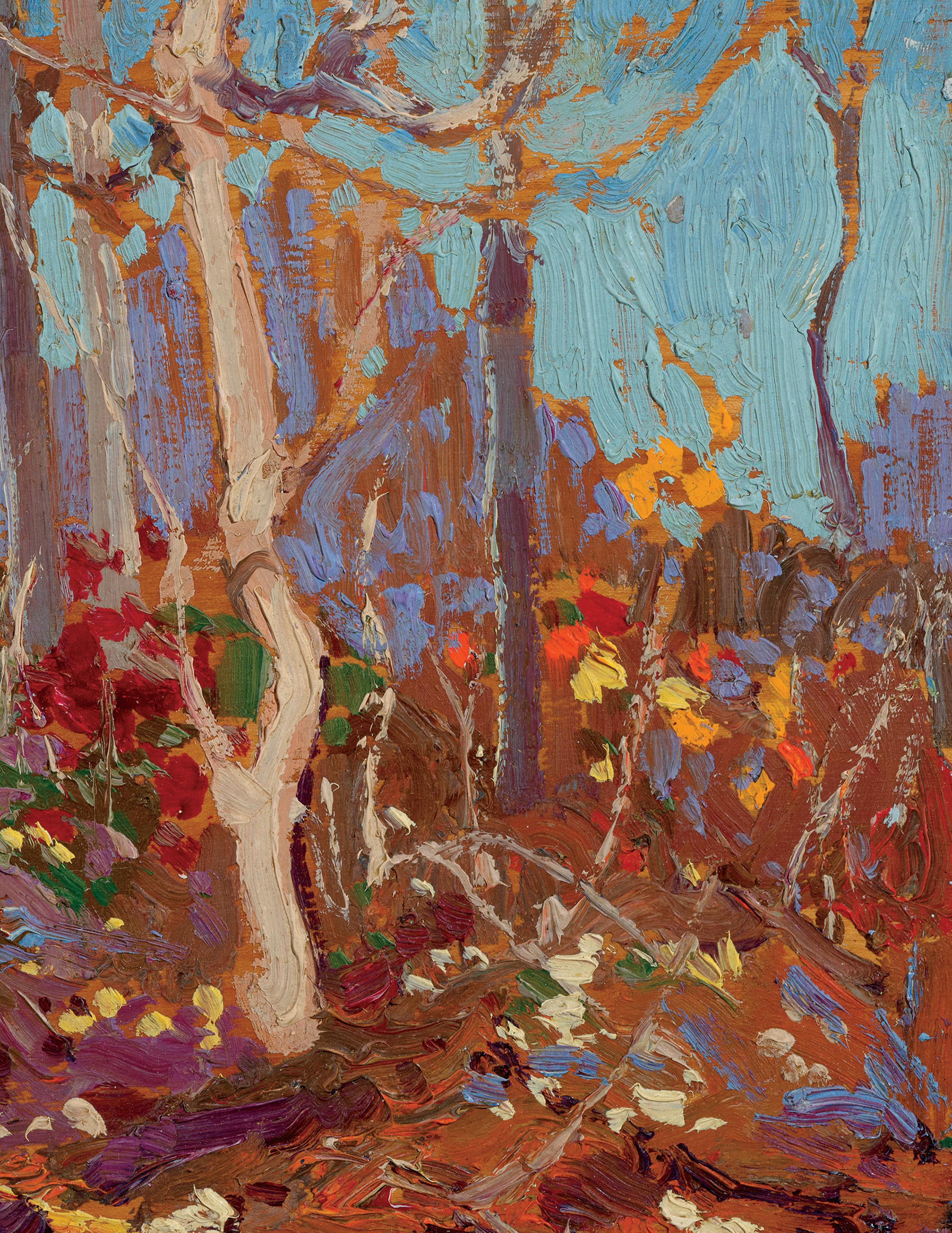
TOM THOMSON
Ragged Oaks, 1916
oil on panel
Estate stamp lower right; Estate stamp and inscribed “M. Thomson”, “134” and “23” on the reverse; inscribed with title, “Not for Sale” and “16” on a label on the reverse
8.5 ins x 10.5 ins; 21.3 cms x 26.3 cms
PROVENANCE
Estate of the Artist
Elizabeth Thomson Harkness, Annan and Owen Sound
Margaret Thomson Tweedale, Toronto
Fraser Thomson, Seattle and Outremont, Quebec
Ina (Mrs. Fraser) Thomson, Seattle, by descent
Acquired by the present Private Collection, 1971
EXHIBITED
An Exhibition of Paintings by the late Tom Thomson , The Arts Club, Montreal, travelling to the Art Association of Montreal, 1 March‒12
April, 1919, no. 16
The Art of Tom Thomson , Art Gallery of Ontario, Toronto; travelling to Norman MacKenzie Art Gallery, Regina; Winnipeg Art Gallery; Montreal Museum of Fine Arts; Confederation Art Gallery and Museum, Charlottetown, 30 October‒4 September, 1972, no. 101
Collector’s Canada: Selections from a Toronto Private Collection , Art Gallery of Ontario, Toronto; travelling to Musée du Québec, Quebec City; Vancouver Art Gallery; Mendel Art Gallery, Saskatoon, 14 May 1988‒7 May 1989, no. 56
Painting Canada: Tom Thomson and the Group of Seven , Dulwich Picture Gallery, London; travelling to National Museum of Art, Architecture and Design, Oslo; Groninger Museum, Groningen, The Netherlands; McMichael Canadian Art Collection, Kleinburg, 19 October 2011‒28
October 2012, no. 29
Embracing Canada: Landscapes from Krieghoff to the Group of Seven , Vancouver Art Gallery; travelling to the Glenbow Museum, Calgary; Art Gallery of Hamilton, 30 October 2015‒25 September 2016
Pop Up Museum , Canadian Friends of the Israel Museum, 9 August 2017
Collectors’ Treasures, Galerie Eric Klinkhoff, Montreal, 19 October‒2 November 2019, no. 53
Tom Thomson (Annual Loan Exhibition), Galerie Eric Klinkhoff, Montreal, 5‒19 November 2022, no. 19
LITERATURE
Fraser Thomson, Letter to Blodwen Davies, 19 May, 1930, Blodwen Davies Collection, C-4579, Library and Archives Canada, Ottawa (https://heritage.canadiana.ca/view/oocihm.lac_reel_c4579/71)
Joan Murray, The Art of Tom Thomson , Toronto, 1971, reproduced page 85
Harold Town and David P. Silcox, Tom Thomson: The Silence and the Storm , Toronto, 1977, reproduced page 160; 2017 edition, reproduced page 154
Dennis Reid, Collector’s Canada: Selections from a Toronto Private Collection , Toronto, 1988, no. 56, reproduced page 58
Joan Murray, Tom Thomson: Trees, Toronto, 1999, pages 88-89, reproduced page 89
Ian C. Dejardin, Painting Canada: Tom Thomson and the Group of Seven , London, 2011, reproduced page 96
Ian Dejardin and Sarah Milroy, Painting Canada: Tom Thomson and the Group of Seven , London, 2011, reproduced page 96
Ian Thom, et al., Embracing Canada: Landscapes from Krieghoff to the Group of Seven , Vancouver/London, 2015, reproduced page 136
Joan Murray, Tom Thomson Catalogue Raisonné (2016): https://www. tomthomsoncatalogue.org/catalogue/index.php inventory number 1916.86 (accessed on 22 January 2023)
Tom Thomson (Annual Loan Exhibition), Galerie Eric Klinkhoff, Montreal, 2022, no. 19, reproduced page 22
In Tom Thomson’s exuberant Ragged Oaks, two oak tree trunks are depicted in a location of spectacular beauty. The leaves tumbled on the ground and the brilliant orange foliage and bush to one side balanced by bright leaves on the other reveal a scene of sparkling vitality, with all the liveliness Thomson wished to record and which appears in his best works. From the background tapestry of distant trees to the scattered logs of the foreground, the painting practically hums with energy but the energy is matched with harmony: lighter blues complement purples, oranges and yellows, creme complements crimson reds and mossy greens, greys balance the scene as though enclosing it in a field of force, black adds stability. Colour is used in such glowing profusion that the spot he chose bursts with life.
Ragged Oaks is a magical and vigorous quintessential Thomson in which balance is the key to beauty, from the oaks off-centre to the foliage and bush to the colours used throughout. When we look again at Thomson’s painting, we see that asymmetrical compositions appealed to him, the way a waterfall rushes at one side or another, or trees and machines and even clouds appear at one side or another, anything but use a division of parts which he must have found unnatural and perhaps boring.
The sketch is one of Thomson’s best forest studies of 1916, his golden year, from the trees he recorded in different configurations, such as that spring, when he painted the sketches for The Jack Pine and The West Wind to the differently‒shaped or aged pines (even dead ones) to birches and poplars, spruce and maple and tamarack, trees from a height or in twilight or in their gorgeous autumn colours, full of fire. Perhaps it was simply the delight he found in finding oak at all that made this scene so special to him and caused him to paint it so well. He would have seen oak as adding to his “collection” of tree studies. These are the only oak he had a chance to paint.
His youngest brother Fraser Thomson (1886‒1967), who owned this sketch, himself a painter, described it in 1930 to Blodwen Davies, Thomson’s first biographer as having:
“A Cobalt blue sky with two ragged oak trees a little off centre with two patches of foliage in glowing color with foreground in green Brown purple manner with Blue + yellow a real painting”.
This “real painting” by Thomson dates from the year of 1916 as an inscription on the back records. “Not for sale”, a friend recorded doubtless because of its vivacious vitality. Thomson painted Ragged Oaks after he took a job as a fire ranger and reported to Achray, a park station at Grand Lake in Algonquin Park. That August he went on a long doubtless adventurous canoe trip with a friend. Perhaps after the trip finished and he left the Petawawa Gorges behind and was down “south” again, he strode into the forest and found oak growing. It is a tree more characteristic of the deciduous forest, typical of the forest to the south of the Park than the coniferous forest typical of the area to the north, as he knew.
COWLEY ABBOTT | An Important Private Collection of Canadian Art - Part II - Spring 2023 36 116
The owners of this painting travelled to Seattle in 1971 and visited Fraser Thomson’s family to buy the sketch. They have treasured it from that time to today but its effervescent gaiety must have made the time they owned it seem short. It is one of the few paintings by Thomson that provide delight that are privately owned today.
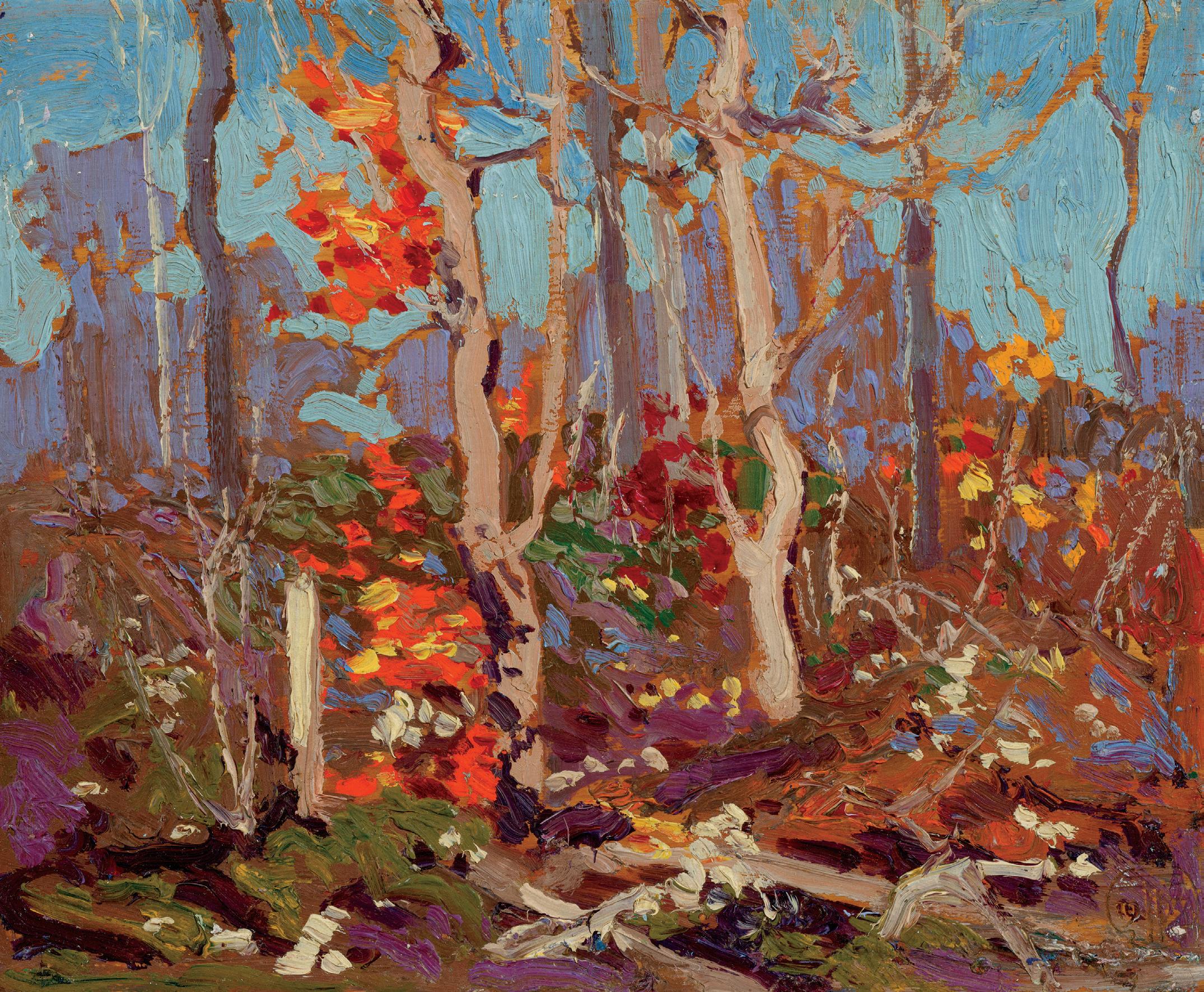
We extend our thanks to Joan Murray, Canadian art historian, for contributing the preceding essay.
$1,000,000–$1,500,000
COWLEY ABBOTT | An Important Private Collection of Canadian Art - Part II - Spring 2023 37
FREDERICK HORSMAN VARLEY
Lynn Valley, B.C. oil on canvas on board signed lower left; signed and inscribed “B.C. Landscape” and Varley Inventory No. 53 on a label on the reverse 20 ins x 24 ins; 50 cms x 60 cms
PROVENANCE
The Artist Roberts Gallery, Toronto, 1954
Roy Cole, September 1954
Mr. & Mrs. Alan Manford, Toronto, circa 1968 Private Collection
EXHIBITED
Varley: A Celebration, Varley Art Gallery of Markham, 31 May‒10 August 1997, no. 25
Painting Canada: Tom Thomson and the Group of Seven , Dulwich Picture Gallery, London; travelling to National Museum of Art, Architecture and Design, Oslo; The Groninger Museum, Netherlands; McMichael Canadian Art Collection, Kleinburg, 19 October 2011‒28 October 2012, no. 102 as Lynn Valley, circa 1932‒35
Through the Looking Glass: F. H. Varley in British Columbia 1926-1936, Varley Art Gallery of Markham, 31 January 2015‒10 January 2016
Embracing Canada: Landscapes from Krieghoff to the Group of Seven , Vancouver Art Gallery; travelling to the Glenbow Museum, Calgary; Art Gallery of Hamilton, 30 October 2015‒25 September 2016
LITERATURE
Ian Dejardin et al., Painting Canada: Tom Thomson and the Group of Seven , London, 2011, reproduced page 177
Ian Thom, et al., Embracing Canada: Landscapes from Krieghoff to the Group of Seven , Vancouver/London, 2015, reproduced page 103
F. H. Varley’s Lynn Valley, B.C. is a magnificent, fascinating painting, formed from a mixture of observation and imagination. Varley painted it of a beautiful vista he saw from a house he rented in 1932 on the banks of Lynn Creek in North Vancouver (today its address is 4395 Rice Lake Road), a house which formed an indelible image of happiness in his mind. The picture is dominated by the view from the building’s second storey windows. In the foreground at left is an acutely‒observed section of the bridge across Lynn Creek and beyond it, a pine which has grown upwards from the soil of the valley beyond the bridge; at right, are a birch trunk and pine tree. The middle ground encompasses a view of a mountain side on which forest growth leads to Lynn Peak in the distance. A deep, narrow canyon of water, turquoise in colour, winds upwards amidst rich pockets of colour‒green, blue, purple, orange which convey a jungle of mountain side and land.
Varley is telling us a complex story of a scene that for him once teemed with life but telling it as though it were a stage‒set for a play about Paradise. He told a reporter much later, “That was the happiest time.” In actuality, the house was unfinished and small; the mountain side logged-over. He may have planned to concoct the house as a setting for a love nest for a student, Vera Weatherbie, but perhaps she, like the scene before us, and her feeling for him was formed largely from Varley’s imagination, since he lived most of the time in the house alone. At any rate, Varley was inspired and created a number of watercolours based on the mountainside or the view from the secondstorey windows, such as the nocturne Bridge Over Lynn Canyon (19321935, Vancouver Art Gallery). In this watercolour, he added two lovers on the bridge, a man and a woman‒perhaps imagining them because in Lynn Valley, B.C., they are lacking, his illusions perhaps over.
Varley painted few oil paintings in the house because he couldn’t always afford the expense of the medium but if he did them, he focused them usually on some detail of the scene before him as in From the Studio, Lynn Valley (circa 1935, Agnes Etherington Art Centre, Kingston), a view of a single tree. All of them share in his admiration for Chinese landscape painting, and the British painters William Turner and Samuel Palmer. From Chinese painting certainly, he had learned to love landscape featuring a grand mountain in the background looming over an idyllic scene of trees, small hills and water, from Turner, he had learned how to convey a scene with drama, from Samuel Palmer, how to record the close valued minutia of the mountainside. Lynn Valley, B.C. is a remarkable recreation of the fullscale view from the windows of the house of the mountainside beyond painted at a critical moment in Varley`s life.
He deemed it such a success and so meaningful to him that he kept it with him, only selling it in 1954. It is therefore of unique importance due to its theme, size, and medium‒and the effect it has of saying something profound about one man’s view of what constitutes Heaven on earth.
This work is #53 in the Varley Inventory listing and was dated by Peter Varley.
We extend our thanks to Joan Murray, Canadian art historian, for contributing the preceding essay. Joan would like to thank Christopher Varley, Paul Wildridge and the National Gallery of Canada Library and Archives for their help with researching this artwork.
$150,000–$200,000
COWLEY ABBOTT | An Important Private Collection of Canadian Art - Part II - Spring 2023 38 117

COWLEY ABBOTT | An Important Private Collection of Canadian Art - Part II - Spring 2023 39
PAUL PEEL
The Young Gleaner
oil on canvas
signed and dated 1888 lower left 33 ins x 23.25 ins; 82.5 cms x 58.1 cms
PROVENANCE
Verdier Family, Copenhagen
By descent to the Abell Family, Copenhagen
Oliver, Coate & Co., auction, Toronto, 15 October 1890, lot 9 as Sweet Flowers
R. Fraser (?), 1890
Jenkins Art Gallery, Toronto, 1923 McBrien Estate, Toronto
Waddington’s, auction, Toronto, 23 June 1982, lot 298 as Blossoms and Butterflies
McCready Gallery, Toronto
Sotheby’s, auction, Toronto, 31 May 1990, lot 113 Private Collection
EXHIBITED
Royal Canadian Academy of Arts, National Gallery of Canada, Ottawa, from 13 March 1889, no. 48
Annual Spring Exhibition , Art Association of Montreal, April 1889, no. 50
Fine Arts Department, Toronto Industrial Exhibition , September 1896, no. 67 as Sweet Flowers
Paul Peel: A Retrospective 1860-1892, London Regional Art Gallery; travelling to Royal Ontario Museum, Toronto; Concordia Art Gallery, Montreal; The Winnipeg Art Gallery; Vancouver Art Gallery, 6 September 1986‒30 August 1987, no. 42
Collector’s Canada: Selections from a Toronto Private Collection , Art Gallery of Ontario, Toronto; travelling to Musée du Québec, Quebec City; Vancouver Art Gallery; Mendel Art Gallery, Saskatoon, 14 May 1988‒7 May 1989, no. 31
Home Truths, The Robert McLaughlin Gallery, Oshawa; travelling to Mississauga Living Arts Centre; Rodman Hall, St. Catharines, 4 September 1997‒22 February 1998
Art canadien: L’enfant et son univers|Canadian Art: A Child’s World , Galerie Eric Klinkhoff, Montreal, 28 October‒11 November 2017, no. 17
Our Children: Reflections of Childhood in Historical Canadian Art, Varley Art Gallery of Markham, 13 April‒23 June 2019 as The Young Gleaner (Blossoms and Butterflies)
Embracing Canada: Landscapes from Krieghoff to the Group of Seven , Vancouver Art Gallery; travelling to the Glenbow Museum, Calgary; Art Gallery of Hamilton, 29 October 2015‒5 September 2016
LITERATURE
“The Royal Academy”, Ottawa Evening Journal, 14 March 1889
The Canadian Magazine 57, May 1921, reproduced on cover as Wild Flowers
"Canada’s Foremost Artist Got $2,000 for Pictures Now Worth $750,000," Toronto Evening Telegram , 7 March 1923, reproduced
The Canadian Magazine 61, September 1923, reproduced on cover
Newton MacTavish, The Fine Arts in Canada , Toronto, 1925, reproduced opposite page 25 as Butterflies
E.K. Grayson, Picture Appreciation for the school, Grades VII to X, Toronto, 1932, page 135, reproduced page 134 as Butterflies
W. Stewart Wallace, ed., The Encyclopedia of Canada , Toronto, 1935, vol. 1, reproduced as Butterflies
William Colgate, Canadian Art its origin & development, Toronto, 1943, page 29
Victoria Baker, Paul Peel: A Retrospective 1860-1892, London Regional Art Gallery, 1986, no. 42, reproduced page 133
Dennis Reid, Collector’s Canada: Selections from a Toronto Private Collection , Toronto, 1988, no. 31, reproduced page 41
Joan Murray, Home Truths: A Celebration of Family Life by Canada’s Best-Loved Painters, Toronto, 1997, plate 58, reproduced page 83
Ian Thom, et al., Embracing Canada: Landscapes from Krieghoff to the Group of Seven , Vancouver/London, 2015, page 202, reproduced page 75
Paul Peel spent much of the summer of 1887 in the French fishing port of Étaples-sur-mer, Pas-de-Calais, site of a colony of international artists. It was in Étaples that he found local girl, Marie, who became a favoured model for a series of figure paintings completed in 1888. In this canvas, originally titled The Young Gleaner, the young girl is depicted outdoors under brilliant sunlight descending an Étaples sand dune, armed with freshly gleaned flowers and captured at the fleeting moment she spies two butterflies. This painting is a slightly larger replica of the canvas (Art Gallery of Ontario) shipped from Paul Peel’s Paris studio to Canada for exhibition: first at the 19th Annual Royal Canadian Academy of Art Exhibition in Ottawa in March 1889 and in April at the Art Association of Montreal Spring Salon. As was a common 19th century practice, Peel frequently replicated his paintings, sometimes in differing scales, for various reasons: additional sales; the artist’s own study/demonstration purposes; or as gifts to family or friends. This version of The Young Gleaner was retained by the artist’s Copenhangen-based Danish in-laws, the Verdiers, from whence it descended through the family until its sale in Canada. A third version of the subject is thought to be in private hands.
A primary painterly interest in The Young Gleaner is an optically realistic rendering of bright sunlight, an interest shared by most contemporary artists of the day. Peel’s preoccupation with sunlight is underscored by a companion piece, The Young Botanist, which depicts little Marie seated examining flowers on the same sand dune under a similarly bleaching sunlight (at least two versions of this composition are known, one in Museum London). A life-sized pastel drawing of The Young Botanist was exhibited at the Paris Salon of 1888, under the title Au soleil (Frank Gray, of Toronto, would purchase both the pastel (Sunshine) and oil from the artist at Oliver, Coate & Co, Paul Peel Sale in 1890).
Like fellow graduates of the Pennsylvania Academy of Arts and students of Thomas Eakins (Peel graduated in 1880), Paul subscribed to a tonal method of rendering natural light outdoors. This alternative aesthetic of light to French impressionism, practised by most North American artists‒recently coined the Glare aesthetic (William Gerdts, American Impressionism, 1980)‒depends on tonal, rather than colour, contrasts. Here the effort to render bright natural light conditions leads to a bleached palette and flattened forms with reinforced formal outlines (vs impressionist dissolution of form). This method owes a debt to Edouard Manet (whose 1884 Paris retrospective exhibition Peel must have seen).
Peel launched his professional career in France with such studio productions as The Spinner (1882, Museé des beaux-art de Montreal), and continued throughout his short career to seek his official credentials by means of idealized domestic genre paintings after the
COWLEY ABBOTT | An Important Private Collection of Canadian Art - Part II - Spring 2023 40 118
prevailing academic manner. It was at the recommendation of his first French teacher, Jean-Paul Gerome, that the fledging artist began sketching outdoors, first in Pont-Aven, Brittany, where he joined an established seasonal colony of largely American artists. Direct painting outdoors resulted in a number of high-keyed paintings capturing the bright, glaring properties of sunlight on local forms, exemplified by a series of Pont-Aven village views and the small figure study Bubble Boy (1884, Art Gallery of Ontario). In 1883, during a visit to his hometown of London, Ontario, Peel applied his new methodology to depict Covent Garden Market (Museum London), under a blazing sun using large, bright planes next to small areas of deep darks to solidify architectural forms.
Like his American friends, Peel’s concern with optical realism (photographs served as memory aids) was tempered by an ongoing academic concern for formal integrity and for appealing pictorial narratives. The bright illumination of little Marie equally evokes a happy mood and carefreeness of a fleeting moment of childhood, one echoing the artist’s personal life in 1887 as a new husband and father of a one-year old son (born the previous October in Étaples). The charm of children would remain a primary selling point of the artist’s production.
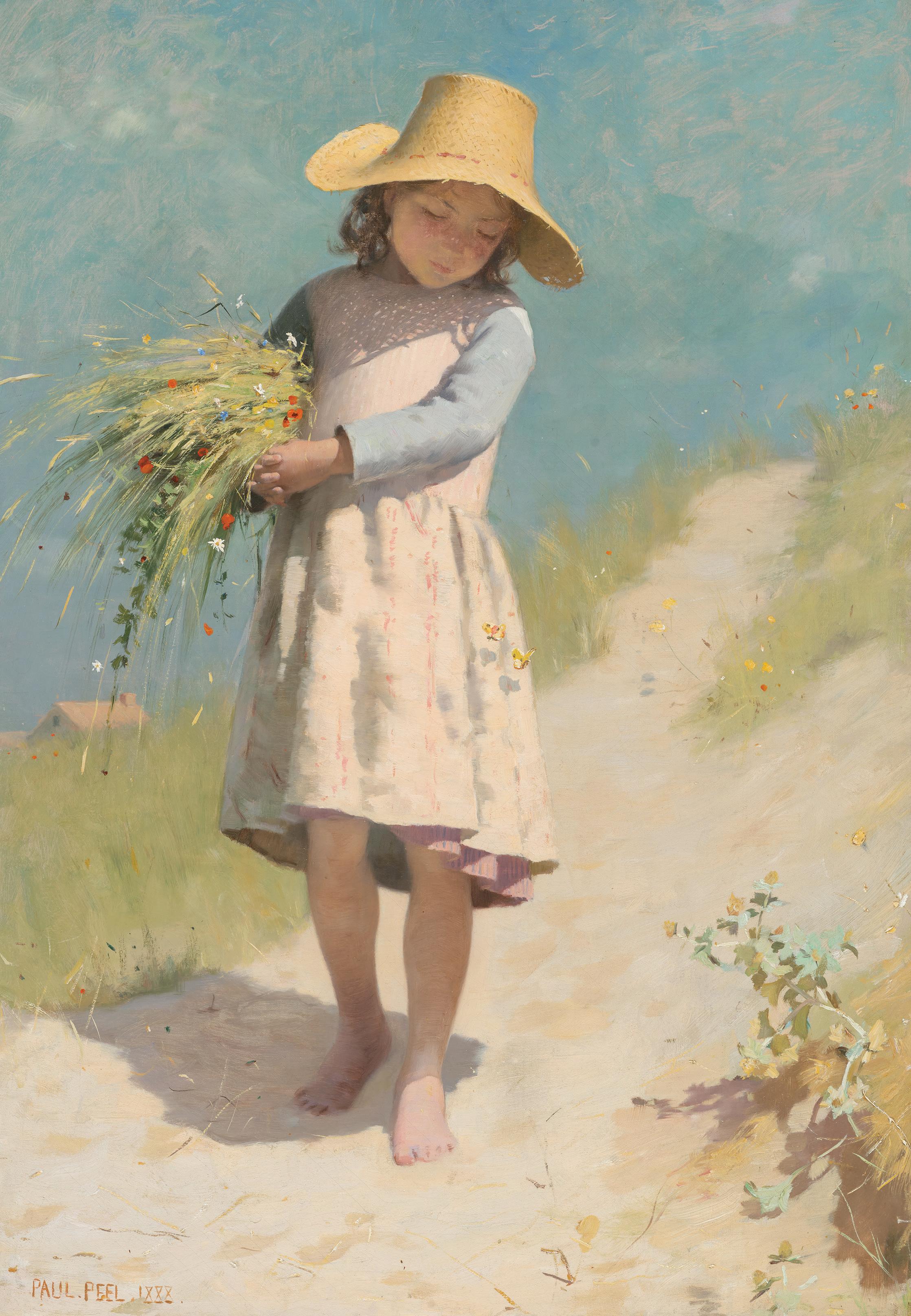
We extend our thanks to Victoria Baker, Canadian art historian and author of Paul Peel: A Retrospective, 1860-1892 for contributing the preceding essay.
$150,000–$200,000
COWLEY ABBOTT | An Important Private Collection of Canadian Art - Part II - Spring 2023 41
119
THÉOPHILE HAMEL
A Gentleman of Quebec

oil on canvas
signed with initials and dated 1856 to the left 15.25 ins x 11.25 ins; 38.1 cms x 28.1 cms
PROVENANCE
P. Labranche, Montreal
Walter Klinkoff Gallery, Montreal, 1977
Acquired by the present Private Collection, November 1977
EXHIBITED
Collector’s Canada: Selections from a Toronto Private Collection , Art Gallery of Ontario, Toronto; travelling to Musée du Québec, Quebec City; Vancouver Art Gallery; Mendel Art Gallery, Saskatoon, 14 May 1988‒7 May 1989, no. 4
Home Truths, The Robert McLaughlin Gallery, Oshawa; travelling to Mississauga Living Arts Centre; Rodman Hall, St. Catharines, 4 September 1997‒22 February 1998
Hommage to Walter Klinkhoff (Part I), Galerie Walter Klinkhoff, Montreal, September 1988, no. 11
Embracing Canada: Landscapes from Krieghoff to the Group of Seven , Vancouver Art Gallery; travelling to the Glenbow Museum, Calgary; Art Gallery of Hamilton, 29 October 2015‒5 September 2016
Highlights from "Embracing Canada", Annual Loan Exhibition, Galerie Eric Klinkhoff, Montreal, 22 October‒5 November 2016, no. 3
LITERATURE
Joan Murray, Home Truths: A Celebration of Family Life by Canada’s Best-Loved Painters, Toronto, 1997, plate 28, reproduced page 49
Dennis Reid, Collector’s Canada: Selections from a Toronto Private Collection , Toronto, 1988, no. 4, reproduced page 17
Ian Thom, et al., Embracing Canada: Landscapes from Krieghoff to the Group of Seven , Vancouver/London, 2015, page 200, reproduced page 15
$8,000–$10,000
COWLEY ABBOTT | An Important Private Collection of Canadian Art - Part II - Spring 2023 42
120
THÉOPHILE HAMEL
Madame Lemusurier oil on canvas dated 1848, inscribed “T.H.” on the reverse and inscribed “Mme. M. Lemusurier” on a label on the reverse 16 ins x 13.75 ins; 40 cms x 34.4 cms

PROVENANCE
P. Labranche, Montreal
Walter Klinkoff Gallery, Montreal, 1977
Acquired by the present Private Collection, November 1977
EXHIBITED
Collector’s Canada: Selections from a Toronto Private Collection , Art Gallery of Ontario, Toronto; travelling to Musée du Québec, Quebec City; Vancouver Art Gallery; Mendel Art Gallery, Saskatoon, 14 May 1988‒7 May 1989, no. 3
Hommage to Walter Klinkhoff (Part I), Galerie Walter Klinkhoff, Montreal, September 1988, no. 12
LITERATURE
Dennis Reid, Collector’s Canada: Selections from a Toronto Private Collection , Toronto, 1988, no. 3, reproduced page 16
Théophile Hamel began his career at the young age of sixteen, when he accepted an apprenticeship with Antoine Plamondon, the most prominent Quebec artist at the time. During this six-year period, Hamel received a strong formal training in European-style painting and portraiture. Upon leaving Plamondon’s workshop, Hamel traveled to Europe from 1843 to 1846, staying in Rome, Venice, London and Paris, to further his study of historical portrait painting.
After settling in Montreal, Hamel quickly won the respect of the élite; he was encouraged by the three dominant social groups interested in art: clergy, politicians, and businessmen. He was appointed official portrait painter by the government of the United Canadas in June 1853, and entrusted with the high honour of painting portraits of past and present speakers of the assemblies and legislative councils. Hamel’s style was known for its verisimilitude; he had a particular talent for handling daring chromatic effects, reflections and the rendition of luxurious fabrics.
$6,000–$8,000
COWLEY ABBOTT | An Important Private Collection of Canadian Art - Part II - Spring 2023 43
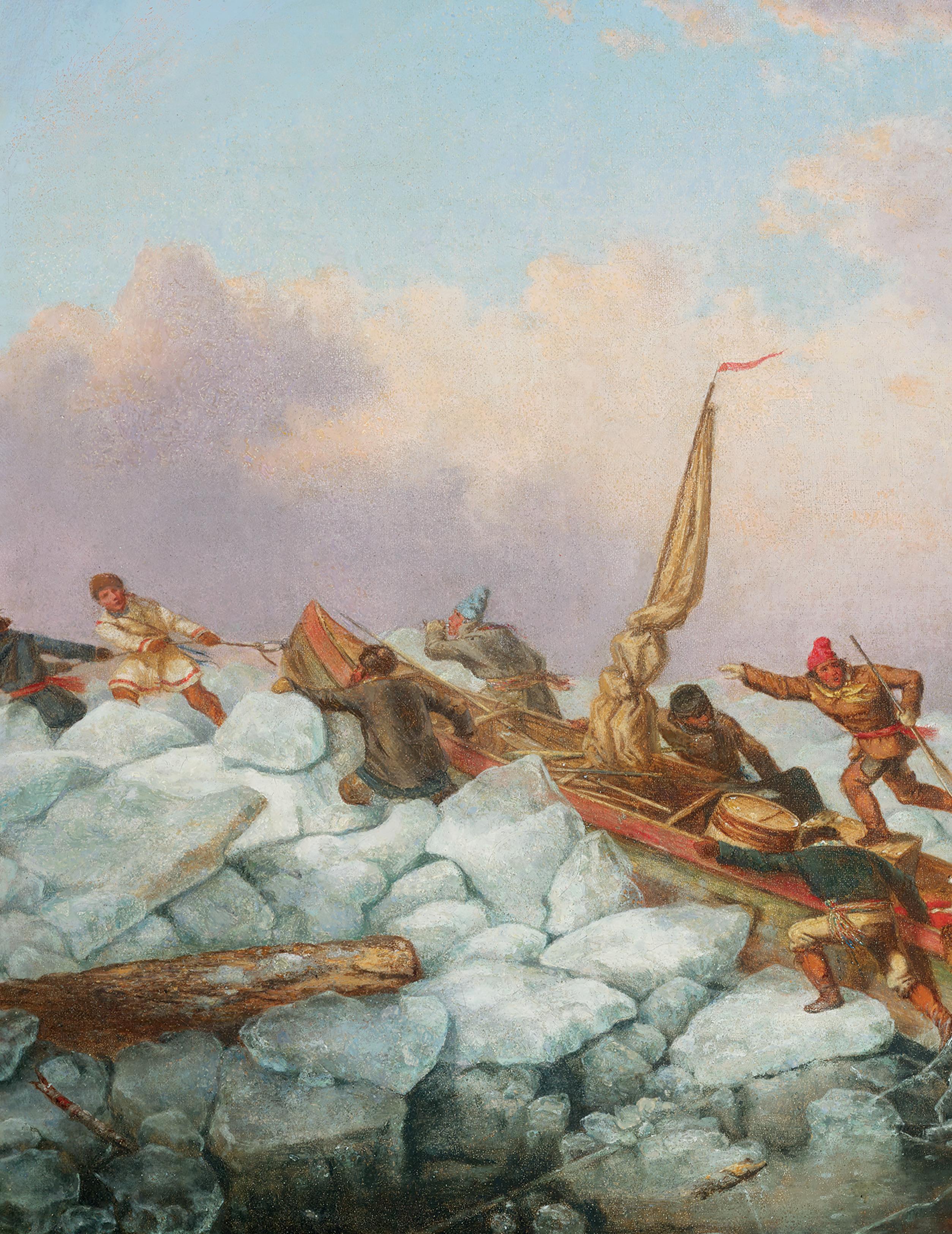
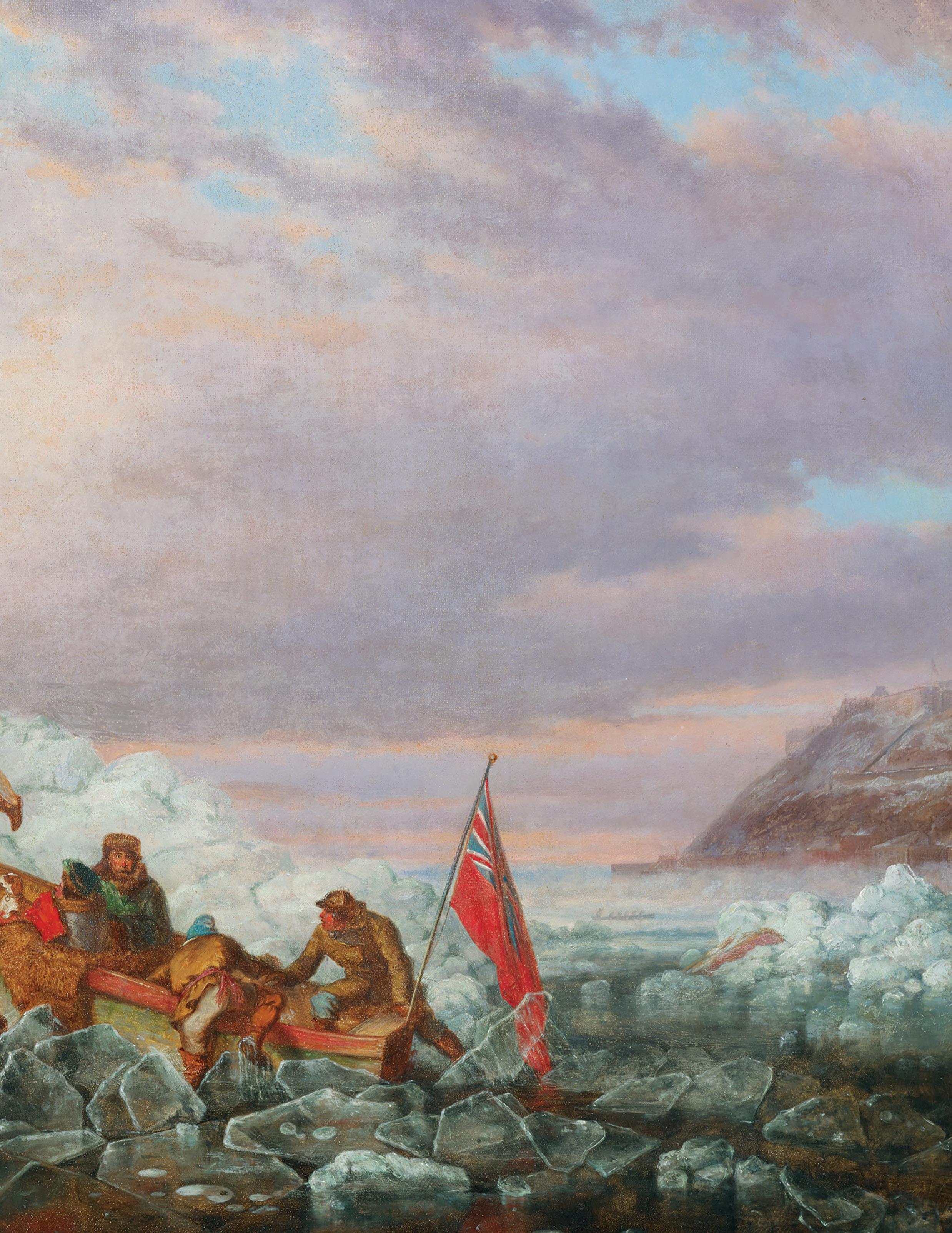
CORNELIUS KRIEGHOFF
The Royal Mail Crossing the St. Lawrence oil on canvas signed and dated 1860 lower left 17 ins x 24 ins; 42.5 cms x 60 cms
PROVENANCE
Watson Galleries, Montreal
W.M. Connor, Hull, Quebec (until at least 1955)
Sotheby & Co., auction, London, 29 May 1963, lot 14
G. Blair Laing Ltd., Toronto
Garfield Weston
Roy Cole, Hamilton
Acquired by the present Private Collection, 1972 (through Paul Duval)
EXHIBITED
Collector’s Canada: Selections from a Toronto Private Collection, Art Gallery of Ontario, Toronto; travelling to Musée du Québec, Quebec City; Vancouver Art Gallery; Mendel Art Gallery, Saskatoon, 14 May 1988‒7 May 1989, no. 8
Expanding Horizons: Painting and Photography. American and Canadian Landscapes 1860‒1918, Montreal Museum of Fine Arts; travelling to Vancouver Art Gallery, 18 June 2009‒17 January 2010, no. 73
Embracing Canada: Landscapes from Krieghoff to the Group of Seven , Vancouver Art Gallery; travelling to the Glenbow Museum, Calgary; Art Gallery of Hamilton, 29 October 2015‒5 September 2016
LITERATURE
James Hodges, Construction of the Great Victoria Bridge in Canada , John Weale, London, 1860, related lithograph reproduced pages 78‒79 as Passengers and Mail, Crossing River
Marius Barbeau, Cornelius Kreighoff, Pioneer Painter of North America , Toronto, 1934, pages 58‒60, pages 129‒30 lists six versions of this subject
"Krieghoff, The Rebirth of a Fascinating Painter," Maclean’s Magazine, 24 December 1955, reproduced page 16‒17 as Royal Mail Crossing the Ice (collection of W.M. Connor, Hull)
Marius Barbeau, I Have Seen Quebec, Toronto, 1957, unpaginated, reproduced as Mail boat crossing the St. Lawrence, 1860
J. Russell Harper and Peter Winkworth, Scenes in Canada, C. Krieghoff Lithography Drawings After His Paintings of Canadian Scenery 18481862, McCord Museum, Montreal, 1972, unpaginated, related work reproduced opposite plate 18
J. Russell Harper, Krieghoff, Toronto, 1979, pages 88‒89, cover illustration for closely related painting of the same subject (detail), page 59, six versions of this subject are noted on page 191
Dennis Reid, Krieghoff: Images of Canada , Art Gallery of Ontario, Toronto, 1999, page 71, page 142 for the print of this subject
Hilliard T. Goldfarb, Expanding Horizons: Painting and Photography. American and Canadian Landscapes 1860‒1918, Montreal Museum of Fine Arts, 2009, no. 73, reproduced page 147 as Royal Mail Crossing the St. Lawrence
Sarah Milroy, Generations: The Sobey Family and Canadian Art, McMichael Canadian Art Collection, 2022, a similar work reproduced on pages 78‒79 and on the cover
Cornelius Krieghoff moved to Quebec City in 1853, encountering a vibrant and growing city. As Dennis Reid remarked: "Almost as large as Montreal at a population of some 58,000, close to 40 per cent anglophone (as opposed to the then slightly more than 50 per cent anglophone component of the Montreal population) it was the military headquarters for British North America, the centre of the all-important timber trade with Britain, the location of the burgeoning new ship building industry and since October 1851, had been the seat of the government for the province of Canada.”
While pioneer life was rugged and precarious, it was also a productive and fruitful time for Krieghoff as he recorded the industry and ingenuity of the people of Quebec City. At this time, there was no bridge over the St. Lawrence River, and so to cross this mighty body of water to access Lévis on the opposite shore, one had to embark upon a perilous journey in a Royal Mail canoe. Marius Barbeau, Krieghoff's early biographer, points out that, “The cutting of lumber in the woods and the driving of rafts down the Ottawa and the St. Lawrence gave rise to a great Canadian industry in the earlier part of the nineteenth century, and Krieghoff, like his predecessor Bartlett, interprets some of its aspects upon canvas.”
Few would embark upon this journey across the St. Lawrence River in a Royal Mail canoe unless necessary. Passengers had to lay down or seat themselves in the canoe, which was manned by ten or twelve people. The canoe would be paddled through the open water amidst floating islands of ice. This crossing would take hours and was dangerous, with the passengers often reaching a shoreline that was miles beyond the point at which they had started. According to J. Russell Harper, "The boatmen or canotiers who operated these were a hardy breed who jumped out on the ice floes which impeded their progress and hauled the wooden canoes over the obstacles. Some passengers who gave them a hand received a reduction in their passage money. It was an adventurous trip for the uninitiated, and one of the experiences remembered by visitors to Quebec in the winter months."
Krieghoff has chosen to depict a heightened scene of drama in this composition of a Royal Mail canoe making its crossing at winter. This canoe bears the responsibility of safe passage for eleven people, which includes a woman seated on a bearskin rug holding her dog, secured in the back half of the vessel. The citadel and ramparts of Quebec City are silhouetted in the distance, anchoring the scene. The energy and hard work involved in this venture, as well as the frenzy and cold nature of the excursion vibrates from the canvas. The boatmen are hustling to pull and push the boat over the ice floes before the vessel freezes in place, while one worker blows a horn signalling their position in the river. No one aboard the Royal Mail canoe seems particularly alarmed by what appears to be an experience that could have an uncertain outcome.
Krieghoff specialized in genre paintings, and this work is a remarkable anecdotal image of the human struggle against ice floes and the ferocity of the upper St. Lawrence River in the depths of winter. Barbeau lists six known versions of this subject, painted between 1859 and 1862. "Under his vivid brush they are alive with fun and movement,” stated Barbeau. A similar variant to this 1860 canvas is Crossing the St. Lawrence with the Royal Mail at Quebec, an 1859 canvas in the collection of the Sobey Art Foundation. Krieghoff is known to have painted more than one of the same image in various canvas sizes
COWLEY ABBOTT | An Important Private Collection of Canadian Art - Part II - Spring 2023 46 121
and also recognized the commercial benefit of lithography, a popular endeavour in this period. A lithograph of a Royal Mail canoe making the arduous St. Lawrence River crossing was produced from one of Krieghoff’s versions of the painting, but the citadel of Quebec City was eliminated.

Krieghoff visited Montreal around the time of the erection of the Victoria Bridge between 1854-59 and sold one of his canvases of the Royal Mail canoe crossing to an engineer working on the project. When a book was issued on the development of this ground-breaking new bridge, Construction of the Great Victoria Bridge in Canada , illustrations demonstrating the inadequacy of the boats used to cross the river in Montreal were included, highlighting the convenience of the new bridge. Krieghoff’s painting of the Royal Mail canoe crossing was included. However, this reproduced image removed the Quebec citadel from the horizon line, declaring the depiction to be in Montreal, thus strengthening the case for the triumph of the Victoria Bridge.
Krieghoff was an artist attuned to the interests of his audience and was beloved by collectors during his lifetime. The legacy of The Royal Mail Crossing the St. Lawrence as a treasure within his artistic oeuvre is further solidified by the rarity of a canvas with such an abundance of figures, exquisitely rendered detail and narrative strength. Krieghoff produced dignified paintings that were romantic in nature, evoking the deep roots of the people he encountered and imparting his own vision of historical Canada. Reid argues for “the complex genesis of Krieghoff’s images of Canada”, in which this canvas holds a prominent place.
$200,000–$300,000
COWLEY ABBOTT | An Important Private Collection of Canadian Art - Part II - Spring 2023 47
MARY ALEXANDRA BELL EASTLAKE
In the Orchard, circa 1895-1897 oil on canvas signed lower right 38 ins x 33.25 ins; 95 cms x 83.1 cms
PROVENANCE
Sotheby’s, auction, Toronto, 2 October 1974, lot 14
G. Blair Laing Ltd., Toronto
Mr. & Mrs. Kenneth R. Thomson, Toronto
A.K. Prakash & Associates, Inc., Toronto
Masters Gallery, Calgary
Acquired by the present Private Collection, 2011
EXHIBITED
Embracing Canada: Landscapes from Krieghoff to the Group of Seven , Vancouver Art Gallery; travelling to the Glenbow Museum, Calgary; Art Gallery of Hamilton, 30 October 2015‒25 September 2016 Canada and Impressionism: New Horizons 1880‒1930, National Gallery of Canada, Ottawa; travelling to Kunsthalle der Hypo‒Kulturstiftung, Munich; Fondation de l’Hermitage, Lausanne; Musée Fabre, Montpellier, 19 July 2019‒3 July 2021, no. 60
LITERATURE
Ian Thom, et al., Embracing Canada: Landscapes from Krieghoff to the Group of Seven , Vancouver/London, 2015, page 60, reproduced page 81 Katerina Atanassova, Canada and Impressionism: New Horizons 1880‒1930, Ottawa, 2019, no. 60, pages 253, 278 note 69, reproduced page 185
Born in Douglas, Ontario, Mary Bell studied at the Art Association of Montreal under Robert Harris, in New York at the Art Students League (circa 1885) under the impressionist William Merritt Chase, and in Paris, where she enrolled for a year in the early 1890s at the Académie Colarossi, a favourite destination for many North American art students. In 1897 she married the landscape painter Charles Eastlake, with whom she settled in England. She exhibited paintings, jewelry and enamelwork internationally, and even had a one-woman show at the Art Gallery of Toronto in 1927. She moved to Montreal with her husband at the start of the Second World War, and after his death returned to Almonte (Ontario), where she had spent much of her childhood.
Although not exclusively a figure painter, Bell Eastlake was best known for her depictions of girls and women in domesticated outdoor settings: subjects widely considered appropriate for women artists at the time. The girl and the baby in In the Orchard might be sisters, although their juxtaposition also underscored stereotypes about the natural evolution of girls into future mothers. Among Bell Eastlake’s contemporaries, artists such as Mary Cassatt, Helen McNicoll and Laura Muntz Lyall were also renowned for their views of young women, girls and babies. Indeed, as Katerina Atanassova has noted, the influence of Cassatt’s prints may be seen in the flatness and in the outlined forms of In the Orchard ; Bell likely saw Cassatt’s prints when they were exhibited at the Galerie Durand‒Ruel in Paris in 1891.
Surveying Bell Eastlake’s career in 1925, The Studio described her work as “essentially decorative. She has a strong sense of rhythm and pattern. Her colour, which is pure and strong, is usually put down in flat tones, whether the medium be pastel, oil colour, or gouache. The characterisation of her portraits and figure subjects is excellent … She excels in depicting babies and young children.” All of these qualities are present in In the Orchard , where the two figures are placed in a space whose shallowness is enhanced by the highly decorative fruit trees that both delimit the space and echo the decoratively curving elements of the cradle. By having the kneeling girl look straightforwardly at the spectator, Bell avoided the excessive sentimentality that often bedevilled paintings of children, while the warm colouring and dappled sunlight lend an immediacy that combines the freshness of Impressionism with a post-impressionist interest in outline and design. In the words of the art critic for journal The Week , writing in 1895 about another of Bell’s child-themed paintings (but with words that could as easily be applied to In the Orchard ), the picture was “simply and solidly painted; a little piece of decoration which would give life and colour to a large space in many a drawing-room”.
Bell Eastlake only occasionally signed, and almost never dated, her canvases, but there are rare examples of comparable views of girls and young women in gardens that she signed with her married name (e.g., Blue and Gold ; National Gallery of Canada). In the Orchard is signed “M.A. Bell”, and is therefore presumed to have been painted before her 1897 marriage, although as late as 1927 the Toronto Star noted that “Mrs. C.H. Eastlake … is perhaps better known in Toronto as M.A. Bell.” Her work from earlier in the 1890s tended to be based on a more conservative palette, and it therefore seems reasonable to date In the Orchard to the middle years of the decade.
We extend our thanks to Brian Foss, Carleton University Chancellor’s Professor of Art & Architectural History, and co‒curator of 1920s Modernism in Montreal: The Beaver Hall Group for his assistance in researching this artwork and for contributing the preceding essay.
$30,000–$50,000
COWLEY ABBOTT | An Important Private Collection of Canadian Art - Part II - Spring 2023 48 122
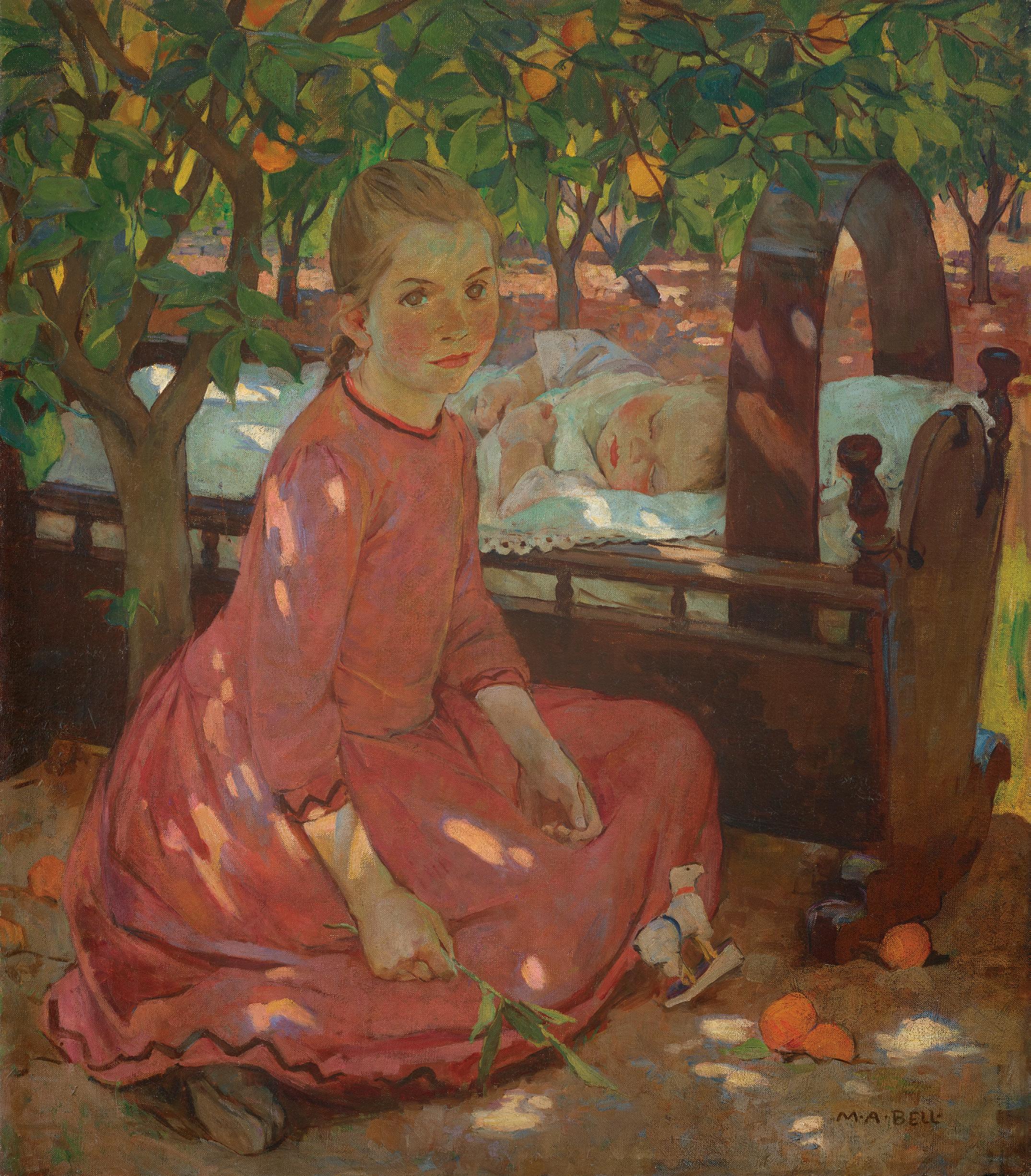
COWLEY ABBOTT | An Important Private Collection of Canadian Art - Part II - Spring 2023 49
123
JOSEPH-CHARLES FRANCHÈRE
Harvesting/La moisson, circa 1900 oil on board signed lower left 9.5 ins x 13.5 ins; 23.8 cms x 33.8 cms
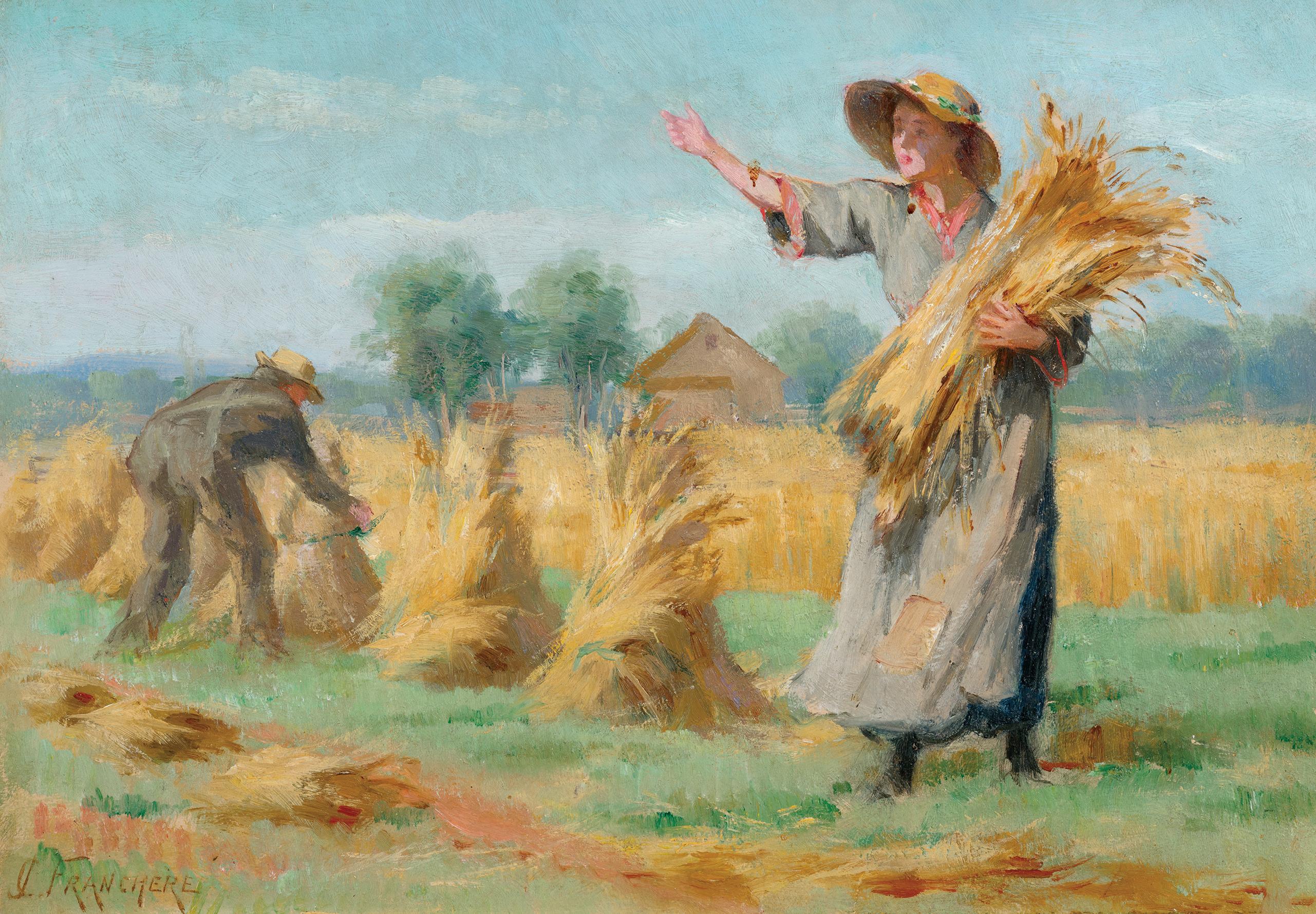
PROVENANCE
Galerie Walter Klinkhoff, Montreal Private Collection
EXHIBITED
Embracing Canada: Landscapes from Krieghoff to the Group of Seven , Vancouver Art Gallery; travelling to the Glenbow Museum, Calgary; Art Gallery of Hamilton, 29 October 2015‒5 September 2016
LITERATURE
Ian Thom, et al., Embracing Canada: Landscapes from Krieghoff to the Group of Seven , Vancouver/London, 2015, page 200, reproduced page 156
Joseph-Charles Franchère belongs to the generation of FrenchCanadian artists born during the 1870s who would make their mark on the Canadian scene at the end of the 19th century. In such cases, the conditions would be met (galleries, critics, collectors, museums) to allow young painters to pursue a career following their studies in Europe. Franchère's reputation was established in the early 1890s with a contract for decorating the Notre-Dame-du-Sacré-Coeur chapel in Notre-Dame de Montréal Church, which he shared with his contemporaries: Ludger Larose, Henri Beau, Joseph Saint-Charles and Charles Gill.
To carry out this important commission of three paintings, Franchère studied in France until 1894. Back in Montreal, his career progressed and he made a name for himself as both a teacher and an illustrator. He exhibited portraits, landscapes and genre scenes annually at the Art Association of Montreal and with the Royal Canadian Academy of Arts, where he was made an associate member in 1902. He also gained the respect of his colleagues, as Alfred Laliberté testified in his book Les artistes de mon temps. Moreover, Franchère rented a studio in the house that belonged to the sculptor Laliberté.
We extend our thanks to Laurier Lacroix, C.M., art historian, for contributing the preceding essay.
$5,000–$7,000
COWLEY ABBOTT | An Important Private Collection of Canadian Art - Part II - Spring 2023 50
124
JOSEPH-CHARLES FRANCHÈRE
La Moissonneuse/Une Gerbe de ble, 1920 coloured plaster incised signature on the base 16 ins x 11.5 ins x 6 ins; 40 cms x 28.8 cms x 15 cms
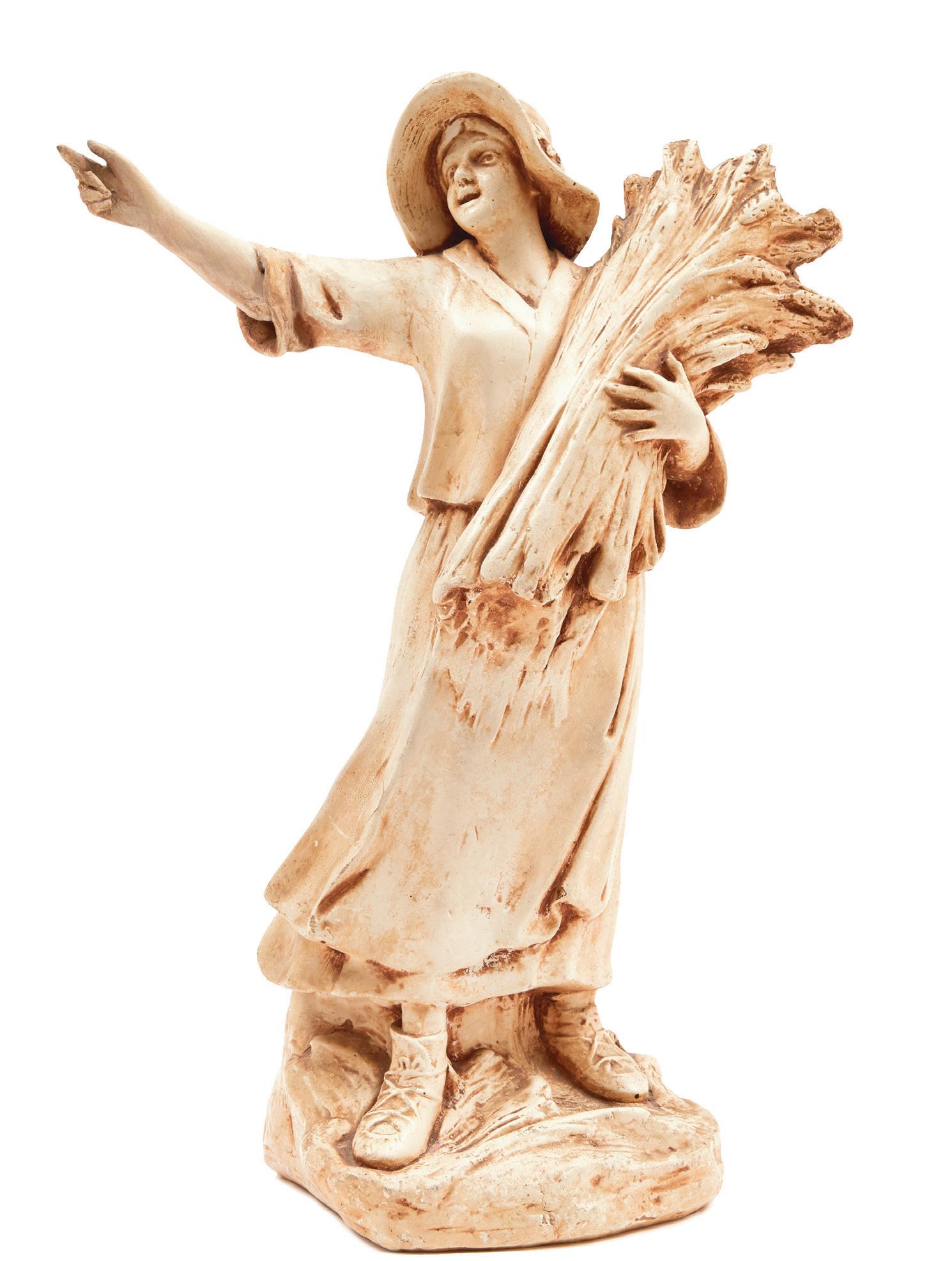
PROVENANCE
Galerie Valentin, Montreal Private Collection
EXHIBITED
37th Annual Spring Exhibition , Art Association of Montreal, 25 March‒17 April 1920, no. 298 as La Moissonneuse $20
$5,000–$7,000
COWLEY ABBOTT | An Important Private Collection of Canadian Art - Part II - Spring 2023 51


LAWREN STEWART HARRIS
Quiet Lake (Northern Painting 12), circa 1926-1928
oil on canvas
inscribed “Quiet Lake/Lawren Harris/Northern Painting XII 34 x 40” on a label on the reverse
34 ins x 40 ins; 85 cms x 100 cms
PROVENANCE
The Artist, until at least 1940 Private Collection, Toronto
Acquired by the present Private Collection, December 1970
EXHIBITED
Collector’s Canada: Selections from a Toronto Private Collection , Art Gallery of Ontario, Toronto, travelling to Musée du Québec, Quebec City; Vancouver Art Gallery; Mendel Art Gallery, Saskatoon, 14 May 1988‒7 May 1989, no. 62 as circa 1923
Annual Group of Seven Dinner, featuring works by Lawren S. Harris, York Club, Toronto, 18 February 1998
Embracing Canada: Landscapes from Krieghoff to the Group of Seven, Vancouver Art Gallery, travelling to the Glenbow Museum, Calgary; Art Gallery of Hamilton, 30 October 2015‒25 September 2016
Highlights from "Embracing Canada" , Galerie Eric Klinkhoff, Montreal, 22 October‒5 November 2016, no. 18
Pop Up Museum , Canadian Friends of the Israel Museum, 21 August
2019
LITERATURE
Bertram Brooker, “Canada’s Modern Art Movement,” The Canadian Forum , June 1926, page 278
Alice Mackay, “The Second Annual Exhibition of Canadian Art,” Canadian Homes & Gardens, IV:4, April 1927, reproduced page 32 as Northern Lake
“Exhibition of Contemporary Canadian Art Has Resulted in Fine Picture Collection,” Ottawa Citizen , 12 January 1927
Doris Mills, The paintings of Lawren Harris compiled by Mrs. Gordon Mills, July-Dec. 1936, Library and Archives of the National Gallery of Canada, as Northern Paintings, Number 12, with drawing by Hans Jensen
Jeremy Adamson, Lawren Harris: Urban Scenes and Wilderness
Landscapes 1906-1930, Toronto, 1978, pages 150, 165, 214 note 304
Dennis Reid, Collector’s Canada: Selections from a Toronto Private Collection , Toronto, 1988, no. 62, reproduced page 61, as circa 1923
David Silcox, The Group of Seven and Tom Thomson , Toronto, 2003 and 2011, reproduced page 310, caption page 421, as circa 1923
Paul Duval, Lawren Harris: Where the Universe Sings, Toronto, 2011, page 212, reproduced page 213, caption page 410, as circa 1922
Ian Thom, et al., Embracing Canada: Landscapes from Krieghoff to the Group of Seven , Vancouver/London, 2015, reproduced page 128, caption page 201, as circa 1924
Lawren Harris and A.Y. Jackson first painted on Lake Superior in October 1921. They took the Algoma Central Railway from Sand Lake, Algoma north to Franz, where they caught the Canadian Pacific train travelling west to Rossport and Schreiber. Harris would return to paint and draw on the north shore of Lake Superior almost every October until 1928. His Lake Superior canvases range from depictions of the rocks, hills and bays and interior lakes to dramatic visions of the light over the vast body of water.
To better express his expanding vision of the landscape, in 1925 Harris began to paint on beaverboard panels that were approximately 12 x 15 inches (30.5 x 37.6 cm) rather than his earlier supports that measured approximately 10 ½ x 13 ½ inches (26.3 x 34.4 cm).
Harris frequently reinterpreted similar subjects, exploring in each work variant compositions in new pictorial languages. In May 1926 he presented a painting titled Northern Lake in the Group of Seven exhibition at the Art Gallery of Toronto. Northern Lake was worked up from a 12 x 15 inch oil sketch of 1925 now in the McMichael Canadian Art Collection (accession 1969.17.1). Northern Lake was one of the five Harris paintings included in the Canadian section of the Sesqui-Centennial exhibition in Philadelphia in the summer of 1926 (no. 1564, reproduced in the Philadelphia catalogue) where it was awarded a gold medal. Jeremy Adamson, organizer of the major Harris retrospective at the Art Gallery of Ontario in 1978, has argued that the medal was awarded to Harris’ canvas Ontario Hill Town (University College, Toronto), not Northern Lake, though two reviews of the Annual Exhibition of Canadian Art at the National Gallery in Ottawa in January 1927, where Northern Lake was subsequently exhibited hors catalogue, confirm that Northern Lake was indeed the gold prize winner.
Quiet Lake is a similar composition to Northern Lake though clearly an evolution from the earlier canvas. The title Quiet Lake, a very a‒characteristic title, was given to this painting when it was catalogued by Doris Mills, a friend of Harris’ wife Bess, in 1936. Mills listed it among a group of canvases she identified as Northern Paintings, of which this was number 12, not among Harris’ Lake Superior paintings.

COWLEY ABBOTT | An Important Private Collection of Canadian Art - Part II - Spring 2023 54 125
Lawren S. Harris Northern Lake, 1926 oil on canvas, 91.4 x 90 cms Private Collection Not for sale with this lot

COWLEY ABBOTT | An Important Private Collection of Canadian Art - Part II - Spring 2023 55
However, the site is identified in a related sketch titled by the artist Above Coldwell Bay, North Shore, Lake Superior (sold Sotheby Parke Bernet (Canada), Toronto, 5 November 1979, lot 156).
The lake depicted here was first painted by Harris prior to 1925, as there is an oil sketch of this same lake on a smaller panel (sold Sotheby’s Canada, Toronto, 3 December 1997, lot 155). However Quiet Lake was worked up from a panel of 1925 measuring 12 x 15 inches and titled by the artist Northern Lake, Ontario, October

In both Quiet Lake and Northern Lake the point of view is determined by the foreground ‘ledge’. The lake opens up in the middle distance and is framed by the curves of the surrounding hills. In Northern Lake the hills rise left and right with the cold blue light of the sky glowing in the centre distance, reflecting on the water and casting shadows on the still lake. As Bertram Brooker wrote, the painting is “sombre, but none the less restful. In that sketch the distant rise upper left is painted in contrasting striations as on the hill upper right, whereas in the canvas Quiet Lake the yellow covers the entire slope.
There are similarities and differences between Northern Lake and Quiet Lake. In Quiet Lake Harris heightened the tonal contrasts, painting the autumn grasses and foliage in a bright, mustard palette. The silhouettes of the reflections in the quiet lake create an abstract pattern, as solid as the foreground rock, and are surrounded by the pale green trees lower right and dark green trees centre left. In contrast to Northern Lake, the hills are less symmetrical and the interplay of the dominant forms creates a less restful and more dynamic image. The eye follows the dominant yellow from lower right to upper left while the left shore juts into the open centre linking to the dark hill upper right.
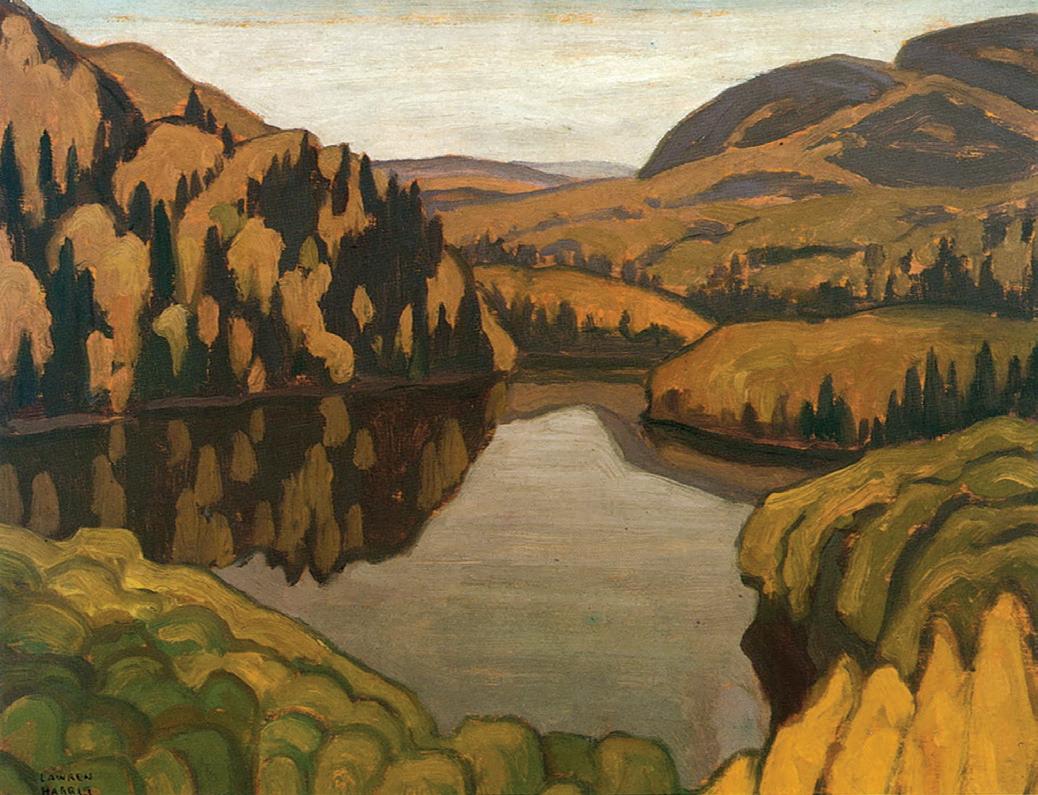
To date it has been impossible to identify Quiet Lake with any canvas Harris exhibited in the 1920s. It clearly developed out of and postdates Northern Lake of 1926.
We extend our thanks to Charles Hill, Canadian art historian, former Curator of Canadian Art at the National Gallery of Canada and author of The Group of Seven‒Art for a Nation , for his assistance in researching this artwork and for contributing the preceding essay.
$2,000,000–$3,000,000
Private Collection
Not for sale with this lot
Private Collection
Not for sale with this lot
COWLEY ABBOTT | An Important Private Collection of Canadian Art - Part II - Spring 2023 56
Lawren S. Harris Northern Lake, Ontario, October, 1925 oil on panel, 30 x 37.5 cms
Lawren S. Harris
Northern Lake oil on panel, 27.9 x 35.6 cms
126
HORATIO WALKER
The Woodcutter (Le bûcheron), circa 1915 oil on canvas on board signed with initials lower left; Estate Stamp (signed by Clarence Gagnon) on the reverse; titled “Wood Cutter” on a label on the reverse 14 ins x 17 ins; 35 cms x 42.5 cms
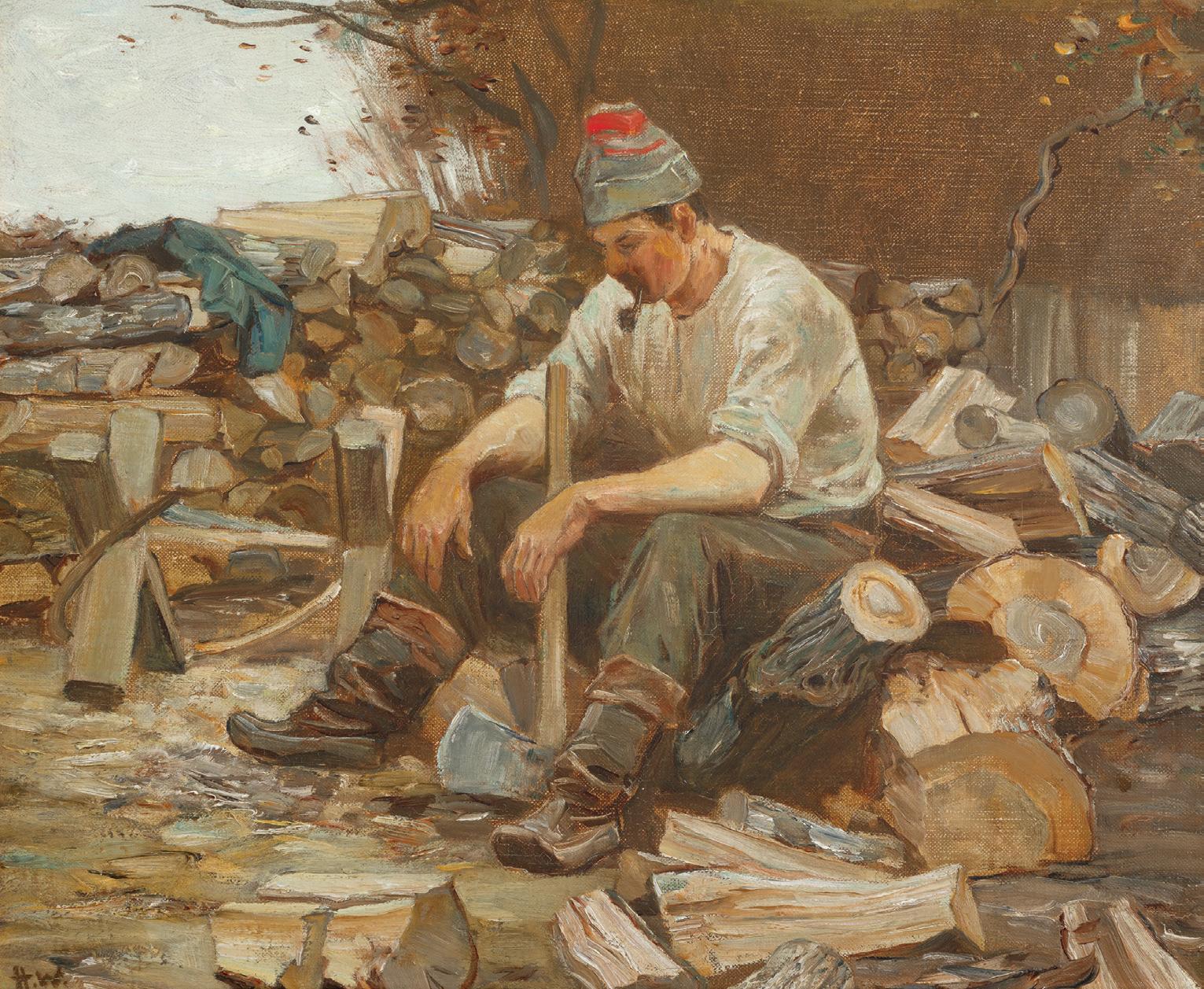
PROVENANCE
Laing Galleries, Toronto
H.R. Milner, Edmonton
Walter Klinkhoff Gallery, Montreal
Acquired by the present Private Collection, November 2002
EXHIBITED
The H.R. Milner Collection, Art Gallery of Edmonton, 1976, no. 64 Horatio Walker (1858-1938), Agnes Etherington Art Centre, Kingston, 17 December-28 January 1978, no. 39
LITERATURE
The H.R. Milner Collection, Art Gallery of Edmonton, 1976, no. 64 , reproduced Horatio Walker (1858-1938), Agnes Etherington Art Centre, Kingston, 1977, no. 39, listed page 49
Lyne Gravel, Les Oeuvres d’Horatio Walker, Musée du Québec, 1987, no. 106800
The Woodcutter, painted near the end of Walker’s most inventive and productive decade, is an example of how he reimagined, in a North American context, Jean-François Millet’s images of the French rural poor. Although the woodcutter is depicted as taking a temporary rest from his work (Walker more commonly followed Millet’s example
of showing his figures actively toiling), he is centrally placed on the canvas, and occupies almost its full height and width, thereby echoing Millet’s fondness for endowing his subjects with a physical grandeur that emphasized his veneration of their humble lives. The identity of Walker’s sitter is unknown, but his toque is identical to the one shown in a much earlier (1894) watercolour portrait of an exhausted, more aged woodcutter, Célestin Rousseau, seated‒like the labourer in The Woodcutter ‒amidst piles of logs and with his axe leaning against his leg (Le père Célestin , Musée nationale des beaux-arts du Québec). Like the man portrayed in The Woodcutter, Célestin Rousseau fills almost the entire image, emphasizing Walker’s admiration for local population whose lives were dominated by physical labour but who retained for him their interest as distinctive individuals.
The Woodcutter is set outdoors, but it would have been painted in Walker’s studio (either in Ste-Pétronille or New York) as was his practice, based on drawings made en plein air or using a local man as an in-studio model. The rich, flowing paint application, which draws attention to itself against the relatively flat background sky and trees, was a key factor in Walker’s appeal, occurring not only in his more romantic, emotional and larger-scale canvases but also here, in this comparatively modest‒in both size and subject matter‒image. As in all of his work, Walker conveys in The Woodcutter his intense sympathy for the lives of his French-Canadian neighbours and friends on Île d’Orléans.
We extend our thanks to Brian Foss, Carleton University Chancellor’s Professor of Art & Architectural History, and co‒curator of 1920s Modernism in Montreal: The Beaver Hall Group for his assistance in researching this artwork and for contributing the preceding essay.
$12,000–$15,000
COWLEY ABBOTT | An Important Private Collection of Canadian Art - Part II - Spring 2023 57
FRANK HANS JOHNSTON
Montreal River, Algoma, 1919
gouache on paper signed “Frank H. Johnston” lower left 15 ins x 15.25 ins; 37.5 cms x 38.1 cms
PROVENANCE
Roberts Gallery, Toronto
Acquired by the present Private Collection, circa 1966
EXHIBITED
Group of Seven Exhibition of Paintings, Art Museum of Toronto, 7‒27 May 1920, no. 50 as Froth Pattern, Below Rapids
A Reconstruction of The First Exhibition of the Group of Seven , 1‒31 May 1970, Art Gallery of Ontario, Toronto, no. 50 as Montreal River (?)
Le Groupe des Sept/The Group of Seven , The National Gallery of Canada, Ottawa, 19 June‒8 September 1970; travelling to Montreal Museum of Fine Arts, 22 September‒31 October 1970, no. 96
Collector’s Canada: Selections from a Toronto Private Collection , Art Gallery of Ontario, Toronto; travelling to Musée du Québec, Quebec City; Vancouver Art Gallery; Mendel Art Gallery, Saskatoon, 14 May
1988‒7 May 1989, no. 80 as Montreal River, Algoma
LITERATURE
F.H. Johnston, New York to Dr. James MacCallum, Toronto, 8 April 1915, Dr. James M. MacCallum Papers, Library and Archives of the National Gallery of Canada, Ottawa
F.H. Johnston, Toronto to Eric Brown, Ottawa, file 5.42 Johnston, Library and Archives, National Gallery of Canada, Ottawa “Etchings Predominate at Art Exhibition,” Daily Star (Toronto), 3 May 1919
F.H. Johnston, Hubert to Florence Johnston, Toronto, 1 October 1919, and 6 October 1919, Mary Bishop Rodrick and Franz Johnston Collection, R320, vol. 1-8, Library and Archives Canada, Ottawa [Fred Jacob], “Seven Artists Invite Criticism,” Mail and Empire (Toronto) 10 May 1920
Peter Mellen, The Group of Seven, Toronto, 1970, reproduced page 211, fig. 256 as Montreal River
Dennis Reid, Le Groupe des Sept/The Group of Seven , Ottawa, 1970, no. 96, reproduced page 138
Denis Reid, A Bibliography of the Group of Seven , Ottawa, 1971, page 73 Dennis Reid, Collector’s Canada: Selections from a Toronto Private Collection , Toronto, 1988, no. 80, page 73 reproduced as Montreal River, Algoma
Charles C. Hill, The Group of Seven Art: for a Nation , Ottawa, 1995, pages 83, 310
Roger Burford Mason, A Grand Eye for Glory: A Life of Franz Johnston , Toronto/Oxford, 1998, page 34
Joan Murray, Water: Lawren Harris and the Group of Seven , Toronto, 2004, reproduced page 78‒79
In April 1914 Frank Johnston left Toronto to seek work in New York and Philadelphia. Suffering from ill health, his efforts came to naught and he was back in Toronto by April 1916, when he again exhibited with the Ontario Society of Artists and reconnected with his former associates from the design firm Grip Ltd. and members of the Arts and Letters Club. In August 1918 he received a commission to draw and paint the activities of the flight training schools in southern Ontario for the Canadian War Memorials programme; however, a trip
to Algoma with Lawren Harris and J.E.H. MacDonald in October interrupted his war work and set him off on a new direction. “Our trip north was a great success – we struck new country in every respect and had a wonderful time sketching for all that was in us,” he wrote to Eric Brown, director of the National Gallery. “I returned with fifty three sketches – all sizes ranging from four to seven inches up to thirty thirty. We all came back without a regret as regards the amount of work we could do. Next time you are in Toronto I would like you to see them. Sir Edmund Walker seemed to like them well enough to ask if Harris, MacDonald and myself would hold a three man show in the Grange this coming spring, so we are going to keep the collection of sketches intact, and try and get a couple of big ones painted to include in the show.”
Johnston had fifty‒seven works in the Algoma exhibition at the Art Museum of Toronto in late April 1919, fifty-one sketches of varying dimensions, probably most in tempera, his favoured medium, and six larger canvases previously shown with the Ontario Society of Artists in March. The writer in the Toronto Daily Star admired Johnston’s contributions. “Mr. Johnston sees nature much as a huge decoration‒the blue and purple mountains with a glimpse of orange sky; the sparkle of autumn foliage against the molten grey of a placid lake‒he eliminates detail and finds wide unbroken expanses.”
In September 1919 Johnston returned to Algoma with Harris, MacDonald and A.Y. Jackson, the latter newly released from military duty. They painted at Hubert, Batchewana and the Montreal Falls along the route of the Algoma Central Railway. On 1 October Frank wrote to his wife in Toronto, “We have had two fine days in succession. Reds are gone but birch trees are hanging in. Forests are a mass of gold dotted with deep green spruce spiring up like cathedrals. … Mac & I went on a handcar to Montreal Falls where the big trestle is. We went under & down by the falls. I made my best sketch yet.” He wrote again on 6 October, “I was counting my sketches just before I started to write the letter and would you believe it‒fifty-seven … the reason is that we know where to find the stuff this year and it saves a lot of looking around. I have not very many panels left so I guess I will just
J.E.H. MacDonald Falls, Montreal River, 1920 oil on canvas, 121.9 x 153 cms 1933 Purchase, 2109 © Art Gallery of Ontario Not for sale with this lot

COWLEY ABBOTT | An Important Private Collection of Canadian Art - Part II - Spring 2023 58 127
do about one a day from now on, otherwise I will run out of material. I think one of the sketches I made today is possibly one of the best I have made up here, a very simple decorative type of thing but a good size 21 x 25.” Though it is hard to imagine the difficulties Johnston might have had painting in tempera on paper in the midst of the rapids’ spray, the dimensions he quotes suggest that in fact the temperas were painted on the spot and Montreal River might be the “best sketch” he referred to on 1 October.
It was on the same occasion that J.E.H. MacDonald painted the sketch that would be worked up into the canvas, Falls, Montreal River (Art Gallery of Ontario). Viewed from above the falls, the scale of the canvas enhances the impact of the violent flow of water while in Johnston’s painting he has daringly positioned himself in the midst of the roaring torrent. The almost square format enhances the decorative effect. The similarities and differences between the two paintings are striking.
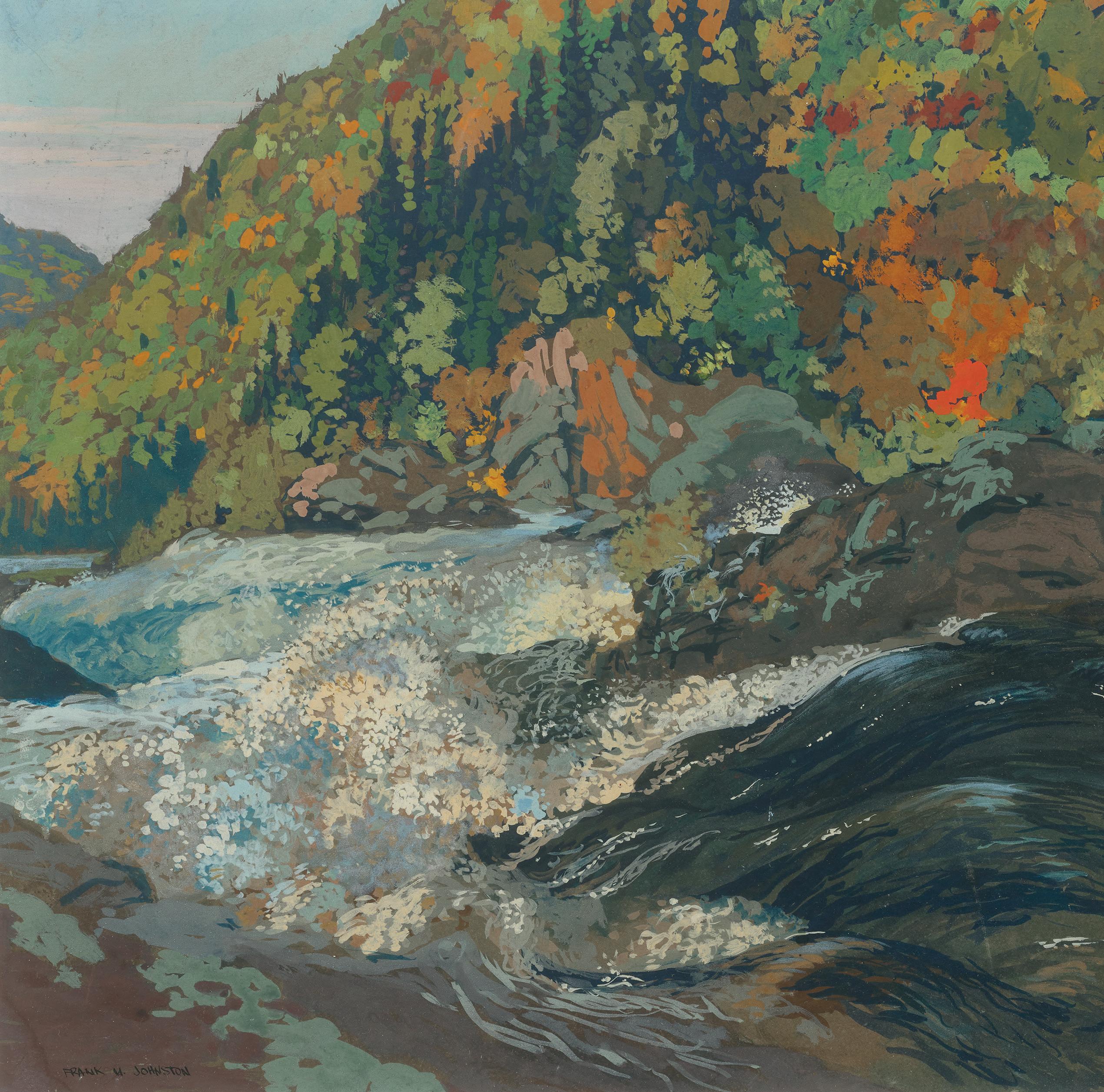
Johnston never exhibited a work titled Montreal River, Algoma , which is probably a description of the site provided by the family for one of the two Johnston exhibitions held at Roberts Gallery in the 1960s, where the current owners acquired this painting. Dennis Reid has suggested that it was in fact one of sixteen temperas Johnston showed in the first Group of Seven exhibition in May 1920 as Froth Pattern, Below Rapids
Johnston’s contributions were admired by Fred Jacob of the Mail and Empire. “The finest master of decorative art in this group is Frank H. Johnston. … He has a gift for finding subjects that show nature in a fanciful, or, at times, fantastic mood, and he catches the feeling exactly.”
Johnston was an amazingly prolific artist, as evidenced by his delight in his own production. Having encountered financial difficulties constructing a house in North Toronto, outside coverage of insurance companies and banks, in the fall of 1920 he moved his family to Winnipeg, where he taught at the city’s art school and directed the public gallery. In January 1922 he held an exhibition at the Winnipeg Art Gallery that included 326 works of which over 100 bore Algoma titles. In spite of the great number of Algoma subjects he painted, they remain relatively rare and most of the known works are decorative arrangements of trees and foliage against hills or sky. This dramatic view of the roaring falls appears to be unique.
We extend our thanks to Charles Hill, Canadian art historian, former Curator of Canadian Art at the National Gallery of Canada and author of The Group of Seven‒Art for a Nation , for his assistance in researching this artwork and for contributing the preceding essay.
$20,000–$30,000
COWLEY ABBOTT | An Important Private Collection of Canadian Art - Part II - Spring 2023 59
WILLIAM HENRY CLAPP
Old Houses, Berthier oil on canvas signed and dated 1912 lower right 20 ins x 24 ins; 50 cms x 60 cms
PROVENANCE
Galerie Walter Klinkhoff, Montreal
A.K. Prakash & Associates, Inc., Toronto
D & E Lake Ltd., Toronto
Acquired by the present Private Collection, December 1998
EXHIBITED
30th Spring Exhibition , Art Association of Montreal, 26 March‒19 April 1913, no. 64
Possibly Paintings by W.H. Clapp, A.R.C.A., Arts Club, Montreal from 7 February and Johnson Art Galleries, Montreal, 27 February‒28 March 1914, no. 98 as The Waterfront at Berthier
LITERATURE
Albert Laberge, “Ouverture de l’exposition de peintures à la galerie des arts,” La Presse (Montreal), 26 March 1913
Evelyn R. McMann, Montreal Museum of Fine Arts, formerly Art Association of Montreal Spring Exhibitions 1880-1970, Toronto, 1988, page 69 as Old house, Berthier
A.K. Prakash, Impressionism in Canada: A Journey of Rediscovery, Stuttgart, 2015, reproduced page 531 as Berthier, Quebec
Born of American parents in Montreal in 1879, William Clapp moved with his family to Oakland, California in 1885. He returned to Montreal in 1900 to study with William Brymner at the Art Association of Montreal. Fellow students included Clarence Gagnon and Henri Hébert and the three artists moved to Paris in the fall of 1904. There Clapp studied at the Académies Julian and Colarossi and the École de la Grande Chaumière. French and Spanish subjects were included in his submissions to the Art Association of Montreal’s Spring Exhibition in March 1908 when he shared the Jessie Dow Prize with Helen McNicoll. His winning painting, Morning in Spain , was purchased by the National Gallery of Canada.
In the catalogue of the 1909 Ontario Society of Artists exhibition Clapp’s address was given as 255 Bleury Street, a building owned by the sculptor G.W. Hill and where Edmond Dyonnet also lived. Clapp quickly moved into the milieu of the leading senior Montreal artists, painting at Philipsburg, where Maurice Cullen held the landscape classes of the Art Association of Montreal’s school, and at Saint Eustache, where William Brymner and Cullen had constructed a studio in 1905. His painting The New Church (National Gallery of Canada), shown in the 1910 Spring Exhibition, depicts the church of Saint Eustache.
In 1912 both Edmond Dyonnet and Clapp painted at Berthier (now Berthierville) on the north shore of the Saint Lawrence, between Trois-Rivières and Montreal. Dyonnet exhibited Early Morning, Berthier at the Royal Canadian Academy in November 1912 and Country Road, Berthier in the 1913 Spring Exhibition. The latter (sold Pinney’s, Montreal, 6 December 1988, lot X176) was illustrated in The Yearbook of Canadian Art 1913 published by Toronto’s Arts and
Letters Club. Clapp’s submissions to the same exhibition included the painting presented here, Old Houses, Berthier and it attracted the attention of Albert Laberge, sports and arts writer for the newspaper La Presse and the most sympathetic critic to the new generation. “The works by the so-called colorists‒Alex Jackson, Randolph Hewton, Albert H. Robinson, Arthur D. Rosaire, W.H. Clapp, Clarence Gagnon, among the youths, and Maurice Cullen, Suzor-Côté and a few others among the veterans, are the most remarkable and form the highlight of this year’s Salon. … The old houses of Berthier, a painting in a grey note … are a beautiful piece of painting, enough to tempt the connoisseurs.”
Laberge’s characterization of the painting as a being in a tone of grey is very apt. However it ignores the subtle play of blues, mauves, yellows, whites and greens and the animated brushwork used to depict the wooden balcony of the frame house with its metal chimney projecting upper right, the boards supporting the dock, the ladder and boat and foliage at right and left. It’s as if a mist veiled this delicate vision of a summer day in the village of Berthier.
Following a common practice among artists, Clapp recycled the original frame from Old Houses, Berthier, installing it on another canvas of the same dimensions, Rio Nuevas, Cuba , that was purchased by the National Gallery in 1915. An old label inscribed, “Old Houses, Berthier, W.H. Clapp, 255 Bleury St., Montreal,” can be found of the back of the frame on Rio Nuevas, Cuba
Clapp’s career had taken off with remarkable rapidity. He had been elected an Associate of the Royal Canadian Academy of Arts in November 1911, a member of the Canadian Art Club in 1912 and a member of Montreal’s Pen and Pencil Club in March 1913. His works were included in the exhibition of Canadian art at New York’s McDowell Club in March 1913 together with paintings by J.W. Beatty, William Brymner, Maurice Cullen, Clarence Gagnon, Wyly Grier, Lawren Harris, C.W. Jefferys and J.E.H. MacDonald, and from 27 February to 28 March 1914 he had a solo exhibition at the Arts Club of Montreal and subsequently at Johnson’s Art Galleries in Montreal. That exhibition included subjects from Spain, France, Phillipsburg and Berthier and this painting might have been included under the title The Waterfront at Berthier at $125, the same price he had asked in the 1913 Spring Exhibition.
Canada rallied to Britain’s side and declared war against Germany in September 1914. Male artists had to confront the decision to enlist or not, but as an American citizen Clapp was not under the same obligation, and by the spring of 1915 he had moved to Cuba, where he would remain for two years. Nancy Boas, author of The Society of Six California Colorists (San Francisco, 1988, page 50), in which Clapp figures prominently, writes that the catalyst for the move was the purchase by the artist’s father of a pineapple plantation at Isle of Pines in Cuba, rather than the war. By 1917 Clapp had moved back to California, becoming curator of the art gallery in Oakland the following year. In the 1930s he would exhibit in Montreal once again, at Watson Art Galleries.
We extend our thanks to Charles Hill, Canadian art historian, former Curator of Canadian Art at the National Gallery of Canada and author of The Group of Seven‒Art for a Nation , for his assistance in researching this artwork and for contributing the preceding essay.
$6,000–$8,000
COWLEY ABBOTT | An Important Private Collection of Canadian Art - Part II - Spring 2023 60 128
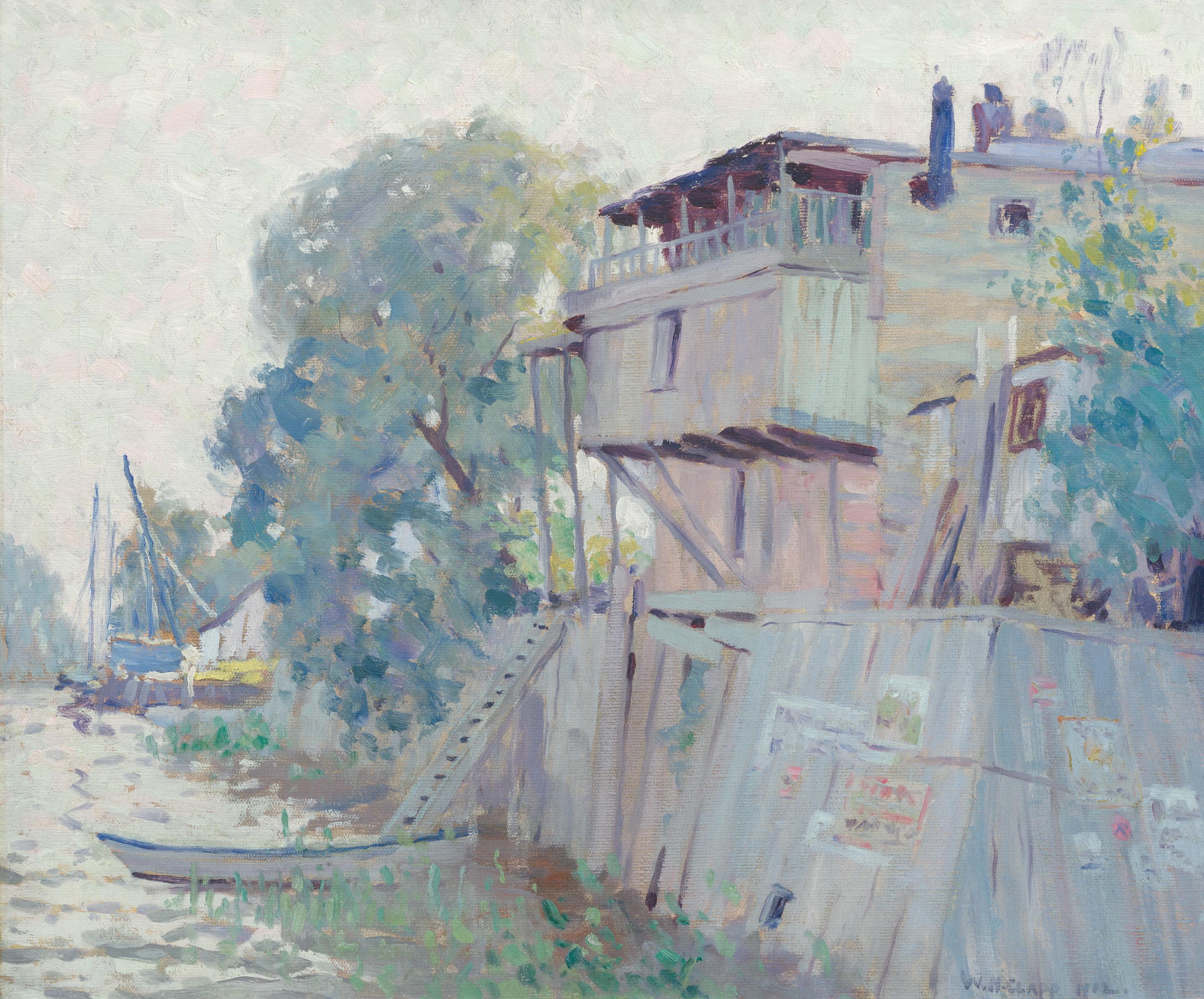
COWLEY ABBOTT | An Important Private Collection of Canadian Art - Part II - Spring 2023 61
ARTHUR LISMER
A September Gale, Georgian Bay, 1921 oil on wood signed and dated 1921 lower right; signed and titled on the reverse 11.5 ins x 16 ins; 28.8 cms x 40 cms
PROVENANCE
Private Collection, Toronto
Acquired by the present Private Collection, 1981
EXHIBITED
Collector’s Canada: Selections from a Toronto Private Collection , Art Gallery of Ontario, Toronto; travelling to Musée du Québec, Quebec City; Vancouver Art Gallery; Mendel Art Gallery, Saskatoon, 14 May 1988‒7 May 1989, no. 72
Hommage à Arthur Lismer, Galerie Walter Klinkhoff, Montreal, September 1997, no. 9
Beaver Tales: Canadian Art and Design , University of Toronto Centre, 16 September‒6 December 2008
The Group of Seven: Revelations and Changing Perspectives, McMichael Canadian Art Collection, 22 May‒20 September 2010
Painting Canada: Tom Thomson and the Group of Seven , Dulwich Picture Gallery, London; travelling to National Museum of Art, Architecture and Design, Oslo; The Groninger Museum, Netherlands; McMichael
Canadian Art Collection, Kleinburg, 19 October 2011‒28 October 2012, no. 49
Embracing Canada: Landscapes from Krieghoff to the Group of Seven , Vancouver Art Gallery; travelling to the Glenbow Museum, Calgary; Art Gallery of Hamilton, 29 October 2015‒5 September 2016
Collectors’ Treasures II/Trésors des collectioneurs, Annual Loan Exhibition, Galerie Eric Klinkhoff Inc., Montreal, 24 October‒7 November 2020, no. 22
LITERATURE
F.B. Housser, A Canadian Art Movement The Group of Seven , Toronto, 1926, pages 153-154, 177-178
Arthur Lismer, Outline for Picture Study, September Gale by Arthur Lismer, A.R.C.A., Ottawa, 1932
Barry Lord, “Georgian Bay and the Development of the September Gale Theme in Arthur Lismer’s Painting 1912-21,” in National Gallery of Canada Bulletin, Vol. V, nos. 1-2, (1967) pages 28-38, 49
Marjorie Lismer Bridges, A Border of Beauty Arthur Lismer’s Pen and Pencil, Toronto, 1977, page 28
Lois Darroch, Bright Land: A Warm Look at Arthur Lismer, Toronto/ Vancouver, 1981, pages 61‒62
Dennis Reid, Collector’s Canada: Selections from a Toronto Private Collection , Toronto, 1988, no. 72, reproduced page 67
Maria Tippett, Stormy Weather: F.H. Varley, A Biography, Toronto, 1998, pages 76‒79, 128‒129
Martha Kelleher, “In the Spirit of Nationalism,” in Beaver Tales Canadian Art and Design , Toronto, 2008, reproduced page 19
Katerina Atanassova, “Defining the North Searching for a Visual Language,” in Painting Canada: Tom Thomson and the Group of Seven , London, 2011, page 38, reproduced page 118
Charles C. Hill, “No Timid Play of Subtleties but Bold and Massive Design: the Group of Seven and the Canadian Landscape,” in Ian Thom, et al., Embracing Canada: Landscapes from Krieghoff to the Group of Seven , Vancouver/London, 2015, pages 86, 2015, reproduced page 99
The outbreak of war in 1914 proved devastating to Toronto’s graphic art industry where most of the future members of the future Group of Seven earned their livings. In the fall of 1916 Arthur Lismer left for Halifax to teach at the Victoria School of Art. The Halifax period proved to be productive, but he longed to return to Toronto and in fall 1919 he was appointed vice-principal of the Ontario College of Art. Teaching and administration proved to be demanding, leaving little time to paint. All of his works included in the first exhibition of the Group of Seven from 7 to 27 May 1920 had been previously exhibited.
However, even before the Group show had closed, Lismer, Lawren Harris and A.Y. Jackson left Toronto to paint around Mongoose Lake in Algoma with Dr. MacCallum. MacCallum then invited Lismer and Fred Varley to spend time at his cottage on Go Home Bay in Georgian Bay. Lismer had previously painted there in the fall of 1913 and spring 1915. On the latter occasion he painted the sketch for A Westerly Gale, Georgian Bay (sketch and canvas in the National Gallery of Canada, acc. nos. 4743 and 1368), a storm blown pine on a high foreground against open water and rocky islands, the precursor of A September Gale. Varley exhibited Georgian Bay canvases in the spring of 1917 resultant from a visit the previous year, and Maria Tippett has argued that his famous canvas, Stormy Weather, Georgian Bay (sketch and canvas in National Gallery of Canada, acc. nos. 4582 and 1814), resulted from this 1916 trip to the Bay. However, it is more likely that Lismer and Varley painted at Go Home Bay in the summer of 1920 and painted their respective canvases, September Gale and Stormy Weather, Georgian Bay, during the winter of 1920-1921. Both canvases are tributes to Tom Thomson’s West Wind (Art Gallery of Ontario, acc. no. 784) and were included in the Group of Seven exhibition in May 1921.
A September Gale was possibly the most ambitious painting Lismer had painted to date and was preceded by two oil sketches and one small canvas. Barry Lord has given the most complete discussion of the development of the final painting though the existence of the oil sketch being offered here was not known when he wrote in 1967.
A September Gale, Georgian Bay, 1920 oil on canvas, 51.5 x 61 cms
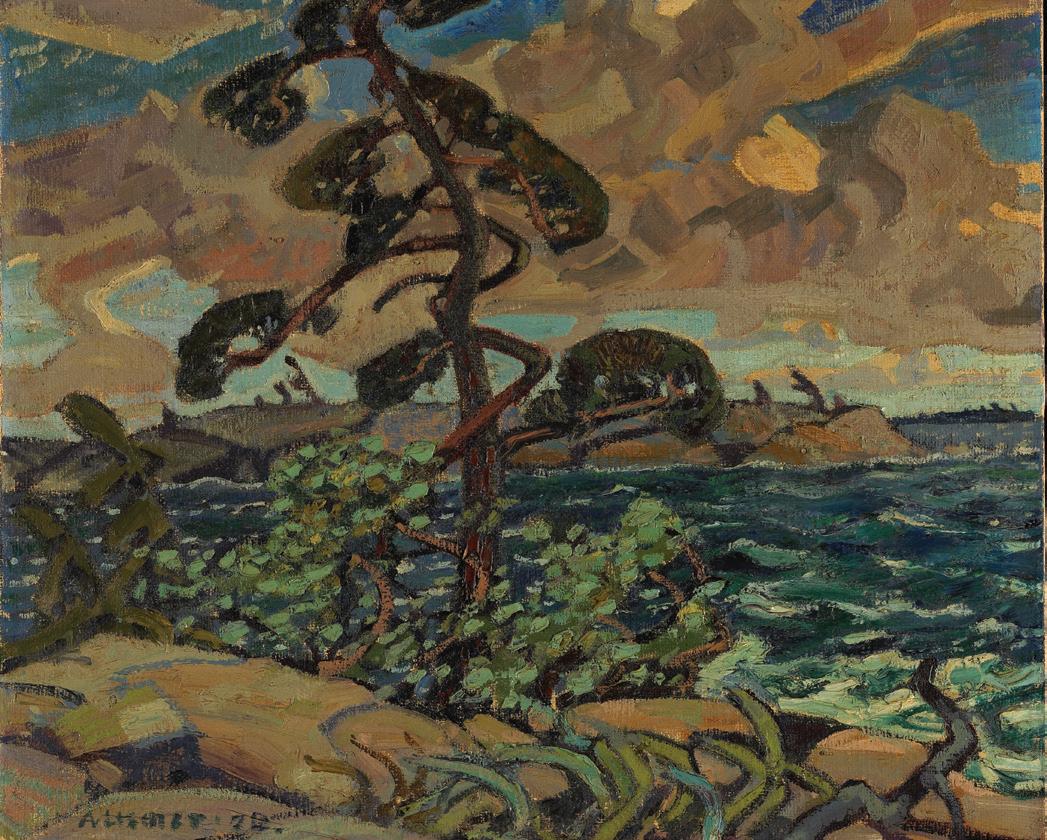
Vincent Massey Bequest, 1968
National Gallery of Canada
Not for sale with this lot
COWLEY ABBOTT | An Important Private Collection of Canadian Art - Part II - Spring 2023 62 129
Arthur Lismer

COWLEY ABBOTT | An Important Private Collection of Canadian Art - Part II - Spring 2023 63
Lord identified the oil sketch, dated 1920, now in the Vancouver Art Gallery, as the first study of the theme. The wind blown pine is rudimentarily sketched in and the wind blown clouds and sky dominate the composition. In the small canvas in the National Gallery, also dated 1920, the somewhat spindly tree takes centre stage, breaking the picture plane at the top, rising from behind the rocks rather than in the midst of them, reeds and a root are detailed lower right, and, as Lord writes, “Space is found for the two subsidiary tree forms to the left, although they remain quite flabby and inconclusive.”
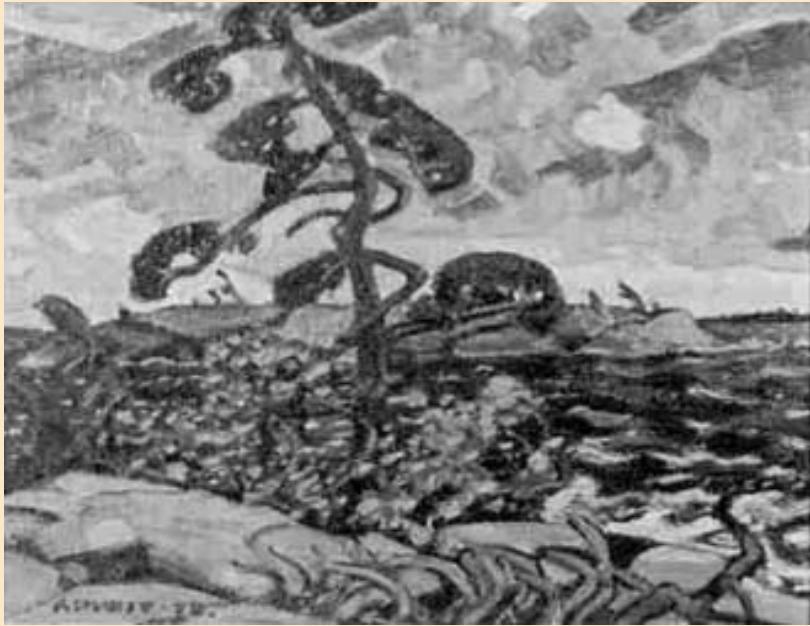
In the oil sketch being presented here, the tree is rooted in the rocks, surrounded by broadly sketched foliage, compressed between the upper and lower edges of the panel and the rocks lower left, energizing the landscape. The foreground root has been eliminated, the light is more luminous and the channel between the islands enlarged. The lessons learned in this superb sketch will be incorporated in the final canvas of 1921 in which the tree retains the simplified design and the compression of the sketch. The space is opened at the left further enlarging the “flabby” subsidiary trees, and the islands at the right become more distant. In enlarging the sketch forms have become more sculptural, as seen in the clouds and waves, in the rocks lower left and in the reeds that now bend in the wind.
Arthur Lismer has written most evocatively of this painting. “[A]mong the outer islands and shoals stretching far out into the main channel … the rocky islands are more broken and rugged, and the trees take on forms and shapes that result from the constant buffeting of storm and ice. The little pines have taken tenacious hold in clefts and crannies of the broken rock wherever they could send down a clinging root into the rare pockets of soil….'September Gale'… is essentially a picture of movement; everything in it is alive with related action or rhythm … it is like a nature symphony with clashing chords and deep undertones of menace – orchestration with many instruments striving to achieve a powerful expression.”

We extend our thanks to Charles Hill, Canadian art historian, former Curator of Canadian Art at the National Gallery of Canada and author of The Group of Seven‒Art for a Nation , for his assistance in researching this artwork and for contributing the preceding essay.
$100,000–$150,000
COWLEY ABBOTT | An Important Private Collection of Canadian Art - Part II - Spring 2023 64
Arthur Lismer
A September Gale, Georgian Bay, 1921 oil on canvas, 122.4 x 163 cms Purchased 1926 National Gallery of Canada Not for sale with this lot
Arthur Lismer September Gale, 1920 oil on panel, 30.3 x 40.4 cms The Parnell Bequest Vancouver Art Gallery (acc.no.2000.39.4) Not for sale with this lot
WILLIAM HENRY EDWARD NAPIER
Sleigh Riding, Montmorency Falls oil on canvas titled to a label on the reverse
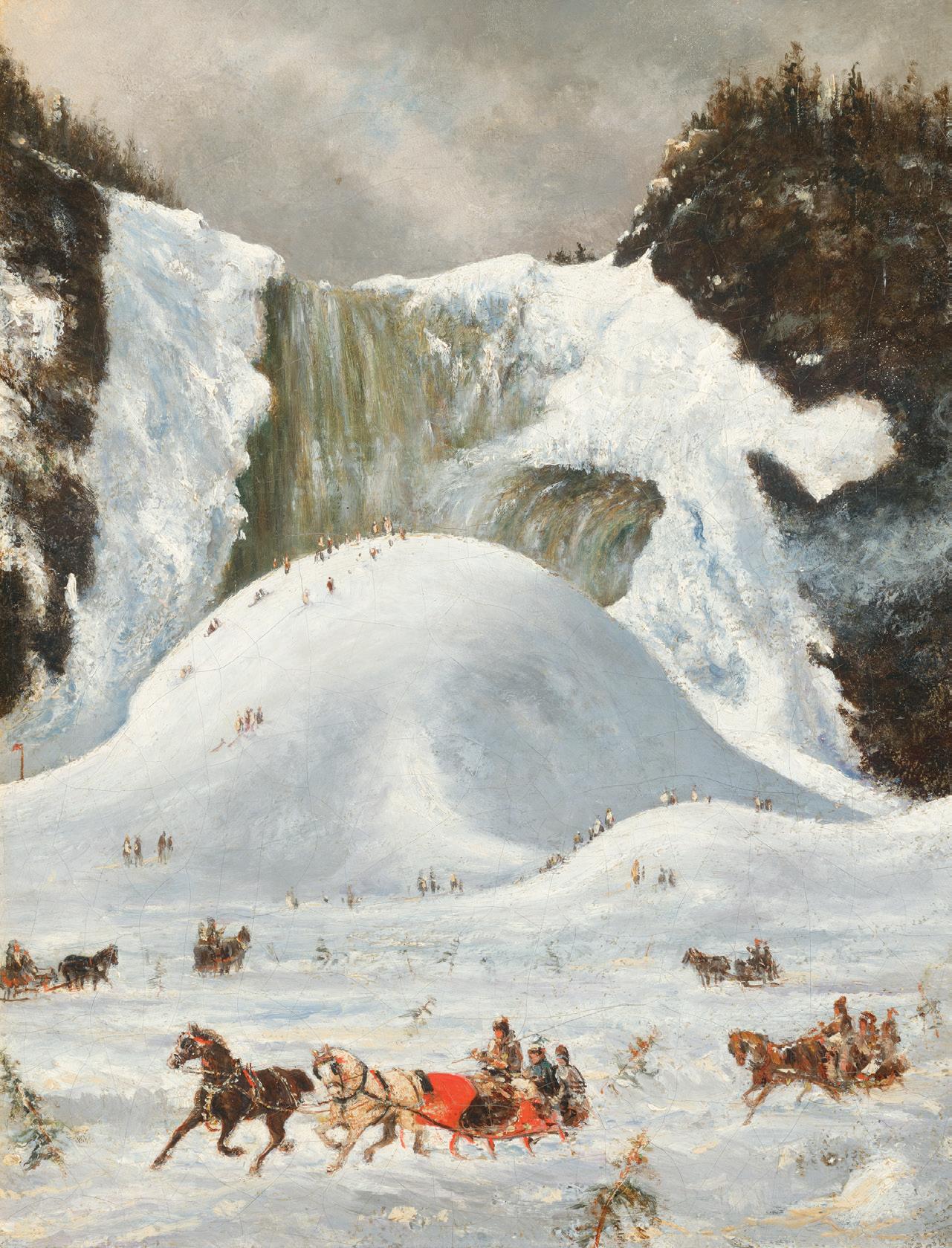
18 ins x 14 ins; 45 cms x 35 cms
PROVENANCE
Sotheby’s, auction, Toronto, 16 June 1998, lot 68
G. Blair Laing, Toronto
A.K. Prakash & Associates, Inc., Toronto Private Collection
William Henry Edward Napier was a watercolour artist known for his many works related to the Canadian West, who combined his chosen profession as engineer with a highly active pursuit of sketching for leisure. He was born in Montreal in 1828, the son of Duncan Campbell Napier, personal secretary to Lord Elgin, and secretary of the Indian Department, Lower Canada, and to Catherine Charlotte Wurtele.
Napier was trained as a civil engineer by brothers Walter and Frank Shanly, with whom he worked on several canal projects in the 1850s. In 1857, he also qualified as a professional land surveyor and in July of that same year was named to the Canadian Government’s Red River exploring expedition. As well as his professional qualifications, Napier’s alreadyknown artistic skills may have been a factor in his appointment. Napier was involved in the Expedition’s activities in what is now Northwestern Ontario and Manitoba until the spring of 1858, when he left the expedition. Many of the watercolours he executed during this period were preserved in an album of views collected by Thomas Evans Blackwell, Manager of the Grand Trunk Railway, entitled Reminiscences of North America , now held by Library and Archives Canada.
Napier’s many surviving sketches were mostly done while travelling for work or as records of the locales where he resided. It is not known with whom Napier might have trained as an artist, but his works demonstrate a keen eye for detail and the ability to capture scenes and individuals with great vivacity. His works survive in several different collections of his contemporaries. This suggests how much they appreciated his skill, and the fact that he may have given works away as gifts or used them for professional purposes.
Napier seems to have spent considerable time in Canada East (now Quebec) from 1858 onwards. He was the Resident Engineer at Trois-Rivières for the Grand Trunk Railway from 1860 to 1863, and then worked on projects in Europe from 1864-1866. He returned to Canada to work for the Intercolonial Railway, but he resigned in 1870, left Canada for
Scotland and thereafter gave up work as an engineer. He married Annie W. Robertson in December 1870, with whom he had four children. Although their primary residence was London, he died of apoplexy in Edinburgh on 2 August 1894.
There are no known paintings by Napier in any public collections, but several of his watercolours relating to Montmorency in winter are held by the Royal Ontario Museum. The ice cone at Montmorency was a well-known 19th century phenomenon caused by the build up of snow and ice from the spray thrown up by the falls. It attracted many visitors for the sensation of climbing the cone and sliding down, combined with the pleasure of the sleigh ride from Quebec City either singly or as part of sleigh club outings. The painting is notable for its inclusion of fir trees which marked the winter road over the ice between Montmorency and Quebec City. The Ice Cone was also a popular subject for other Quebec painters, including Cornelius Krieghoff and Robert C. Todd, among others.
We extend our thanks to Jim Burant, art historian and curator, for contributing the preceding essay. He spent four decades with the art and photo holdings of Library and Archives Canada. He has organized or co‒organized many exhibitions and has written and lectured widely about aspects of Canada’s visual heritage, his most recent publication being about the History of Art in Ottawa, published by the Art Canada Institute. He was awarded the Queen’s Golden Jubilee Medal for services to Canada in 2002, and is a member of the Algonquins of Pikwàkanagàn First Nation.
$3,000–$5,000
COWLEY ABBOTT | An Important Private Collection of Canadian Art - Part II - Spring 2023 65 130
MARC-AURÈLE DE FOY SUZOR-COTÉ
Old Pioneer/Jean-Baptiste Cholette oil on canvas
signed and dated 1918 lower right 27 ins x 20 ins; 67.5 cms x 50 cms
PROVENANCE
The Artist
Eugénie Farmer Saint-Jean, niece of the artist, Montreal Private Collection, Toronto
EXHIBITED
35th Annual Spring Exhibition , Art Association of Montreal, 4‒27 April 1918, no. 341 as Type canadien, étude at $500
40th Royal Canadian Academy of Arts Exhibition , Art Association of Montreal, 21 November‒21 December 1918, no. 186 as Type canadien, étude
42nd Annual Spring Exhibition , Art Association of Montreal, 2‒26 April 1925, no. 264 as Jean-Baptiste Cholette at $1,000
Exhibition of Canadian Art, Whitechapel Art Gallery, London, 26 November‒23 December 1925, no. 89 as Jean-Baptiste Cholet
British Empire Exhibition of Canadian Art, Corporation
Art Gallery, Oldham, 12 June‒10 July 1926, no. 88 as Jean-Baptiste Cholet
Manchester Exhibition of Canadian Pictures, Queen’s Branch Art Gallery, Manchester, 28 August‒9 October 1926, no. 180 as Jean-Baptiste Cholet
50th Royal Canadian Academy of Arts Exhibition , Art Gallery of Toronto, 29 November 1927‒8 January 1928, no. 148 as J. B. Cholet, Old Pioneer
4th Annual Exhibition on Canadian Art, National Gallery of Canada, Ottawa, 28 January‒28 February 1929, no. 151 as J. B. Cholet, Old Pioneer
Royal Canadian Academy of Arts Exhibition , Imperial Art Gallery, South Kensington, 6 April‒29 June 1929, no. 132 as J. B. Cholet, Old Pioneer
Rétrospective Suzor-Coté, École des beaux-arts de Montréal, 3‒20 December 1929, no. 40 as Jean-Baptiste Cholet
Rétrospective Suzor-Coté, Galerie l’Art vivant, Montreal, 3‒21 December 1964, no. 6 as Le Père Cholette
Rétrospective Suzor-Coté, Centre d’art de Trois-Rivières, Trois-Rivières, 28 January‒6 February 1966, no. 12 as Père Cholette
Suzor-Coté Retour à Arthabaska , Musée Laurier, Arthabaska, 31 May‒27 September 1987, no. 45
LITERATURE
“Artists Young and Well-known,” The Herald , 5 April 1918
Laurier Lacroix, Suzor-Coté Retour à Arthabaska , Musée
Laurier, Arthabaska, 1987, no 45, reproduced page 38
Laurier Lacroix, Suzor-Coté: Light and Matter, National Gallery of Canada, Ottawa, 2002
Arthabaska remains the focal point of inspiration for Marc-Aurèle de Foy Suzor-Coté on his final return from France in the summer of 1907. Not only does he celebrate his native country in sublime winter landscapes, but he creates a gallery of portraits of the settlers who cleared out the region. The first one whom he depicted is Esdras Cyras in 1908. He is undoubtedly the best known, having been the subject of many drawings, paintings and sculpture works.
If he exposes this kind of subject from 1910, he only uses generic titles (for example, One of Arthabaska’s Settlers, Old French Canadian Pioneer, Portrait of a Habitant) to designate them. He thus seeks to name a “race” of pioneers without distinguishing between their character. Only beginning in 1925 do we see the appearance of the proper names of its models, which identify several of the models depicted from the elderly population of Arthabaska.
Expanding his circle of models, Suzor-Coté took advantage of a stay with his brother Eugène Côté in Curran, Ontario, to sketch the features of Jean-Baptiste Cholet (or Cholette) in profile in 1916. The grid drawing was used to produce this oil painting and a pastel work (MNBAQ). The same model poses, this time from the front, for another pastel drawing dated 1922 (MNBAQ, repr. Lacroix 2002, page 257). It bears mentioning that the subject attracts attention because of his large sideburns, which surround his face and characterize its physiognomy. The furrowed and sun-chiselled features, as well as the bushy eyebrows define the personality of this otherwise austere man.
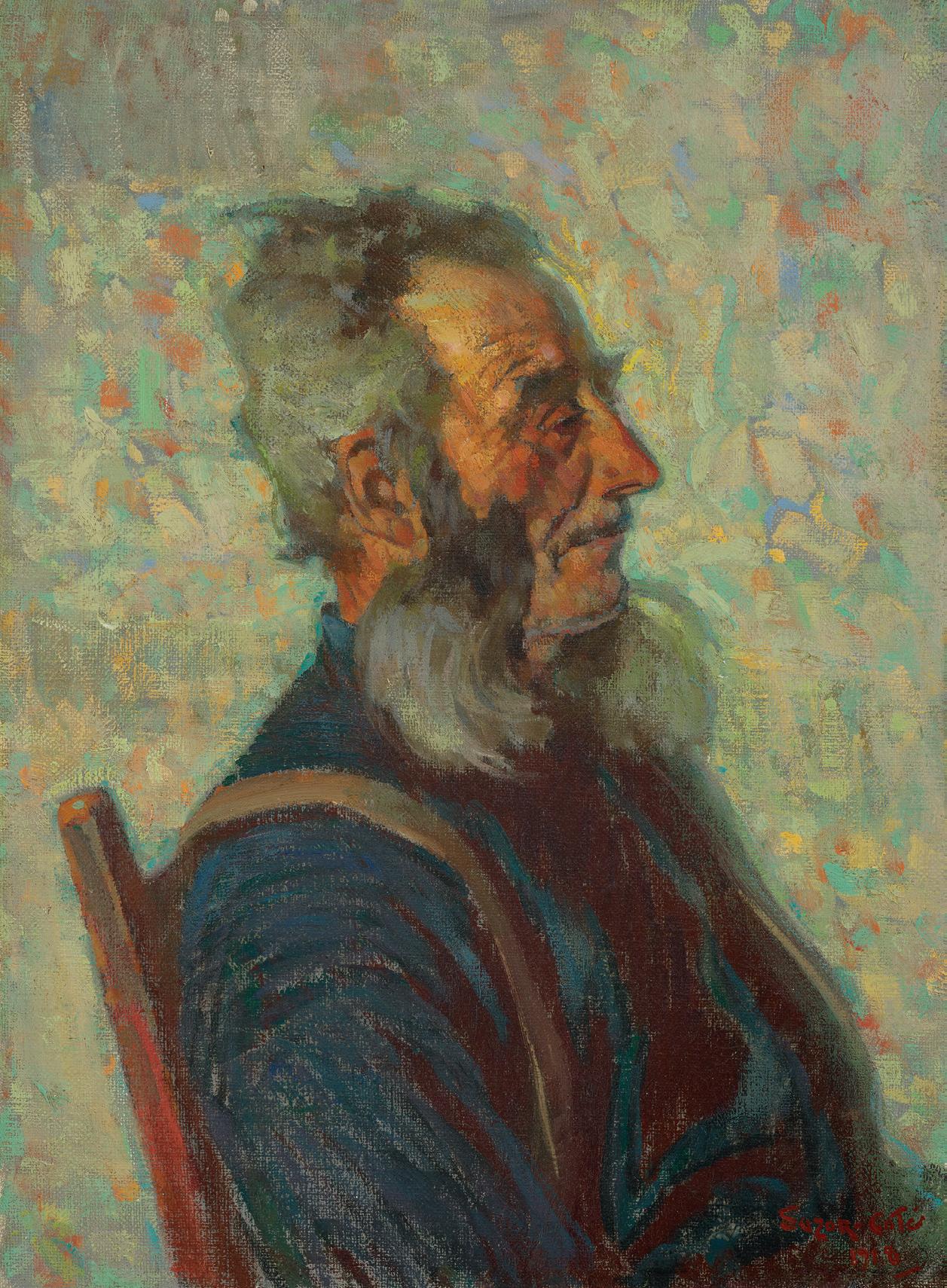
COWLEY ABBOTT | An Important Private Collection of Canadian Art - Part II - Spring 2023 66 131
The simplicity of the treatment of the dark blue shirt contrasts with the treatment of the background, where strokes of brown, green and pale yellow harmonize together. This loose approach differs from the more structured mosaic backgrounds found in the same period (see Magdalena , 1921). Here, the artist experiments with brushwork, a free choreography in which the symbols are juxtaposed in no particular sequence.
Is it a wallpaper that inspired this sweeping of space, defined as pure painting? Still, the novelty of this use is not noticed; contemporary observers focus instead on the model as "a study of a rugged old man".
The artist featured this composition on one of his business cards during the 1920s when it was featured in several exhibitions. It also hung high on a wall of a room during the major retrospective of 1929 at the École des beaux-arts de Montréal.
We extend our thanks to Laurier Lacroix, C.M., art historian, for his assistance in researching this artwork and for contributing the preceding essay.
$60,000–$80,000
132
OCTAVE HENRI JULIEN
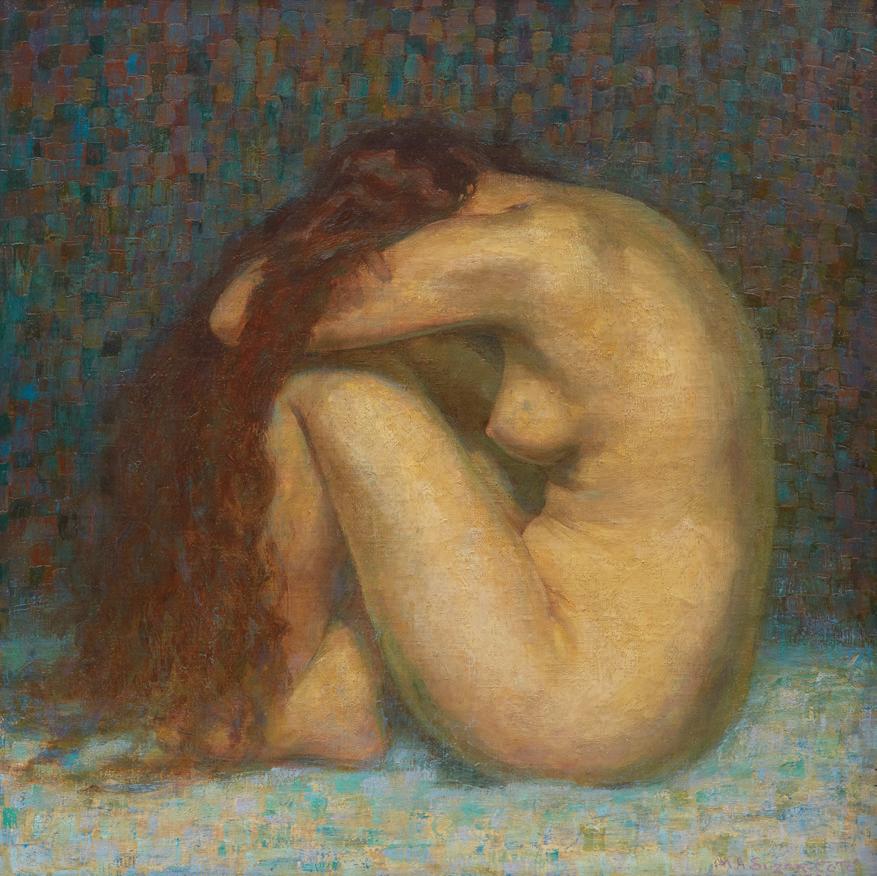
The Woodcutter oil on board signed and dated 1906 lower left 12.5 ins x 8.5 ins; 31.3 cms x 21.3 cms

PROVENANCE
Private Collection
Henri Julien studied at the Abbot Joseph Chabert’s art school in Ottawa, however his art career began in the 1860s as an engraver and lithographer for newspapers. He quickly became the best-known newspaper illustrator and political cartoonist in Canada. In 1888 he became artistic director at the Montreal Daily Star, which thus became the first Canadian newspaper to employ a full-time editorial cartoonist. Julien stayed with the paper for twenty-two years illustrating historical and journalistic pieces, as well as drawing caricatures of members of Parliament in the House of Commons. His best known work was of rural French Canadians, which he began depicting around 1875 and continued for the rest of his life. As of the year 1900, Julien also took up painting, receiving many commissions for scenes of French Canadian culture and regularly exhibiting with the Royal Canadian Academy of Arts. He was a remarkably versatile visual artist, as he was able to alternate between various painterly styles. In The Woodcutter, dating to 1906, a French-Canadian Habitant is smiling and smoking a pipe while hard at work sawing. This charming winter scene is an example of a small number of oil paintings, in addition to many drawings and watercolours, that Julien created to illustrate the Habitants’ daily life and character.
$6,000–$8,000
COWLEY ABBOTT | An Important Private Collection of Canadian Art - Part II - Spring 2023 67
Marc-Aurèle de Foy Suzor-Coté, Magdalena, 1921 oil on canvas, 105.41 x 105.41 cms Included in Cowley Abbott’s Spring Live Auction, Session 1, 8 June 2023 Not for sale with this lot
JAMES EDWARD HERVEY MACDONALD
Morning Sunshine, 1926 oil on wood‒pulp board signed, titled and inscribed “Thornhill June 1926” on the reverse; with monogram “JM”, also certified by Thoreau MacDonald on a label 8.5 ins x 10.5 ins; 21.3 cms x 26.3 cms
PROVENANCE
Mr. and Mrs. A. Crawford Kenny, Toronto Mrs. A.C. Kenny, Toronto Framing Gallery, Toronto
Acquired by the present Private Collection, 1969
EXHIBITED
Collector’s Canada: Selections from a Toronto Private Collection , Art Gallery of Ontario, Toronto; travelling to Musée du Québec, Quebec City; Vancouver Art Gallery; Mendel Art Gallery, Saskatoon, 14 May 1988‒7 May 1989, no. 60
Home Truths, The Robert McLaughlin Gallery, Oshawa; travelling to Mississauga Living Arts Centre; Rodman Hall, St. Catharines, 4 September 1997‒22 February 1998
The Thornhill Circle: J.E.H. MacDonald and his Associates, Varley Art Gallery, Markham, 26 November 2006‒14 January 2007 as Morning Sun (The Artist’s Wife)
LITERATURE
J.E.H. MacDonald, Thornhill to E.R. Greig, Art Museum of Toronto, 21 July 1915 in Art Museum of Toronto Letters 1912-1920, A3.9.5, in Edward P. Taylor Library and Archives, Art Gallery of Ontario, Toronto
Thoreau MacDonald, Thornhill to Doris Mills, 2 August 1923, in Doris Speirs Collection, MS Coll 00319, Thomas Fisher Rare Book Library, University of Toronto
Rental payments 8 June 1925 to 27 March 1926, in Mary Bishop
Rodrick and Franz Johnston Collection, vol.1, file 36 Financial 19231925, R320, Library and Archives Canada, Ottawa
F.H. Johnston, Thornhill to H.O. McCurry, National Gallery of Canada, Ottawa, 17 February 1926, in 5.5-Annual Exhibition of Canadian Art 1926, Library and Archives of the National Gallery of Canada, Ottawa
Dennis Reid, Collector’s Canada: Selections from a Toronto Private Collection , Toronto, 1988, no. 60, reproduced page 60
“Chronology,” in Robert Stacey and Hunter Bishop, J.E.H. MacDonald
Designer: An Anthology of Graphic Design, Illustration and Lettering, Ottawa, 1996, pages 115-126
Joan Murray, Home Truths, Toronto, 1997, plate 25, reproduced page 45
John Sabean, A Boy All Spirit: Thoreau MacDonald in the 1920s, Penumbra Press, 2002, pages 19-22, 173, 258 note 12
Stantec Consultants, Untangling the Tangled Garden Historical Research of the Thoreau MacDonald Property 121 Centre Street, Thornhill, City of Vaughan, Markham, 2004
Christopher Jackson, The Thornhill Circle: J.E.H. MacDonald and his Associates, Markham, 2006, page 35, reproduced page 17
J.E.H. MacDonald’s house at Thornhill, then a small farming village north of Toronto, is intimately associated with his career and fame as an artist. For it was behind this house that MacDonald painted the studies for his famous painting, A Tangled Garden , the painting that became a focus of journalistic rebuke when shown in the 1916 exhibition of the Ontario Society of Artists. The painting and the resultant debates have rightly been seen as landmarks in the history of the future Group of Seven. By extension the house has also been intimately linked to the Group’s story.
Born in Durham, England in 1873 of a Canadian father and English mother, J.E.H. MacDonald came to Canada with his family in 1887. In 1899 he married Joan Lavis and the couple, and their son Thoreau, born in 1901, first lived on Quebec Avenue, and then Conduit Street, north of High Park in what was then known as Toronto Junction. The family moved to Thornhill in 1913 renting a house on Centre Street from fellow artist Eugene Beaupré. When Beaupré moved back to Thornhill the following year, MacDonald paid the deposit for the purchase of a farm of four acres with a frame house and barns and outbuildings on the south side of Centre Street, hoping to sell his Conduit Street property to raise the required funds. “Then the war came. There was no opportunity to sell the city property, no commercial designing was wanted & my capital has gradually dwindled, until the bottom of the bin is only too plainly visible. During the past year I have been able to make about 12.00 per week,” he wrote in his appeal to the Art Museum of Toronto for assistance with selling the city house. “The Thornhill place will not be such a drain this year, as Lismer is living with me cooperatively & we are working part of the place ourselves the rest of it being rented to a farmer.” A photograph of Joan MacDonald, Esther and Marjorie Lismer with Thoreau and his bicycle in the background was taken that summer. The Lismers found another house to rent on John Street in Thornhill in September 1915, just as MacDonald painted the oil sketch of luxuriant flowers against the stable wall that would result in the painting The Tangled Garden
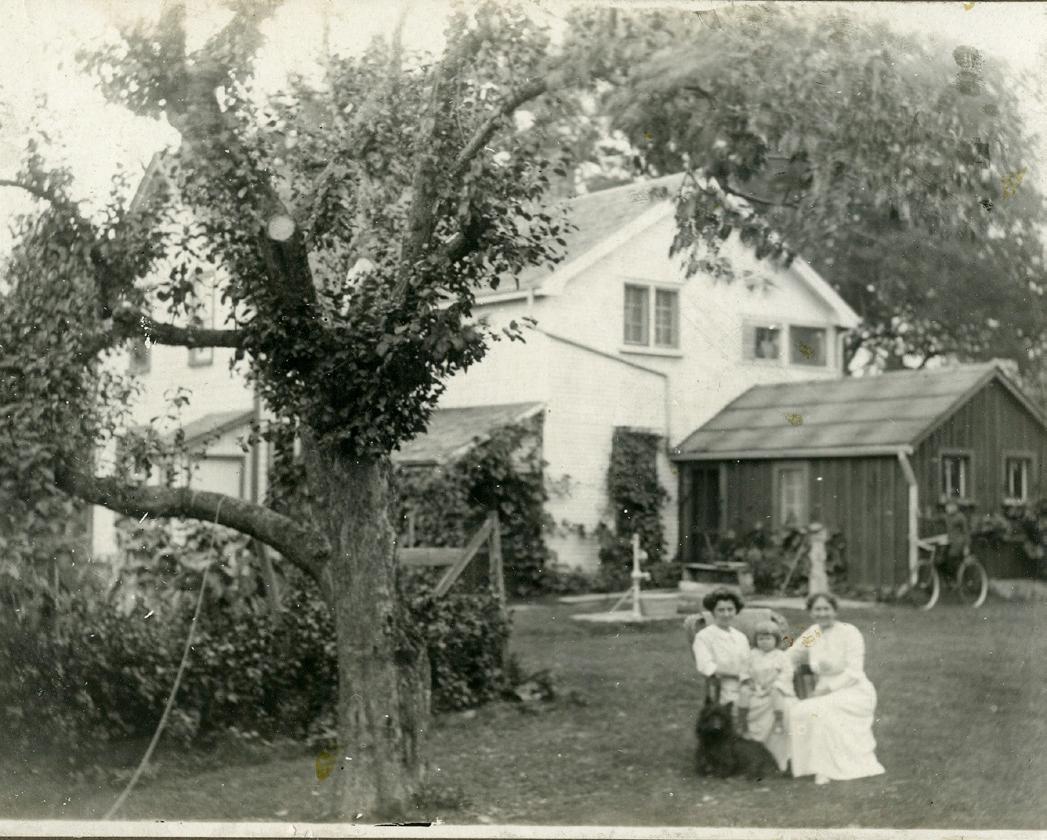
COWLEY ABBOTT | An Important Private Collection of Canadian Art - Part II - Spring 2023 68 133
Esther and Marjorie Lismer, with Joan and Thoreau MacDonald, at the home of J.E.H. MacDonald in Thornhill, Ontario, 1915 Arthur Lismer Collection
McMichael Canadian Art Collection Archives Not for sale with this lot
The farm continued to be a financial burden, and in November 1917, it was rented out and the MacDonald family moved to York Mills, where MacDonald suffered a physical breakdown. By 1923 the family was back in Thornhill though it was rented to Frank Johnston and his family from June 1925 to March 1926. Johnston wrote to the National Gallery of Canada from Thornhill on 17 February 1926 complaining about the rejection of his painting One Fine Day and the Gallery’s purchase of Arthur Lismer’s September Gale. By June 1926 the MacDonald family had moved back to the farm they called Four Elms.
J.E.H. MacDonald’s painting of his wife Joan in the backyard of the farmhouse may be a celebration of the family’s return to Thornhill. Wearing a yellow straw hat with a white shawl or blanket over her knees, Joan MacDonald sits in her rocking chair reading. Thoreau’s delivery in 1901 had been difficult and she was a partial invalid for
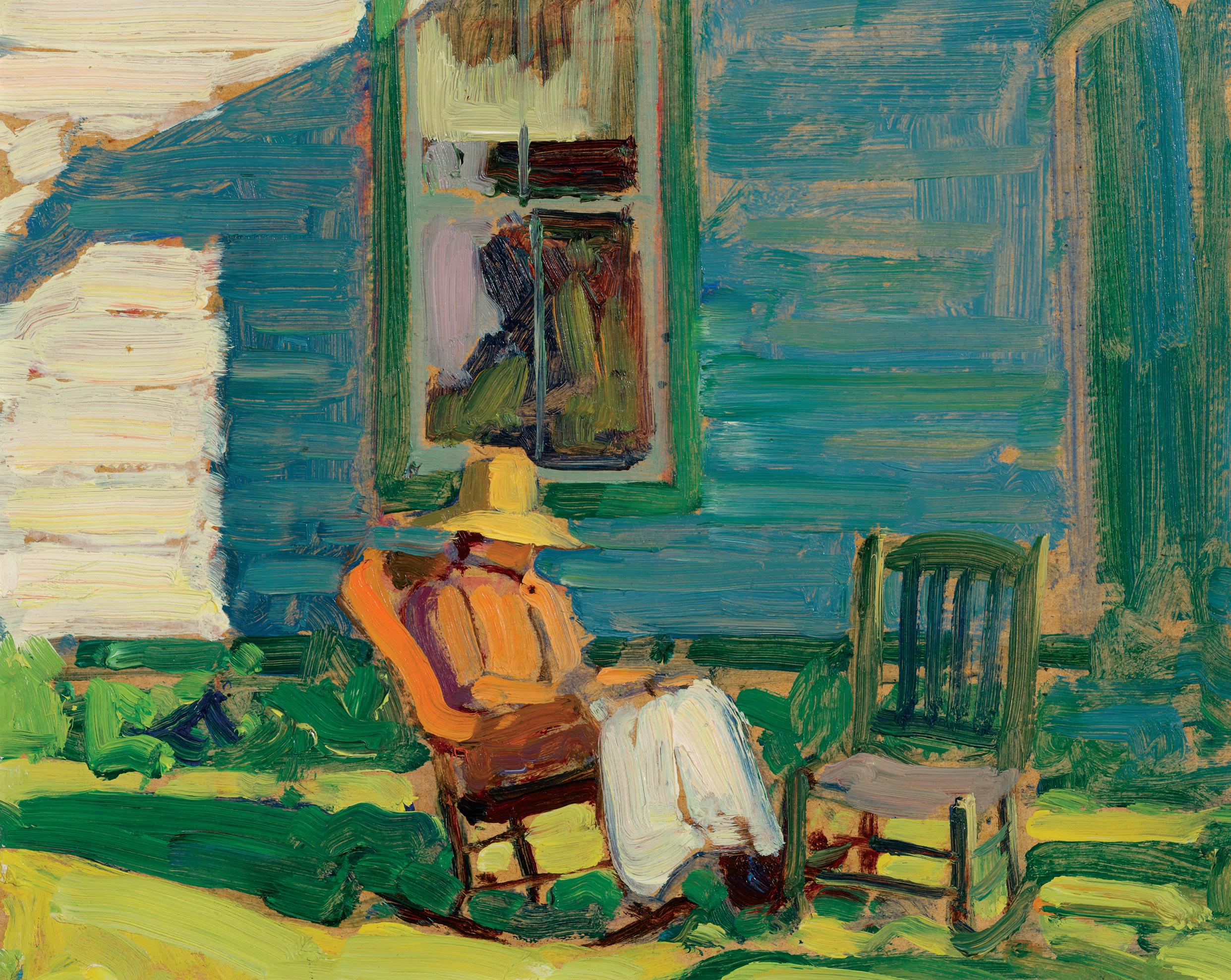
most of her long life. An empty chair awaits her companion, possibly the artist painting her. The figure, chairs, garden foliage, window and shadows on the wall of the frame house are broadly painted in a palette of sunlight. Morning Sunshine is an affectionate tribute to the artist’s wife and to the home that played such an important role in their lives.
We extend our thanks to Charles Hill, Canadian art historian, former Curator of Canadian Art at the National Gallery of Canada and author of The Group of Seven‒Art for a Nation , for his assistance in researching this artwork and for contributing the preceding essay.
$50,000–$70,000
COWLEY ABBOTT | An Important Private Collection of Canadian Art - Part II - Spring 2023 69
ALEXANDER YOUNG JACKSON
Oak and Birch
oil on panel
signed lower right; signed, titled, dated 1920, inscribed “Oak and Birch 3/ Georgian Bay” and NJG Inventory No. 1353 on the reverse 8.5 ins x 10.5 ins; 21.3 cms x 26.3 cms
PROVENANCE
The Artist
Geneva Jackson, Kitchener, ON
The Artist (?)
Marion MacCallum, Montreal
Acquired by the present Private Collection, April 1981
EXHIBITED
Collector’s Canada: Selections from a Toronto Private Collection , Art Gallery of Ontario, Toronto; travelling to Musée du Québec, Quebec City; Vancouver Art Gallery; Mendel Art Gallery, Saskatoon, 14 May 1988‒7 May 1989, no. 66
Annual Group of Seven Dinner Featuring Works of Art by Alexander Young Jackson , The York Club, Toronto, 17 February 1999
Embracing Canada: Landscapes from Krieghoff to the Group of Seven , Vancouver Art Gallery; travelling to the Glenbow Museum, Calgary; Art Gallery of Hamilton, 29 October 2015‒5 September 2016
LITERATURE
A.Y. Jackson, Penetang to Florence Clement, Kitchener, postmarked 7 (?) February 1920, and 26 March 1920, in Naomi Jackson Groves fonds, Library and Archives Canada, Ottawa (MG30 D351, box 95-9)
A.Y. Jackson, A Painter’s Country, Toronto, 1958, pages 49-51
Dennis Reid, Collector’s Canada: Selections from a Toronto Private Collection , Toronto, 1988, no. 66, reproduced page 63
Ian Thom, et al., Embracing Canada: Landscapes from Krieghoff to the Group of Seven , Vancouver/London, 2015, reproduced page 117, caption page 201
Douglas Hunter, Jackson’s Wars: A.Y. Jackson, the Birth of the Group of Seven and the Great War, Montreal/Kingston, 2022, pages 320-322, 332-333
After almost four years with the Canadian Expeditionary Force in England and France, A.Y. Jackson returned to Canada waiting to be sent to Siberia with the Canadian troops. For this he purchased a stock of white paint before he was finally discharged in Canada on 16 April 1919. In September he made his first visit to Georgian Bay since 1913, returning the following February, snowshoeing in from Penetanguishene to Franceville. Caught in a storm en route, he wrote to his cousin Florence Clement, “… getting in to Franceville is not easy. … when I did get started after lunch it had got dull and cloudy, and by the time I got past the light house it started to snow … and I decided I didn’t want a memorial exhibition until I had a few more extreme canvases, blue, green violet and yellow snow, as it is of course, but not yet realized by the general public. I waited an hour for it to clear and it only came down thicker, and as there was no road to follow, I finally ‘bout turned. It cleared up just as I got back and is trying to look pleased with itself at present. Tomorrow morning if it’s decent I’ll try again.” Weather and ice conditions were a constant preoccupation, and on 26 March he again wrote to Florence Clement. “Well I got here after writing you from Penetang … and settled down for the winter. And it has been real Canuck stuff. My colors friz, followed by me, but now it is soft and mushy and there is only snow in the woods. … It’s a wonderful sketching ground in winter. On sunny days it makes little difference in which direction one goes. I made a lot of sketches round Muskosh, a few on Bone Island, Burnt Island, and Portage Id., round Loon Basin.… First I snow shoed sketching, then I skated, now I walk, and soon will go in a boat. Just now you don’t know how to go. The Freddy [Channel] is open water, likewise Shadow River and Pike Channel and Bone Point. … I’ll show you the prevailing colors up here when I return about Apl 20th if possible. You never know just what the ice will do. Most of my Siberian white has been spread on and a lot of blue.”
From the simplest of motifs, young leafless oaks and a birch on the edge of the icy expanse, Jackson created a decorative arrangement recalling his pre-war Algonquin canvases and Tom Thomson’s West Wind , though in a less dramatic vein. Painted in his desired palette of “blue, green violet and yellow”, a mossy rock breaks through the snow lower left and blue shadows dance across the yellow snow. Russet and green trees on the far shore, edged in lighter blue, crown the sinuous foreground arrangement. With a surprising lightness of touch, Jackson has given us a glimpse of the beauties and joys of late winter.
Jackson had a long and affectionate friendship with his aunt Geneva Jackson of Kitchener. It was she who first acquired this sketch and possibly, Jackson received it back from her estate in the early 1950s. Jackson’s popularity with his public from the 1940s resulted in numerous commissions for specific subjects, including canvases painted from earlier sketches. At an unknown date, this sketch was worked up in a canvas that Jackson identified as “From sketch made 1920”.
We extend our thanks to Charles Hill, Canadian art historian, former Curator of Canadian Art at the National Gallery of Canada and author of The Group of Seven‒Art for a Nation , for his assistance in researching this artwork and for contributing the preceding essay.
$30,000–$50,000
COWLEY ABBOTT | An Important Private Collection of Canadian Art - Part II - Spring 2023 70 134

COWLEY ABBOTT | An Important Private Collection of Canadian Art - Part II - Spring 2023 71
EMILY CARR
Deep in the Forest, 1935 oil on paper, mounted to canvas signed lower right 33 ins x 23.75 ins; 82.5 cms x 59.4 cms
PROVENANCE
The Artist
Arthur Lismer, 1936
Gordon MacNamara, Toronto, circa 1938
William Sayer
Odon Wagner
Purchased by the present Private Collection, December 1990
EXHIBITED
Emily Carr: Her Paintings and Sketches, Art Gallery of Toronto/ National Gallery of Canada, 19 October 1945‒26 May 1946, no. 162 as Trees (loaned by Gordon MacNamara)
Canadian Women Artists, Riverside Museum, New York, 1947, no. 9
Emily Carr Retrospective Exhibition , Walter Klinkhoff Gallery, Montreal, 2002, no, 16
From the Forest to the Sea, Emily Carr in British Columbia , Art Gallery of Ontario, Toronto and Dulwich Picture Gallery, London, 1 November 2014‒12 July 2015
LITERATURE
Emily Carr: Her Paintings and Sketches, Art Gallery of Toronto/ National Gallery of Canada, 1945, no. 162, listed page 59
Edythe Hembroff‒Schleicher, Emily Carr: The Untold Story, Saanichton, 1978, pages 131‒132
Emily Carr Retrospective Exhibition , Walter Klinkhoff Gallery, Montreal, 2002. no. 16, reproduced page 6
Emily Carr, Hundreds and Thousands: The Journals of Emily Carr, Vancouver, 2006, page 264
Sarah Milroy and Ian Dejardin, From the Forest to the Sea, Emily Carr in British Columbia , Art Gallery of Ontario, 2014, reproduced page 70
Emily Carr’s profound connection to the natural world of British Columbia is evident in some of her earliest work. A 1909 watercolour, Forest Scene (Art Gallery of Greater Victoria), done before her training in France, shows a sensitivity to the natural world unusual for Canadian art of the period. Far from being repelled by the forest landscape, Carr embraces the scene, pulling the viewer into the natural world. Carr had worked outdoors, or en plein air, while training in England at the beginning of the twentieth century but little work survives from that period. It was while in France in 1911, training with William Phelan (Harry) Gibb (1870-1948) and others, that she really explored painting outdoors. The post-impressionist works, such as Autumn in France, 1911 (National Gallery of Canada), were influenced by Fauve-colours and have a lightness of touch that suggests Carr’s intense engagement with her subjects. Carr had gone to France to learn how to paint in a way that would allow her to tackle not the natural world but the First Nations subjects of British Columbia. These French lessons are seen in the great 1912 canvases, such as Totem Poles, Kitseukla (Vancouver Art Gallery), first seen by Group of Seven artists Lawren Harris and Arthur Lismer in 1927 in the exhibition, Canadian West Coast Art: Native and Modern , at the National Gallery of Canada. The 1912 canvases were done in Carr’s studio, based on studies (mostly in watercolour) done in the field. Her focus, however, was not on the landscape itself but rather the totemic forms of the First Nations people. The natural world played a subsidiary role in these works.
In the early 1930s, Carr, at the suggestion of Lawren Harris, turned her attention away from the totemic subjects back to the natural world. At the same period, she adopted a new sketching method. Rather than watercolour she began using oil paint, thinned with gasoline, on sheets of wood-pulp paper. This new approach had the advantage of great portability, very important when sketching outdoors; the materials were low in cost; and the thinned paint allowed Carr the freedoms of watercolour in a more robust medium. Initially, Carr conceived of oil on papers as studies for larger studio canvases but soon realized that these works were complete in their own right. She could go into her beloved forest, paint directly and convey her real experience of the natural world.
Carr’s body of oil on paper works is one of the great treasures of Canadian painting. Carr brought an immediacy and realism to her depictions of the forest landscape that continues to resonate with viewers long after her death.
As Edythe Hembroff-Schleicher has documented, Carr went sketching in the Metchosin (Albert Head) region, west of Victoria, in June and September of 1935. It is likely that Deep in the Forest was done on the second of these trips. Carr writes vividly of her painting experience in Hundreds and Thousands: The Journals of Emily Carr
Sketching in the big woods is wonderful. You go, find a space wide enough to sit in and clear enough so that the undergrowth is not drowning you. Then, being elderly, you spread your camp stool and sit and look around. “Don’t see much here.” “Wait.” Out comes a cigarette. The mosquitoes back away from the smoke. Everything is green. Everything is waiting and still. Slowly things begin to move, to slip into their places. Groups and masses and lines tie themselves together. Colours you had not noticed come out, timidly or boldly. In and out, in and out your eye passes. Nothing is crowded; there is living space for all. Air moves between each leaf. Sunlight plays and dances. Nothing is still now. Light is sweeping through the spaces. Everything is alive. The air is alive. The silence is full of sound. The green is full of colour. Light and dark chase each other. Here is a picture, a complete thought…
Carr might be describing Deep in the Forest. The light does sweep “through the spaces” and a rich variety of colour animates the trunks of the trees. “Nothing is still” but there is a sense of peace and spirituality. The section of Carr’s journals quoted above is titled A Tabernacle in the Woods‒a phrase that aptly describes our experience of this image. We join Carr in experiencing the vitality, sanctity and wonder of the natural world.
Somehow it seems fitting that the first owner of this work was Arthur Lismer, who in the 1950s turned his attention to depicting the coastal forests of British Columbia, undoubtedly with memories of Carr’s work in his mind.
Deep in the Forest is a superb example of Carr’s natural world. It is little wonder that the work was included in the memorial exhibition, Emily Carr: Her Paintings and Sketches, mounted just seven months after her death in 1945, at the Art Gallery of Toronto (now the Art Gallery of Ontario) and the National Gallery of Canada, Ottawa.
We extend our thanks to curator and art historian, Ian Thom, for his assistance in researching this artwork and for contributing the preceding essay.
$200,000–$300,000
COWLEY ABBOTT | An Important Private Collection of Canadian Art - Part II - Spring 2023 72 135
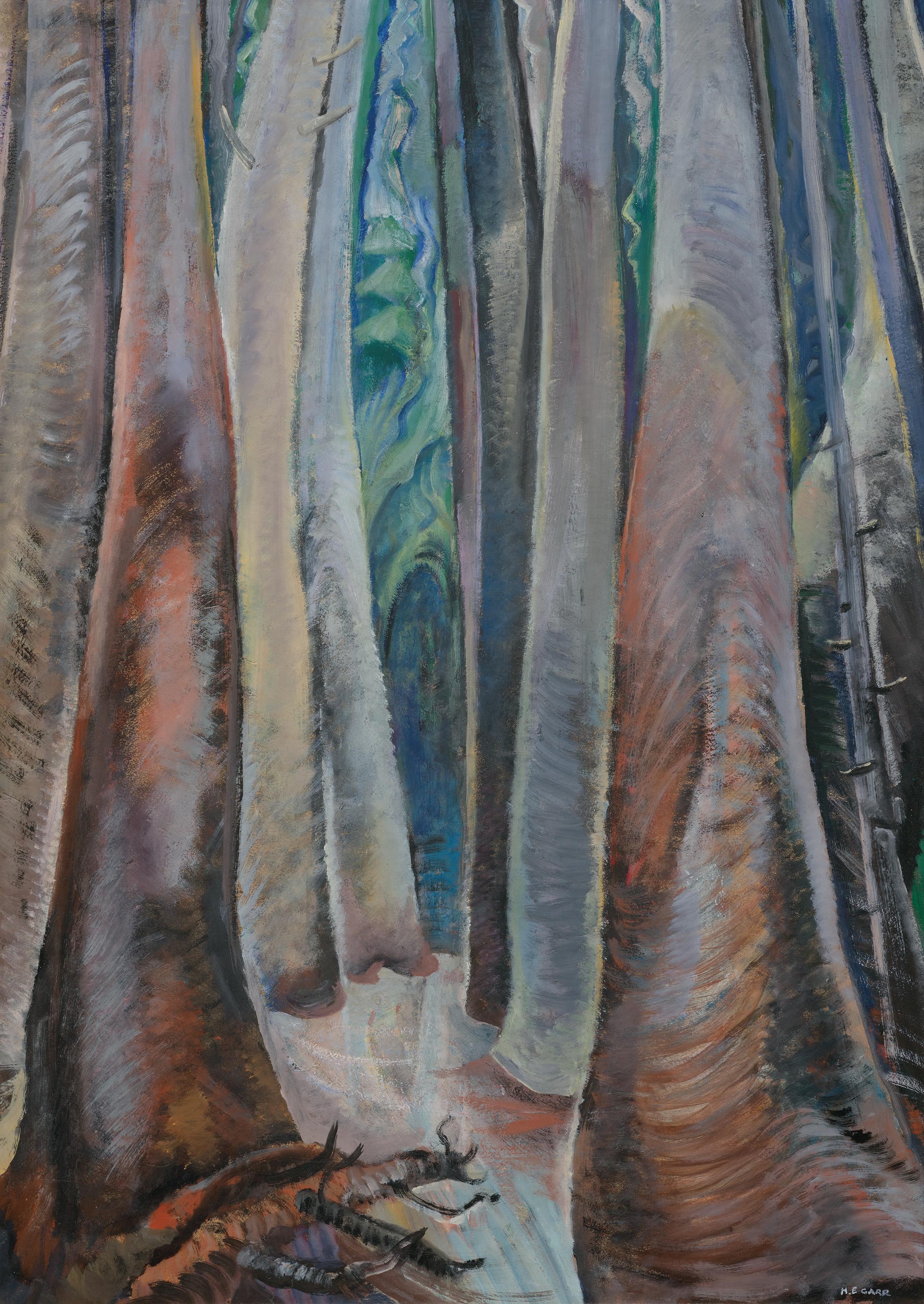
COWLEY ABBOTT | An Important Private Collection of Canadian Art - Part II - Spring 2023 73
WILLIAM RAPHAEL
Good News
oil on canvas laid down on board signed and dated 1875 lower left 14 ins x 8.25 ins; 35 cms x 20.6 cms
PROVENANCE
Canadian Fine Arts, Toronto
Acquired by the present Private Collection, 2017
EXHIBITED
Trésors des collectionneurs II/Collectors’ Treasures II, Galerie Eric Klinkhoff, Montreal, 24 October‒7 November 2020, no. 25
A landscape, genre, portrait and still life painter, Raphael is well known for his small oil paintings of single figures. The subjects included a coachman, an organ-grinder, a moccasin seller, a pedlar, and a newspaper vendor, among others. While his treatment of a habitant in an interior, such as Preparing for a Smoke (sold Cowley Abbott, 1 December 2022, lot 135), was reworked in variant compositions, others are known by single examples. This study of a man selling newspapers on a Montreal street appears to be unique and would fall into a body of work he exhibited as a Canadian Character, a title he gave to two paintings in the third exhibition of the Society of Canadian Artists in March 1871.
The characterization of the vendor is masterful. He is warmly wrapped in a cloth coat, vest and sweater, his ruddy face and red hair covered by a rough fur hat, his feet protected by thick boots. Standing by a gas lamppost, his bare hands hold copies of the Montreal, English language papers the Evening Star (founded in 1869) and the Daily Witness, an evangelical Protestant temperance movement paper, first published in 1845. The choice of newspapers raises questions about their relationship and necessary competition. Is there a satirical intent or social commentary to be discovered in this wonderful painting?

We extend our thanks to Charles Hill, Canadian art historian, former Curator of Canadian Art at the National Gallery of Canada and author of The Group of Seven‒Art for a Nation , for his assistance in researching this artwork and for contributing the preceding essay.
$5,000–$7,000
COWLEY ABBOTT | An Important Private Collection of Canadian Art - Part II - Spring 2023 74 136
WILLIAM RAPHAEL
Bonsecours Market, 1864
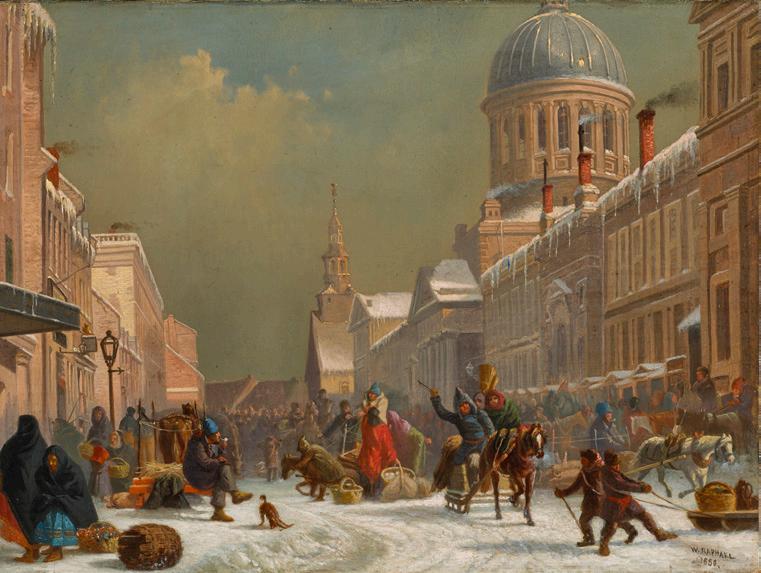

graphite, ink and watercolour, heightened with white signed and dated 1864 lower left
9.5 ins x 11.75 ins; 23.8 cms x 29.4 cms
PROVENANCE
The Artist
By descent to the granddaughter of the Artist Private Collection
W.P. Wolfe, Montreal
Acquired by the present Private Collection, December 1998
LITERATURE
“The Fine Art Conversazione,” Gazette (Montreal)
13 February 1864
Napoléon Bourassa, “Causerie artistique,” La Revue Canadienne II:3 (March 1865) page 171
Sharon Rose Goelman, William Raphael, R.C.A. (1833-1914) (M.A. thesis, Concordia University, 1978) pages 339-362
For many decades William Raphael’s best known painting was his 1866 canvas Behind Bonsecours Market, purchased by the National Gallery of Canada in 1957 (acc.no.6673), depicting a variety of figures on the quai between the market building and the apse of Notre-Dame-de-Bonsecours and the Saint Lawrence River. That painting expanded on a theme treated in a much more animated scene in this watercolour of 1864. In contrast to the summer calm of the riverside, he has here depicted the busy commerce of rue Saint-Paul in winter. The dome of Bonsecours market with its original chimneys and façade lined with temporary stalls, and the steeple of Notre-Dame de Bonsecours, before the reconstruction of the north façade, rise above this bustling street scene. Lower right a
dark horse pulls a box sleigh or berlot carrying passengers waving brooms while a white horse pulls a traîneau à batons, or stick sled laden with pigs for market. Basket-laden women gesticulate at a farmer trying to right his fallen horse in the centre of the street while another sleigh approaches from behind. A pipe-smoking habitant, seated on the back of his horse-drawn sleigh and two Indigenous women wrapped in shawls lower left (presaging the painting Two Indian Women of 1873, sold at Cowley Abbott, 1 December 2022, lot 134) provide a calm anchor to the chaotic scene. With almost topographical accuracy Raphael has delineated the architecture and awning and gas lamp lower left, animating it with a cast of characters on a cold winter day.
Raphael exhibited a painting titled Bonsecours Market in the second Loan Exhibition organized by the Art Association of Montreal in February 1864 and Napoléon Bourassa, whose lofty, Renaissance ideals for art disdained genre painting, described this work in his “Causerie artistique” in 1865, “We have our Raphael, who last year painted our Bonsecours Market with lots of sheep, calves, cows, pigs, broods, with a crowd of our Perette and our Garo, under the effect of the setting sun; but we have to admit with humility, that this Raphael is not the right one.” It is unlikely that this small watercolour was the work exhibited; however it is undoubtedly a study for that painting, or for a variant composition. While Raphael worked infrequently in watercolour, Sharon Goelman has identified about a dozen watercolours, some mere studies in sketchbooks. This is Raphael’s first treatment of a subject with which he is so closely associated.
Whether commissioned, or instigated by the artist’s own interest in this early watercolour, in 1880 Raphael painted an oil version from this study. It is faithful to the original in almost all details, yet to fill the potentially empty foreground he added two boys pulling a loaded sleigh lower right, a dog in the street in front of the seated habitant, and additional baskets around the central women.
We extend our thanks to Charles Hill, Canadian art historian, former Curator of Canadian Art at the National Gallery of Canada and author of The Group of Seven‒Art for a Nation , for his assistance in researching this artwork and for contributing the preceding essay.
$2,000–$3,000
COWLEY ABBOTT | An Important Private Collection of Canadian Art - Part II - Spring 2023 75 137
William Raphael
Bonsecours Market, Montreal, 1880 oil on canvas, 30.4 x 40.7 cms
Purchased 2015 National Gallery of Canada, Ottawa Not for sale with this lot
DAVID BROWN MILNE
Tin Basin, Flowers in a Prospector’s Cabin II, 1929 oil on canvas
Milne catalogue raisonné no.208.22
16.5 ins x 20.5 ins; 41.3 cms x 51.3 cms
PROVENANCE
Possibly gift of the Artist to the Kimball Family, Buffalo, New York, 1931 or later Morris Gallery, Toronto, 1974
R. McKenzie, St. Catherine's, 1974 Morris Gallery, Toronto, circa 1976 Private Collection
LITERATURE
David P. Silcox, Painting Place: The Life and Work of David Milne, Toronto, 1996, page 201
David Milne Jr. and David P. Silcox, David B. Milne: Catalogue Raisonné of the Paintings, Volume 2: 1929-1953, Toronto, 1998, listed and reproduced page 465, no.208.22
David Milne hailed from Bruce County in rural southwestern Ontario and was, in essence, a landscape artist. His painting in the years spent in Boston Corners‒before he enlisted in the army during World War I‒is some of the most esteemed in his highly productive career. Milne left Canada at age 21 to study at the Arts Students’ League there (1903‒05). He came to know both American and European Impressionism, Post‒Impressionism, and Fauvism, quintessentially modern approaches that would shape his own unique style. A significant measure of this early success was his participation in two of North America’s most important exhibitions of avant-garde art in the early 20th century: the famous Armory Show in 1913 (seen in New York, Boston, and Chicago) and the Panama-Pacific International Exposition held in San Francisco in 1915. Boston Corners, by contrast, had fewer than 100 inhabitants when the Milnes moved there in 1916. This site was a dramatic change from his previous years in crowded New York City, but it was the metropolis that proved to be the exception in his career.
Milne was a particularly keen observer of his immediate surroundings, whether a sweeping landscape, a patch of ground, or objects of interest in his domestic surrounds. He reacted emotionally to his physical situation. For this reason, where he was painting‒and he moved constantly, usually for economic reasons‒is crucial to our understanding of individual works and of periods in his prolific artistic life. In the spring of 1929, he moved to the rugged Temagami area in northeastern Ontario, known for its mining and forestry industries. He painted in the town of Temagami, but of more interest to him were nearby mineshafts and the immediate material traces of prospecting that we see in this painting.
The components named in Tin Basin, Flowers in a Prospector’s Cabin II might seem oddly chosen, but in part thanks to a letter Milne wrote at the time, we have a sense of how typical and indeed significant this and closely related paintings were for him. He had a habit of painting spring flowers every year and went out looking for specimens in May 1929. Unhappy with his first attempt to render them and in need of fresh flowers, he records that the next day “I landed on the same island [in Lake Temagami] and got more flowers, taking them with the ones from the home island in the water pail. I thought of tackling my job in the open, but the shifting light was too threatening, so I paddled across the lake to a prospector’s camp that I had visited before. It has a table and a bench.” It was here that Milne found more still-life objects and incorporated them into his design.
The result, characteristically for Milne, is both carefully planned and executed but also subject to serendipity. A visual essay in curvilinearity and surface effects, the manufactured elements in the composition (plates, bottles) anchor a remarkably complex pictorial space. Each of these objects also reflects light, colour, and form, but even with this added visual interest, each also seems stable in our field of vision in comparison with the exuberant reds, yellows, and greens of flowers Milne displays in this makeshift yet punctilious arrangement. The flowers are mirrored in the shiny surfaces Milne has brought to the table. The result is joyous ramification and a celebration of the painter’s skill that Milne was justifiably pleased with.
Mark A. Cheetham is a freelance writer and curator and a professor of art history at the University of Toronto. He is author of Abstract Art Against Autonomy: Infection, Resistance, and Cure since the '60s (Cambridge University Press).
$60,000–$80,000
COWLEY ABBOTT | An Important Private Collection of Canadian Art - Part II - Spring 2023 76 138

COWLEY ABBOTT | An Important Private Collection of Canadian Art - Part II - Spring 2023 77
HENRY MORTIKAR ROSENBERG
Girls Gathering Firewood, circa 1886 oil on canvas signed and inscribed “Halifax” lower left 20 ins x 24 ins; 50 cms x 60 cms
PROVENANCE
Private Collection
EXHIBITED
Reinvention: The Art and Life of H.M. Rosenberg, Art Gallery of Nova Scotia, Halifax, 2012
Art canadien: L’enfant et son univers|Canadian Art: A Child’s World , Galerie Eric Klinkhoff, Montreal, 28 October‒11 November 2017, no. 18
Canada and Impressionism: New Horizons 1880-1930, National Gallery of Canada, Ottawa; travelling to Kunsthalle der Hypo-Kulturstiftung, Munich; Fondation de l'Hermitage, Lausanne; Museé Fabre, Montpellier, 19 July 2013‒3 July 2021, no. 46
LITERATURE
Dougald John MacGillivray, “About Art in Halifax”, uncredited newspaper clipping, circa 1928, in Rosenberg Scrapbook at Art Gallery of Nova Scotia
Mora Dianne O’Neill, Reinvention: the art and life of HM Rosenberg, Halifax, 2012, page 120
Gyrth Russell, “The Visit”, Dalhousie Review 6 (1926) pages 370‒3
NSCA Scrapbook of clippings, “Nova Scotian Artist has made friends of ‘Greats’ in Travels”, Halifax Daily Star, 13 March 1934, Nova Scotia Archives, MG 17 Vol 45
Katerina Atanassova, Canada and Impressionism: New Horizons, 18801930, Ottawa, 2019, no. 46, reproduced page 174
One of the ‘Duveneck Boys’ in Munich and Italy in the late 1870s and early 1880s, Henry Rosenberg served as principal of the Victoria School of Art and Design (now NSCAD University) between 1896 and 1909.
His Girls Gathering Firewood , painted in Halifax in 1886, reflects his receptiveness to new artistic ideas absorbed from Whistler, Sargent, and Gauguin during his years in Venice and Brittany, although precise documentation of his European activity is sadly lacking.
Gauguin had been pleased by the enthusiasm of the American artists in Pont-Aven to his work, and Rosenberg might well have accompanied him on the sketching expeditions that led to Pont-Aven Woman and Child (Private Collection) or Bathing in Front of the Port of Pont-Aven (Dixon Gallery and Gardens, Memphis) or La Bergère Bretonne (Laing Art Gallery, Newcastle Upon Tyne) that year. Rosenberg produced three small pastels of the children in Breton costume who appear in the painting before leaving Pont-Aven to attend the wedding of Frances Jones and Hamlet Bannerman at Halifax in 1886, where he utilized them for this delightful painting. Certainly, he had replaced his earlier use of the pearly grey palette chosen by other Americans at Pont-Aven for the warmer tones favoured by Gauguin, and the foliage in his painting mimics the application of spontaneous brushstrokes Gauguin employed for those paintings and for Les Lavandières à PontAven (Musée d’Orsay, Paris) that same year. Rosenberg, however, as did almost all the North American Impressionists, maintained a naturalistic handling for the human figure.
His debt to Whistler is most evident in etchings he produced in Venice and Brittany, for some of which he followed Whistler’s practice of drawing the scene before him directly on the plate–thus producing its mirror image. Many misty views of Halifax Harbour also recall Whistler’s views of the Lagoon at Venice. His Street in Chioggia (owned by a family member but now lost) shared the dark and brooding quality characteristic of Sargent’s early work in Venice. The National Gallery holds six of Rosenberg’s European etchings as well as a small impressionistic canvas. The Art Gallery of Nova Scotia, the Dartmouth Heritage Museum, Dalhousie Art Gallery, and the Art Gallery of Ontario also hold representative works.
We extend out thanks to Dianne O’Neill, former Associate Curator at the Art Gallery of Nova Scotia, where she devoted forty-odd years to the history of art-making in that province, for contributing the preceding essay.
$6,000–$8,000
COWLEY ABBOTT | An Important Private Collection of Canadian Art - Part II - Spring 2023 78 139

COWLEY ABBOTT | An Important Private Collection of Canadian Art - Part II - Spring 2023 79
JOHN ARTHUR FRASER
At a Lobster Fishery (Bay Chaleur) oil on canvas signed and dated 1880 lower left; inscribed “At a Lobster Fishery Bay Chaleur J.A. Fraser C A Price 100” on the stretcher bar on the reverse 14 ins x 21 ins; 35 cms x 52.5 cms
PROVENANCE
Canadian Fine Arts, Toronto
Acquired by the present Private Collection, August 2007
EXHIBITED
Canadian Academy of Arts, First Annual Exhibition, Clarendon Hotel, Ottawa, 8‒19 March 1880, no. 53 as At a Lobster-Fishery (Bay Chaleur) priced at $100 Special Exhibition of the Works of Canadian Artists Including Diploma Pictures, &c., from the Recent Exhibition of the Canadian Academy of Arts, Ottawa, Art Association of Montreal, from 14 April 1880, no. 23 as At a Lobster Fishery
Ontario Society of Artists Eighth Annual Exhibition , Society’s Galleries, Toronto, May 1880, no. 51 as At a Lobster Fishery priced at $75 Embracing Canada: Landscapes from Krieghoff to the Group of Seven , Vancouver Art Gallery, travelling to the Glenbow Museum, Calgary; Art Gallery of Hamilton, 30 October 2015‒25 September 2016
LITERATURE
“Academy of Arts,” The Globe (Toronto), 9 March 1880, page 3 “The First Exhibition of the Canadian Academy of Arts,” Canadian Illustrated News, XXI:17 (24 April 1880), reproduced page 265 as Lobster Fishing
“Ontario Society of Artists,” The Globe (Toronto), 19 May 1880, page 10
Dennis Reid, Our Own Country Canada, Being an Account of the National Aspirations of the Principal Landscape Artists in Montreal and Toronto 1860-1890, Ottawa, 1979, page 335
Kathryn L. Kollar, John Arthur Fraser (1838-1898) (M.A. thesis, Concordia University, 1981), pages 56, 63, 159 notes 7-8, 233 as unlocated
Evelyn McMann, Royal Canadian Academy of Arts/Académie royale des arts du Canada , Toronto 1981, page 137
Evelyn R. McMann, Montreal Museum of Fine Arts, formerly Art Association of Montreal Spring Exhibitions 1880-1970, Toronto, 1988, page 134
Ian Thom, et al., Embracing Canada: Landscapes from Krieghoff to the Group of Seven , Vancouver/London, 2015, reproduced page 49, caption page 200
Born in London of Scottish parents in 1838, John Fraser came to Canada in 1858, first settling in Stanstead, Quebec. By 1860 he was listed as an artist in the Montreal street directory and was soon working for the renowned photographer William Notman. In 1868 he partnered with Notman to form Notman and Fraser Photographers in Toronto where the first exhibition of the newly established Ontario Society of Artists, of which Fraser was vice-president, was held in April 1873.
The mid-nineteenth century Canadian landscape movement was intimately linked to the development of the railways. In 1876 the Intercolonial Railway opened the final portion of its new line between Rivière-du-Loup and Halifax, enabling tourists and artists to travel by rail from Montreal to the mouth of the Restigouche River in New Brunswick. In October 1877 John Fraser painted on the Baie des Chaleurs.
Given the demands of his Toronto businesses Fraser had little time to paint and at least seven of his twelve submissions to the first exhibition of the Canadian Academy of Arts in Ottawa in March 1880 (becoming Royal Canadian Academy that summer) were worked up from his Maritime sketches of 1877. The writer in Toronto’s Globe praised At a Lobster Fishery (Bay Chaleur). “This picture is one of those beautiful compositions of sea, land and sky in which Mr. Fraser seems to excel. The water is clear, liquid, and full of motion, though not turbulent, while the beach, sky, and clouds are all strong and full of meaning, as if painted with a purpose to express an idea rather than to make up a picture.” And when the painting exhibited in Toronto in May, the Globe’s writer again enthused, “ Mr. J.A. Fraser shows two companion pictures of medium size but far more than medium merit. They are both marine pieces, the 'Lobster Fishery' being the more attractive and characteristic of the two. Mr. Fraser excels in depicting rocks and water….”
As in his smaller canvas, Study for “A Seaside Idyll” of 1877 (sold Cowley Abbott, 1 December 2022, lot 137), the foreground shore curves from the lower right to the buildings at the left, then to the upper right, framing the open water. The woman standing on the beach casts her gaze across the water to the moored sailboats drawing the viewer’s eye to the distant hills, most likely Tracadiegash Mountain in Gaspé viewed from near Port Dalhousie. The foreground is strewn with seaweed-covered rocks, logs, lobster traps and boats and punctuated by the slow-moving figures. Fraser’s characteristic sensitivity to the light, colour and mood of a particular time of day is once again evident in this canvas.
We extend our thanks to Charles Hill, Canadian art historian, former Curator of Canadian Art at the National Gallery of Canada and author of The Group of Seven‒Art for a Nation , for his assistance in researching this artwork and for contributing the preceding essay.
$8,000–$12,000
COWLEY ABBOTT | An Important Private Collection of Canadian Art - Part II - Spring 2023 80 140

COWLEY ABBOTT | An Important Private Collection of Canadian Art - Part II - Spring 2023 81
LUCIUS RICHARD O’BRIEN
Through the Rocky Mountains, a Pass on the Canadian Highway
watercolour
signed and dated 1887 lower right 40 ins x 27.5 ins; 100 cms x 68.75 cms
PROVENANCE
The Artist, until at least 1893
Mrs. J. Home Cameron, Toronto, by May 1959
McMichael Canadian Collection, Kleinburg, Ontario McCready Gallery, Toronto
Acquired by the present Private Collection, circa 1972
EXHIBITED
Possibly Eighth Annual Exhibition of the Royal Canadian Academy of Arts, Art Association of Montreal, from 20 April 1887, no. 117 Dudley Gallery Art Society, London, England, January‒February 1888, no. 1
Fine Art Exhibition , Bewick Club, Newcastle-Upon-Tyne, 1888, no. 1
A Selection of Twenty-seven Water Colour Drawings, Illustrating Scenery in ‘The Rocky Mountains’ and ‘Pacific Coast’ British Columbia. By L.R. O’Brien, Esq. President of the Royal Canadian Academy, Thomas McLean’s Gallery, London, from 22 June 1889, no. 1
Lucius R. O’Brien , W. Scott & Sons, Montreal, from 12 March 1892, no. 2 as A Pass on the Canadian Highway at $350
The Palette Club, Lucius O’Brien’s Studio, Toronto, 10‒11 February 1893, no. 22 as The Kicking Horse Pass at $350
Lucius R. O’Brien , Matthews Bros, Toronto, from 12 December 1893, no. 1 as A Pass on the Canadian Highway $350
Our Own Country Canada , National Gallery of Canada, Ottawa; travelling to Winnipeg Art Gallery; Vancouver Art Gallery; Art Gallery of Ontario, Toronto; Montreal Museum of Fine Arts, 24 November 1978‒19 August 1979, no. 125
Historische Maleriei Kanadas, in OKANADA, Akademie der Künste, Berlin, travelling to Instituts für Auslandsbeziehungen, Stuttgart, 5 December 1982‒20 March 1983, no. 23
Collector’s Canada: Selections from a Toronto Private Collection , Art Gallery of Ontario, Toronto; travelling to Musée du Québec, Quebec City; Vancouver Art Gallery; Mendel Art Gallery, Saskatoon, 14 May 1988‒7 May 1989, no. 20
Lucius R. O’Brien: Visions of Victorian Canada , Art Gallery of Ontario, Toronto, travelling to the National Gallery of Canada, Ottawa; Vancouver Art Gallery; Musée du Québec, 28 September 1990‒14 July 1991, no. 57
Plain Truth, Mendel Art Gallery, Saskatoon, travelling to the Glenbow, Calgary; MacKenzie Art Gallery, Regina, 13 March‒21 November 1998, no. 249
Vistas: Artists on the C.P.R., Glenbow Museum, Calgary, 20 June‒20 September 2009
Embracing Canada: Landscapes from Krieghoff to the Group of Seven , Vancouver Art Gallery, travelling to the Glenbow Museum, Calgary; Art Gallery of Hamilton, 30 October 2015‒25 September 2016
Highlights from “Embracing Canada”, Galerie Eric Klinkhoff, Montreal, 22 October‒5 November 2016, no. 9
LITERATURE
“The Art Exhibition. Some Notices of the Pictures Displayed,” The Herald (Montreal), 21 April 1887, as The New Route to the East – a Pass on the Canadian Railway
“Art and Artists,” Toronto Saturday Night, VI:13 (18 February 1893), page 15, as The Kicking Horse Pass
“Saturday Art Supplement,” Daily Mail (Toronto), 13 May 1893, reproduced as Through the Rocky Mountains. A pass of the Canadian Pacific Railway
Dennis Reid, "'Our Own Country Canada': Being an Account of the National Aspirations of the Principal Landscape Artists in Montreal and Toronto 1860-1890", National Gallery of Canada Journal 31 (24 November 1978), reproduced page 8
John Bentley Mays, “Black and white in color,” Maclean’s (15 January 1979), reproduced page 47
Dennis Reid, ‘Our Own Country Canada’: Being an Account of the National Aspirations of the Principal Landscape Artists in Montreal and Toronto 1860-1890, Ottawa, 1979, pages 397-400, 414-415, reproduced page 415, as painted from O’Brien’s 1887 trip to the Rockies
Dennis Reid, “Lucius O’Brien,” in OKANADA, Akademie der Künste, Berlin, 1982, reproduced page 52; original texts for German-language catalogue, page 51
Allan Pringle, Artists of the Canadian Pacific Railway, (M.A. thesis, Concordia University, Montreal, 1983), pages 55-60, 85, 121, 144, as Bridge‒Kicking Horse Pass‒Second Crossing, reproduced illustration 2 Sid Marty, A Grand and Fabulous Notion: The First Century of Canada’s National Parks, Toronto, 1984, reproduced page 50
Allan Pringle, “William Cornelius Van Horne: Art Director, Canadian Pacific Railway,” The Journal of Canadian Art History, 8 (1984), pages 63-66, 77 note 65, as Bridge‒Kicking Horse Pass‒Second Crossing
Craig Brown, editor, The Illustrated History of Canada , Toronto, 1987 (and 1990), reproduced page 360
Dennis Reid, Collector’s Canada: Selections from a Toronto Private Collection , Toronto, 1988, reproduced pages 28‒29
Dennis R. Reid, Lucius R. O’Brien: Visions of Victorian Canada , Toronto, 1990, pages 79‒80, 92 notes 51, 53, reproduced page 163
Dennis Reid, “O’Brien, Lucius Richard,” in Dictionary of Canadian Biography, vol. XII, Toronto, 1990, page 795
Lynda Jessup, Canadian Artists, Railways, The State and ‘The Business of Becoming a Nation’ (Ph.D. dissertation, University of Toronto, 1992), pages 190, 205‒206, 214-215, reproduced figure 59
Roger Boulet, Vistas: Artists on the Canadian Pacific Railway, Calgary, 2009, pages 61‒65, [70?], reproduced page 108
Nancy Townshend, Art Inspired by the Canadian Rockies, Purcell Mountains and Selkirk Mountains 1809-2012, Calgary, 2012, page 10, reproduced insert 5
Infrastructure Canada: Daniel Young and Christian Giroux , Oakville, 2012, page 251, reproduced page 249
First President of the Royal Canadian Academy of Arts, Lucius O’Brien was the most prominent Canadian artist of his generation. Working in oils, and more frequently in watercolour, O’Brien painted landscapes in Quebec, New Brunswick and Ontario, a trajectory that was closely linked to the growth of the railways. The completion of the Canadian Pacific Railway in 1885 opened up new territory for artists. The company needed settlers and passengers to survive and it set out to publicize the new line, first in photographs then in paintings.
COWLEY ABBOTT | An Important Private Collection of Canadian Art - Part II - Spring 2023 82 141
For investment reasons, the CPR’s general manager, William Van Horne, had his eyes on a British audience and wanted a good representation of mountain views for the Colonial and Indian Exhibition in London in May 1886. He offered artists free transportation, accommodation and assistance to paint sites along the railway line and was pleased when the Canadian Academy’s president applied in November 1885. Lucius O’Brien left Toronto for the Rocky Mountains on 19 June 1886 and worked in the vicinity of the CPR’s Glacier House hotel.
In his superb study of Lucius O’Brien’s career Reid wrote in 1990, “The CPR picture par excellence, it is set in the Kicking Horse Pass, where two engines in tandem are depicted pulling a train up the world’s longest and steepest gradient, across Kicking Horse Bridge, beneath towering Mount Stephen. … [O’Brien] had bought it to the attention of Van Horne first in a letter of mid April 1887 as he was about to ship his paintings off to Montreal for the Academy exhibition. ‘Among the pictures there will be one I have painted to send to London, as an illustration of our Canadian Highway through the mountains. It is to go on Exhibition at the Dudley Gallery to which I have been asked to contribute.’”
O’Brien exhibited eleven mountain watercolours with the Royal Canadian Academy of Arts in Montreal in April 1887, ten of which were purchased by Sir George Stephen (later Lord Strathcona). One watercolour for the Academy exhibition, titled in O’Brien’s studio book, The New Route to the East, was identified by the artist as not for sale. The unsold work in the RCA exhibition catalogue was titled The Valley of the Illicilliwaet and was priced at $250, but was referred to in a review in the Montreal Herald as The New Route to the East ‒a Pass on the Canadian Railway. On the back of the frame on this watercolour are two labels in O’Brien’s hand, one for the Dudley Gallery exhibition and one for the Bewick Club in Newcastle-upon-Tyme. On both the work is titled by the artist Through the Rocky Mountains, a Pass on the Canadian Highway. To complicate things further, Allan Pringle (1983) suggests that it was first referred to in correspondence with Van Horne as Bridge‒Kicking Horse Pass‒Second Crossing, possibly more of an identification of the subject than a title.
A smaller version of this watercolour, measuring 43.8 x 31.9 cm, inscribed on the verso Kicking Horse Pass (about 5000 ft.), is in the collection of the British Columbia Archives, Victoria (acc. no. 4901), and it might have been painted on site, while the large watercolour was painted in O’Brien’s Toronto studio. This work is the largest of all O’Brien’s mountain watercolours.

Again we have to thank Dennis Reid for his vivid description of this watercolour. “[T]he real pleasure in this painting is in the virtuoso handling of the paint. There is a wonderful sense of the transparency of watercolour in the description of light refracting through the sediment-filled glacial stream, and particularly in the tumble of sunlight across the spill of broken rock that is the principal passage in the picture…. Each of the various set pieces, such as the prominent felled tree in the right foreground, the stunning pair of spruce trees to the left, the carefully observed varieties of rock, are themselves delightfully complex, brilliantly composed pictures.” It is not surprising that this watercolour has become a classic image of its age as evidenced by its frequent inclusion in exhibitions and publications.
We extend our thanks to Charles Hill, Canadian art historian, former Curator of Canadian Art at the National Gallery of Canada and author of The Group of Seven‒Art for a Nation , for his assistance in researching this artwork and for contributing the preceding essay.
$15,000–$20,000
COWLEY ABBOTT | An Important Private Collection of Canadian Art - Part II - Spring 2023 83
ROBERT HARRIS
The Dead Bird, circa 1890 oil on canvas signed lower right
16 ins x 20 ins; 40 cms x 50 cms
PROVENANCE
Morris Gallery, Toronto Acquired by the present Private Collection, November 1972
EXHIBITED
Royal Canadian Academy of Arts, Art Association of Montreal, Montreal, from 24 April 1890, no. 42 as The Lark’s Death Royal Canadian Academy of Arts, Toronto Art Gallery, from 6 March 1891, no. 63
Canadian Classics, Morris Gallery, Toronto, 21 October‒4 November 1972
Collector’s Canada: Selections from a Toronto Private Collection , Art Gallery of Ontario, Toronto; travelling to Musée du Québec, Quebec City; Vancouver Art Gallery; Mendel Art Gallery, Saskatoon, 14 May
1988‒7 May 1989, no. 26 as The Dead Bird, circa 1890
Art canadien: L’enfant et son univers|Canadian Art: A Child’s World , Galerie Eric Klinkhoff, Montreal, 28 October‒11 November 2017, no. 14
Our Children: Reflections of Childhood in Historical Canadian Art, Varley Art Gallery, Markham, 13 April‒23 June 2019 as The Dead Bird, circa 1890
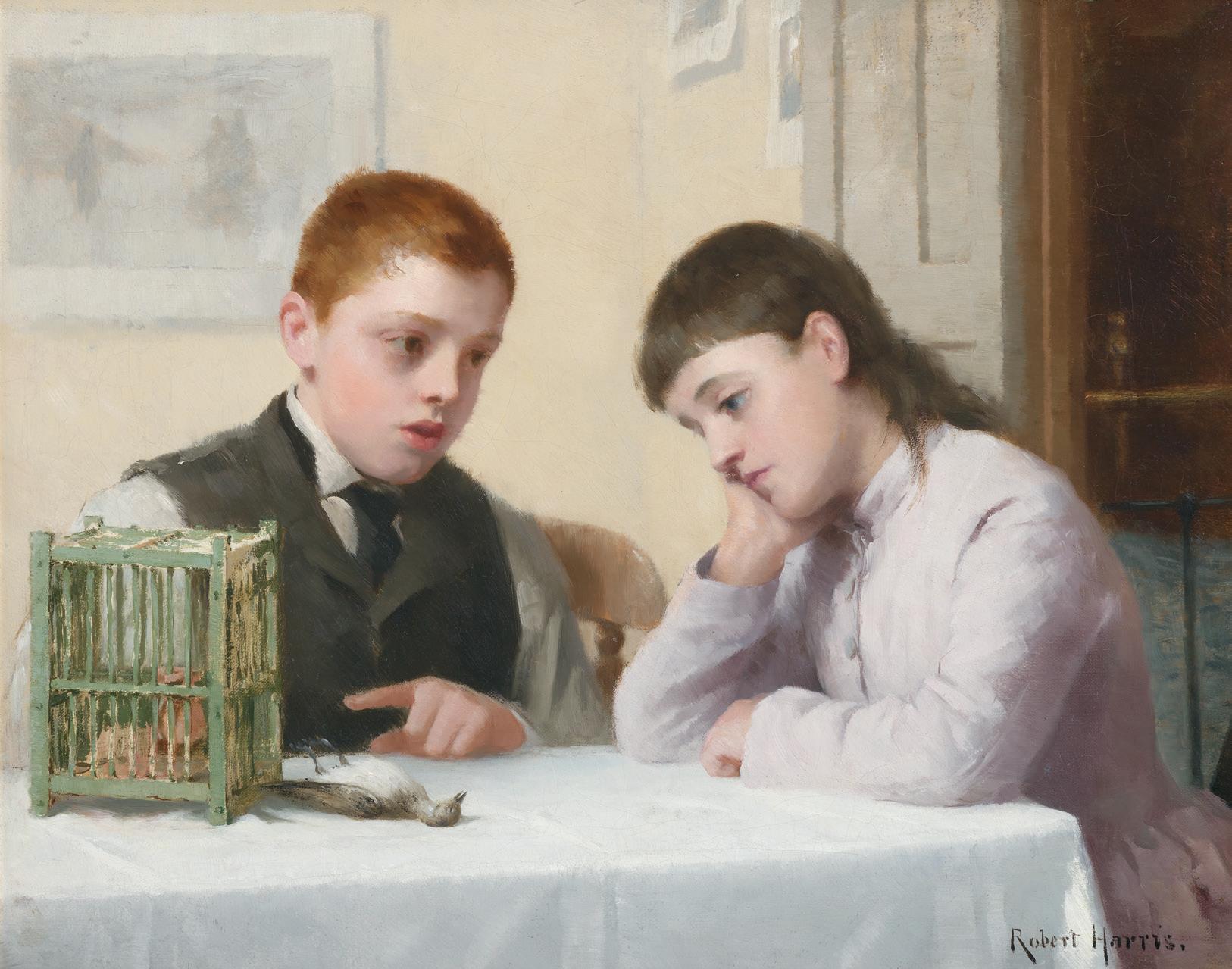
LITERATURE
Canadian Classics, Morris Gallery, Toronto, 21 October‒4 November 1972, reproduced Dennis Reid, Collector’s Canada: Selections from a Toronto Private Collection , Toronto, 1988, no. 26, reproduced page 36
A painter of the social and political elite in Toronto and Montreal, Robert Harris is considered Canada’s most renowned historical portrait artist. Born in Wales in 1849, Harris grew up on his father’s farm before moving to Prince Edward Island in 1856. He developed an interest in art at a young age, often sketching images he saw in magazines. During a trip to Liverpool in 1867, Harris visited the local museum, where he independently learned anatomy and proportion by sketching from plaster casts. Already working as an artist, he decided to pursue formal artistic instruction in 1873 in Boston, London, and Paris.
Harris quickly became known as the most important portrait artist in Canada following his commissioned painting The Fathers of Confederation dating to 1883. He painted portraits of more than two hundred major figures of his times, including Sir John A. MacDonald and Lord Aberdeen. Here, the artist has depicted a boy and a girl mourning the loss of a pet bird. Dressed in formal attire, they are likely the children of one of Harris’ Canadian elite clients.
The majority of Harris’ mature career was spent in Montreal. A teacher at the Art Association of Montreal and founding member of the Royal Canadian Academy of Arts in 1880, he was one of the first advocates for the distinctiveness of Canadian Art. As president of the RCA for thirteen years, Harris took on the mission of promoting young Canadian artists by making sure that they were represented in all the major exhibitions of the time.
$5,000–$7,000
COWLEY ABBOTT | An Important Private Collection of Canadian Art - Part II - Spring 2023 84
142
143
CHARLES EDOUARD HUOT
Interior with Seated Figures
oil on canvas signed lower right 22.25 ins x 27.25 ins; 55.6 cms x 68.1 cms
PROVENANCE Private Collection
Born in Quebec City, Charles Edouard Huot moved to Paris at age nineteen to attend the École des Beaux-arts and study in the workshop of Alexandre Cabanel. He participated in numerous exhibitions there, including the 1876 Salon. He married Louise Schlachter in 1885, returned to Canada in 1886 on the promise of a large commission of painting the Church of the Holy Saviour in Quebec City. This project firmly established Huot’s career, and it led to many more commissions from religious and political groups.
In Interior with Seated Figures, Huot depicts the more pared-down subject of a French-Canadian interior scene featuring a couple and their dog. The woman is calmly knitting, and the man leans back on his chair with his hands crossed over an orange hat in his lap. The room, though minimally decorated, contains many household objects and subtle details: a broom and a bed warmer in the right corner, two portrait sketches on the wall, a crucifix and a kettle above the burning fireplace, and two pots with red flowers sit on the left windowsill, where a glimpse of light shines into the room. Huot has created an intimate scene that gives a glimpse into an authentic Quebecois household of the time.
$6,000–$8,000

COWLEY ABBOTT | An Important Private Collection of Canadian Art - Part II - Spring 2023 85
ARTHUR LISMER
McGregor Bay, circa 1923
oil on panel
signed lower left and lower right; signed, dated 1921 and inscribed “MacGregor [sic] Bay, Georgian Bay” on the reverse 9 ins x 12 ins; 22.5 cms x 30 cms
PROVENANCE
The Artist
Dr. James Lawson, Toronto, by 1948
Framing Gallery, Toronto
Acquired by the present Private Collection, circa 1965
EXHIBITED
Collector’s Canada: Selections from a Toronto Private Collection , Art Gallery of Ontario, Toronto; travelling to Musée du Québec, Quebec City; Vancouver Art Gallery; Mendel Art Gallery, Saskatoon, 14 May 1988‒7 May 1989, no. 73
Hommage à Arthur Lismer, Galerie Walter Klinkhoff, Montreal, 6‒20
September 1997, no. 10, as circa 1923
Embracing Canada: Landscapes from Krieghoff to the Group of Seven , Vancouver Art Gallery; travelling to the Glenbow Museum, Calgary; Art Gallery of Hamilton, 29 October 2015‒5 September 2016
LITERATURE
F. B. Housser, A Canadian Art Movement: The Story of the Group of Seven , Toronto, 1926, page 179
Dennis Reid, Collector’s Canada: Selections from a Toronto Private Collection , Toronto, 1988, no. 73, reproduced page 68
Ian Thom, et al., Embracing Canada: Landscapes from Krieghoff to the Group of Seven , Vancouver/London, 2015, reproduced page 100, caption page 201, as 1923
Georgian Bay was Arthur Lismer’s favourite painting site for over two decades. Teaching full time winter and summer at the Ontario College of Art, he had little free time and holidays were usually family affairs, travelling with his wife Esther and daughter Marjorie. He first painted around Dr. James MacCallum’s cottage on Go Home Bay on Georgian Bay in 1913, returning in 1920. As Dennis Reid has written, it was only in 1923 that Lismer painted at McGregor Bay and he first showed McGregor Bay subjects in the Ontario Society of Artists’ Small Picture Exhibition late October that year. The artist often dated works when they were sold or donated and, as dates were of no interest to him, just the creative process, he frequently provided erroneous dates, as in this instance.
Fred Housser has described the area as “a corner of Georgian Bay which none of the other group members have painted, a deep inlet on the north shore in the region of Manitoulin Island known as McGregor Bay. Here the character of the country differs from that further south. You are close to a range of high hills, the Cloche Mountains…. Channels writhe in and out among the rocky islands and quickly turn to careering (sic) whitecaps when ruffled by the wind. The islands which clutter the bay rise high and sheer from the water.” It was here that Lismer painted studies for The Happy Isles (University of Saskatchewan) and The Island, McGregor Bay (private collection), both included in the 1925 Group of Seven exhibition.
With a remarkable lightness of touch Lismer has delineated the multicoloured rocks, dark pines in variant greens, and rapidly moving clouds rising from turquoise blue to purple greys. The touches of red enhance the bare wood of the panel that is deftly used to suggest forms, such as the tree distant centre, and the space around them. No whitecaps here, just calm water on a late summer day.
We extend our thanks to Charles Hill, Canadian art historian, former Curator of Canadian Art at the National Gallery of Canada and author of The Group of Seven‒Art for a Nation , for his assistance in researching this artwork and for contributing the preceding essay.
$25,000–$35,000
COWLEY ABBOTT | An Important Private Collection of Canadian Art - Part II - Spring 2023 86 144
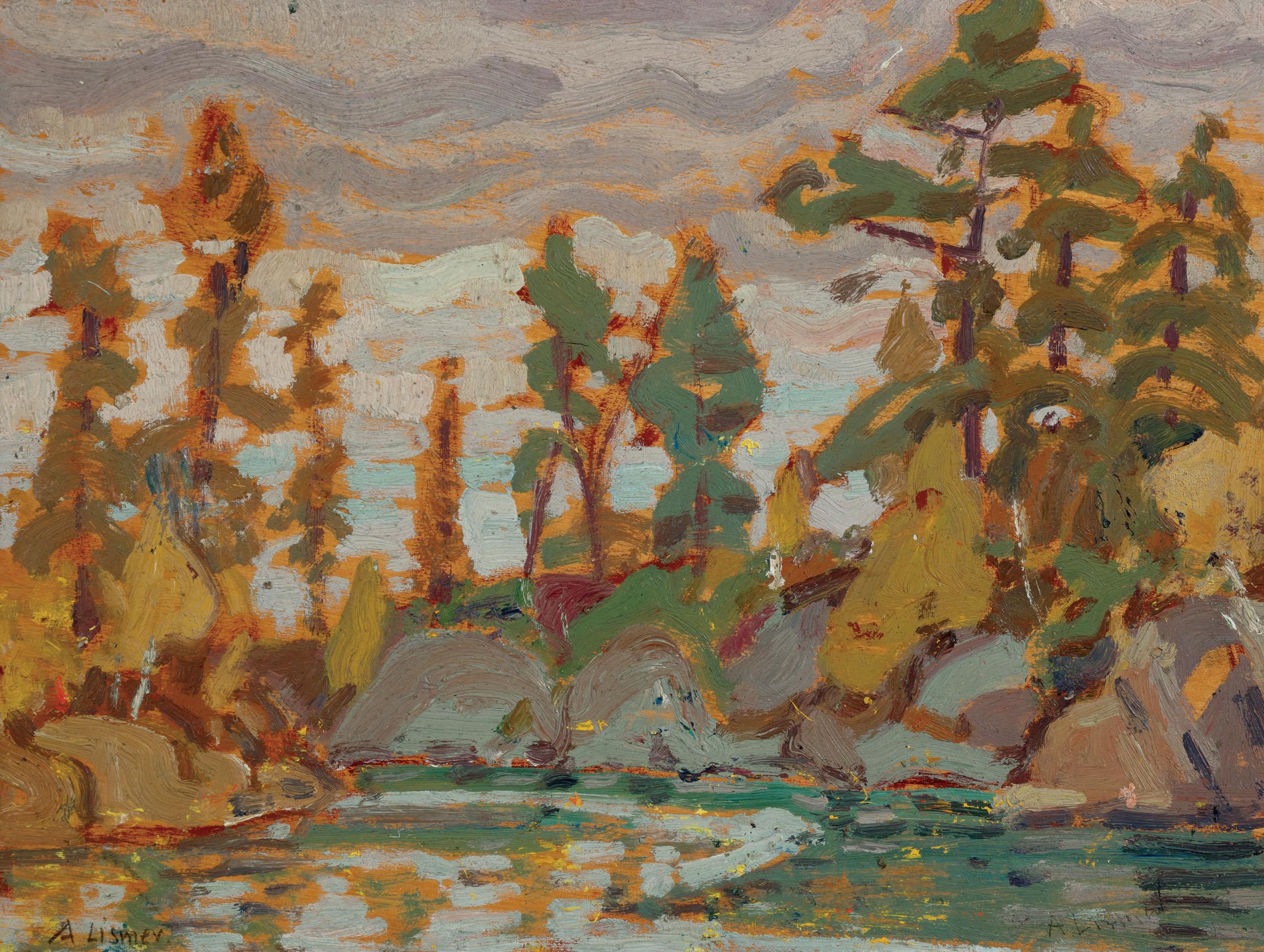
COWLEY ABBOTT | An Important Private Collection of Canadian Art - Part II - Spring 2023 87
145
HENRI BEAU
Summer in the Garden oil on canvas signed and dated 1895 lower right 15 ins x 18 ins; 37.5 cms x 45 cms
PROVENANCE
Sotheby’s, auction, Toronto, 3 December 1997, lot 13 as The Daughters of the Artist Private Collection
EXHIBITED
Art canadien: L’enfant et son univers|Canadian Art: A Child’s World , Galerie Eric Klinkhoff, Montreal, 28 October‒11 November 2017, no. 8
Our Children: Reflections of Childhood in Historical Canadian Art, Varley Art Gallery of Markham, 13 April‒23 June 2019 as Painting in the Garden
LITERATURE
A.K. Prakash, Impressionism in Canada: A Journey of Rediscovery Toronto, 2015, page 752, 765, reproduced page 442, plate 13.2 as Summer in the Garden
The Montreal-born Henri Beau arrived at age twenty-five in Paris, where he sought to further his artistic education under the French Academic Jean-Léon Gérôme and broaden his experience. Like many of his fellow Canadian artists who crossed the Atlantic during the 1890s, Beau was greatly influenced by Impressionism, which he was introduced to in commercial galleries and at the Salon d’Automne and the Salon des Indépendants.
Inspired by the works of Claude Monet and Camille Pissarro, he would leave the city for the countryside whenever possible in order to better study the effects of light and atmosphere upon the natural landscape. Here, the artist has depicted a small group of female figures whiling away the afternoon hours. In the foreground, young girls in vibrant red dresses are shown creating pictures underneath the shade of a tree. While the female figure at the left glances down to select colours on a palette, the other appears to be looking straight ahead as if lost in contemplation. This pastoral tableau is completed with two other figures in the background, where one is shown seemingly fast asleep in a sun-drenched hammock. By applying small dabs of pigments in cream and russet tones, Beau created a richly textured surface and delineated the areas of light and shade on the canvas. Ultimately, his soft and warm palette is quintessentially French, recalling the warm air of the Provence countryside.
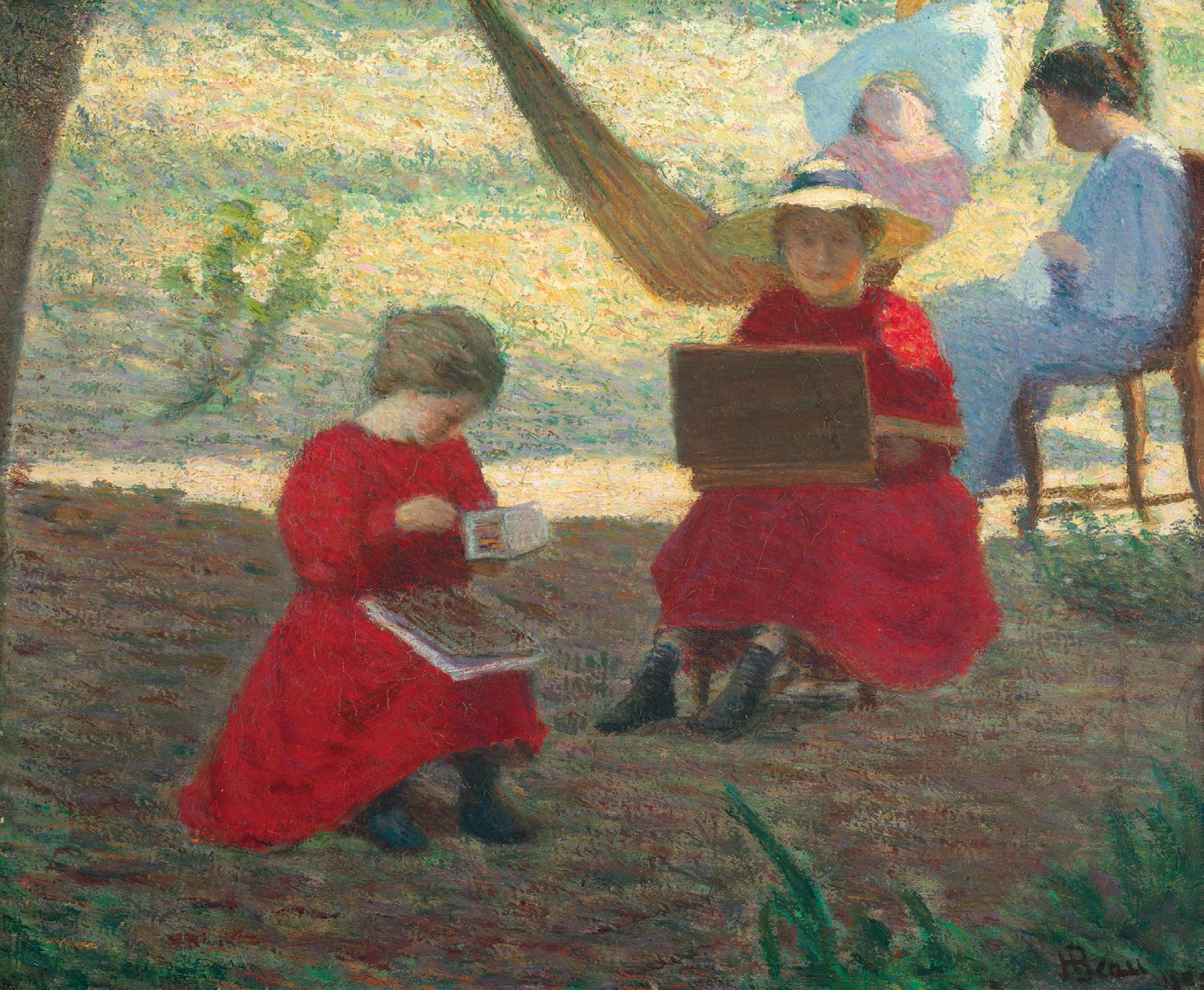
In the end, Beau’s evocative en plein air paintings would contribute to establishing the foundation of modernism in Canadian art, emphasizing one’s subjective interpretation of nature and exploration of the transitory effects of light.
$5,000–$7,000
COWLEY ABBOTT | An Important Private Collection of Canadian Art - Part II - Spring 2023 88
146
JAMES KERR-LAWSON
Harvesting, circa 1912–13 oil on board signed lower right
7.5 ins x 13.5 ins; 18.8 cms x 33.8 cms
PROVENANCE
Caterina Kerr-Lawson, London Paul Duval, Toronto
G. Blair Laing Ltd., Toronto
Mr. and Mrs. Jules Loeb, Hull, Quebec Sotheby’s Canada, auction, Toronto, 8 April 1970, lot 38 Kaspar Gallery, Toronto Private Collection
Joyner Canadian Fine Art, auction, Toronto, 30 May 2006, lot 29 Private Collection
EXHIBITED
Possibly Paintings and Drawings by the late James Kerr-Lawson , The Heffer Gallery, Cambridge, 27 April‒22 May 1948, lot 10 as Haymaking in Kent
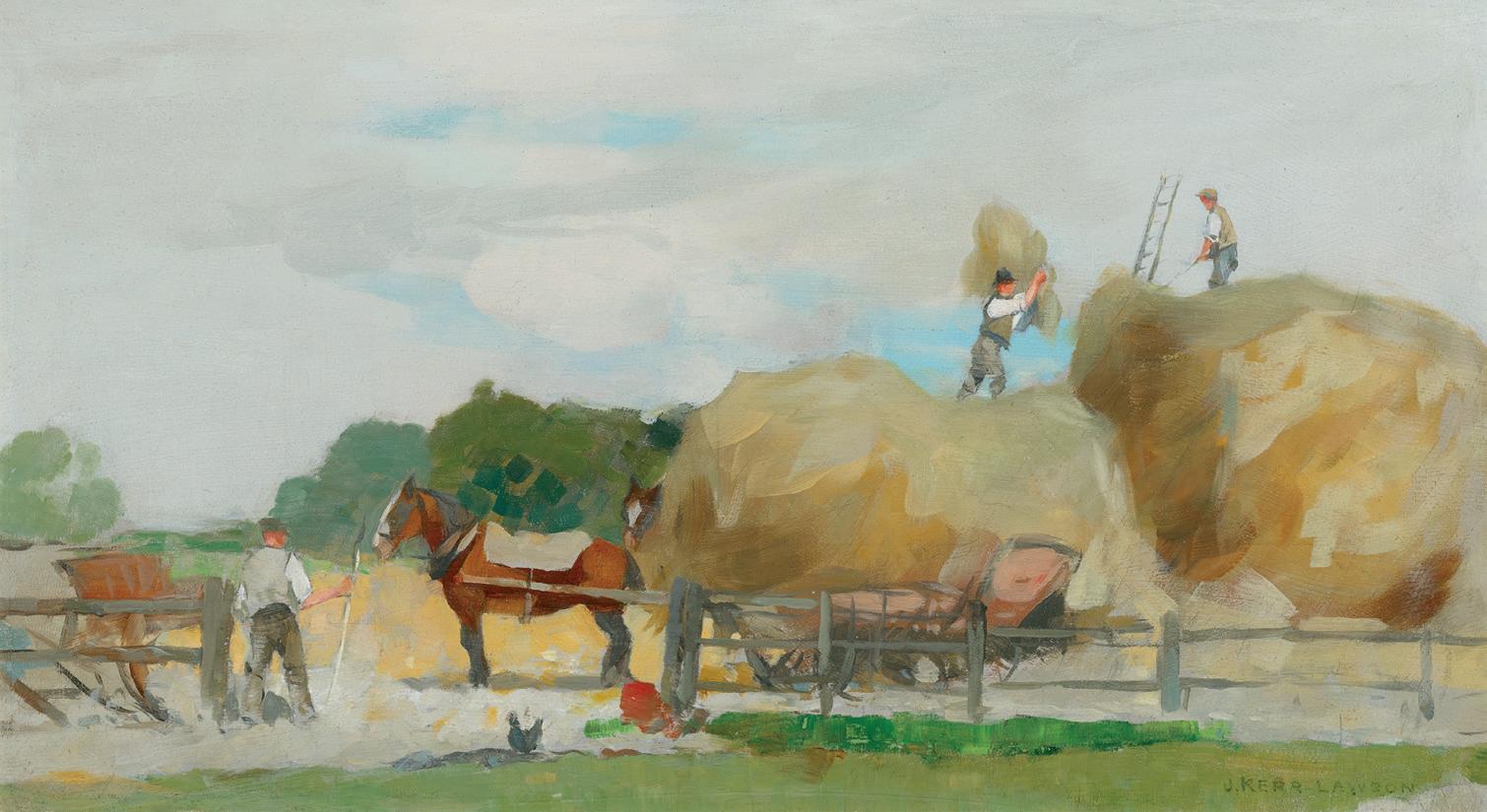
Possibly Exhibition of Paintings by James Kerr-Lawson 1964-1939, Ferens Art Gallery, Hull, England, October 1948, no. 24 as Haymaking in Kent at £35
Possibly Exhibition of Works by J. Kerr-Lawson , Institut francais d’Écosse, Edinburgh, March 1952, no. 54 as Haying in Kent (loaned by Mrs. Kerr-Lawson)
James Kerr-Lawson: A Canadian Abroad , Art Gallery of Windsor, travelling to Macdonald Stewart Art Centre, Guelph; Art Gallery of Windsor; Art Gallery of Toronto; Burnaby Art Gallery; Glenbow Museum, Calgary and Beaverbrook Art Gallery, Fredericton, 12 February 1983‒15 February 1984, no. 48
Embracing Canada: Landscapes from Krieghoff to the Group of Seven , Vancouver Art Gallery, travelling to the Glenbow Museum, Calgary, Art Gallery of Hamilton, 30 October 2015‒25 September 2016
LITERATURE
Lawren S. Harris, “The Canadian Art Club,” The Year Book of Canadian Art 1913, Toronto, 1913, page 214
Robert J. Lamb, James Kerr-Lawson: A Canadian Abroad , Windsor, 1983, pages 40, 55, 58-61, reproduced as probably a Kentish scene circa 1912‒13
Ian Thom, et al., Embracing Canada: Landscapes from Krieghoff to the Group of Seven , Vancouver/London, 2015, reproduced page 72, caption page 201, as circa 1890
Born in Scotland in 1862, James Lawson (later Kerr-Lawson, a conflation of his parents’ family names) was brought to Canada with his family as a child. In 1880, after a year at the Ontario School of Art in Toronto, he left to further his education in Italy and Paris, where he met fellow Canadians Robert Harris and William Brymner, returning in 1885 to Ottawa, where his brother worked for the Canadian Geological Survey. At this time he met Homer Watson, with whom he painted in Pittenweem, Scotland during the winters of 1888‒89 and 1889‒90. While he continued on occasion to exhibit in Canada, he would from now on pursue his career in England and Scotland, living in London and Florence from 1900. He attained an international reputation for his paintings of Italy, Morocco and Spain, for his etchings and lithographs and portraits, and, from 1903, for his mural decorations.
Kerr-Lawson reconnected with Canada in 1912 when Homer Watson nominated him for membership in Toronto’s Canadian Art Club. He exhibited two oils in the 1913 exhibition, Boston (Lincolnshire) and Winter in Kent. The scholar Robert Lamb has identified the small painting Harvesting as being one of several works Kerr-Lawson painted at Sandwich in Kent in 1913-14. In his article on the Canadian Art Club published in the Arts and Letters Club’s Year Book of Canadian Art 1913, Lawren Harris praised Kerr-Lawson’s “felicity of colour. He is exact, almost to the point of being meticulous. But the stuff is there, and his thin pigments are as delicate as a water-colour.” A similar precision and felicity of colour characterizes this luminous painting of men loading hay on a summer day.
We extend our thanks to Charles Hill, Canadian art historian, former Curator of Canadian Art at the National Gallery of Canada and author of The Group of Seven‒Art for a Nation , for his assistance in researching this artwork and for contributing the preceding essay.
$2,000–$3,000
COWLEY ABBOTT | An Important Private Collection of Canadian Art - Part II - Spring 2023 89
147
DANIEL FOWLER
Canadian Game
watercolour
signed and dated 1869 lower left 18.5 ins x 26.75 ins; 46.3 cms x 66.9 cms
PROVENANCE
James Spooner, Toronto
Mr. C.W. Irwin, Toronto
Daniel Fowler of Amherst Island , Agnes Etherington Art Centre, Queen’s University, Kingston; travelling to the Art Gallery of Greater Victoria; Dalhousie Art Gallery, Halifax; National Gallery of Canada, Ottawa and Art Gallery of Ontario, Toronto, January‒November 1979, no. 55 (loaned by C.W. Irwin)
LITERATURE
Dominion of Canada Industrial Exhibition , Department of Fine Arts, Toronto, 1903, no. 211 or no. 212 as Game, reproduced Frances K. Smith, Daniel Fowler of Amherst Island , Kingston, 1979, no. 55, reproduced page 59
By descent
to Mrs.
Dalton Wells G. Blair Laing Ltd., Toronto Private Collection
EXHIBITED
Canadian Section of the Colonial and Indian Exhibition , London, from 4 May 1886 (James Spooner loaned three Fowlers titled Canadian Dead Game)
Dominion of Canada Industrial Exhibition , Department of Fine Arts, Toronto, 27 August‒12 September 1903, no. 211 or no. 212 as Game (loaned by James Spooner)
Canadian National Exhibition: Department of Fine Arts, Toronto, 26 August‒9 September 1907, no. 73 as Canadian Game (loaned by C.W. Irwin)
Loan Collection of Paintings by Deceased Canadian Artists, Fourth Loan Exhibition , The Art Museum of Toronto, 24 January‒22 February 1911, no. 54 as Canadian Game (loaned by C.W. Irwin)
Retrospective Loan Exhibition of Paintings by Members of the Ontario Society of Artists Covering the First Half-Century of the Society’s History, Art Gallery of Toronto, 11 February‒12 March 1922, no. 54
Inaugural Exhibition , Art Gallery of Toronto, 1926, no. 213 or no. 222 Selection of Watercolours by Daniel Fowler, Art Gallery of Toronto, December 1935, no. 208 (loaned by C.W. Irwin)
Daniel Fowler emigrated to Canada in 1843, where he settled on an isolated farm on Amherst Island, near Kingston, and dedicated himself to becoming a gentleman farmer. He would eventually return to his pencils and brushes in 1857, at the age of forty-seven, following a short trip to London, where he re-immersed himself in art by attending exhibitions at the Royal Academy and befriending old acquaintances.
His rural surroundings would have offered him a wealth of subjects, from dead game, and peaceful meadows to fallen trees in nearby fields. Here, Fowler presents game birds lying in a heap against the forest floor. By painstakingly depicting the feathers of various breeds of birds, the artist highlighted minor differences in surface and tone. In order to create such vivid representations, Fowler would work the background with dense colour and, once dry, would then scrape away the surface of the paper to create texture and white highlights. This background technique, a testament to Fowler’s skill and expertise, enabled him to create these intensely vibrant works.
$3,000–$4,000
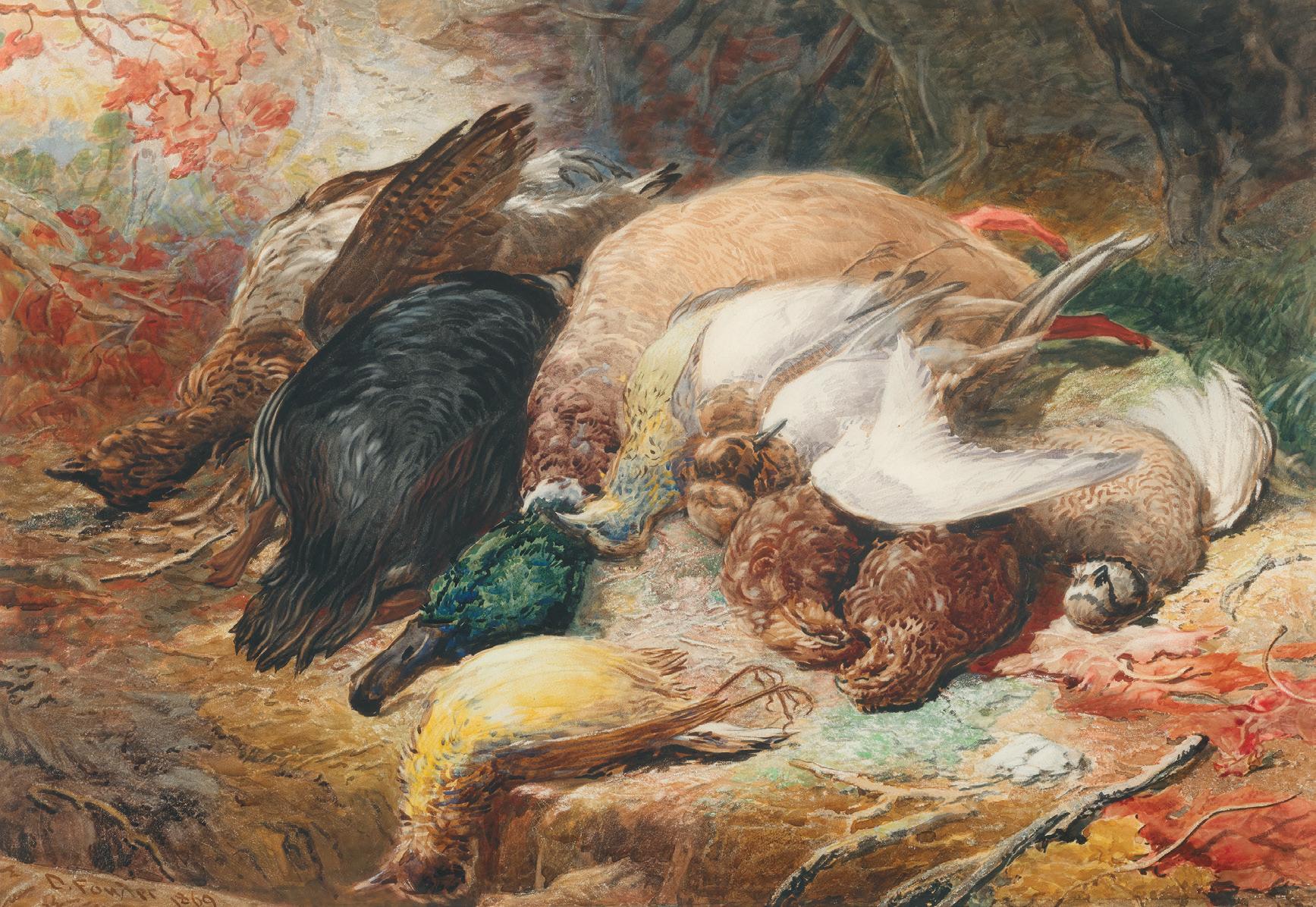
COWLEY ABBOTT | An Important Private Collection of Canadian Art - Part II - Spring 2023 90
AARON ALLAN EDSON
Through the Clearing, circa 1870
oil on canvas signed with monogram lower right 13 ins x 10.25 ins; 32.5 cms x 25.6 cms
PROVENANCE
Antique market, Provincetown, Massachusetts
David Burnett, Toronto, Summer 1981
Christopher Varley, Toronto, 1984
Rembrandt Art Gallery, Toronto
Acquired by the present Private Collection, August 1984
EXHIBITED
Collector’s Canada: Selections from a Toronto Private Collection , Art Gallery of Ontario, Toronto; travelling to Musée du Québec, Quebec City; Vancouver Art Gallery; Mendel
Art Gallery, Saskatoon, 14 May 1988‒7 May 1989, no. 11
Embracing Canada: Landscapes from Krieghoff to the Group of Seven , Vancouver Art Gallery; travelling to the Glenbow Museum, Calgary; Art Gallery of Hamilton, 29 October 2015‒5
September 2016
LITERATURE
Dennis Reid, Collector’s Canada: Selections from a Toronto Private Collection , Toronto, 1988, no. 11, reproduced page 23
Ian Thom, et al., Embracing Canada: Landscapes from Krieghoff to the Group of Seven , Vancouver/ London, 2015, reproduced page 32
The landscapes of Aaron Allan Edson were influenced by the teachings of the American artist Robert Duncanson and the PreRaphaelite Brotherhood’s propensity for detailed compositions, which he absorbed while studying in England in the 1860s. While his works are rooted in the direct observation of nature, they primarily highlight his concern with the play of reflected light and atmospheric effects. Like many other young landscapists of his generation, Edson was driven to “go to nature in all singleness of heart [...] rejecting nothing, selecting nothing, and scorning nothing,” as John Ruskin suggested in Modern Painters, published between 1843 and 1860.
Unlike Otto Jacobi and Adolphe Vogt whose works celebrated the monumental views of the Canadian landscape, Edson favoured more intimate representations, where the stillness of nature took precedence. Through the Clearing demonstrates the artist’s subtle use of a muted palette to depict fall scenery in a realistic manner. In the foreground, the undergrowth has been rendered in rich textures and warm shades of jade, burnt orange and russet, reminiscent of Duncanson’s style. Despite towering fir and leafy trees framing the edge of the canvas, Edson draws our attention instead to an open vista overlooking the water and the distant mountains stretching along the horizon. Here the Canadian wilderness appears more restrained and serene, offering viewers a small glimpse of the vast expanse of land that defines this country.
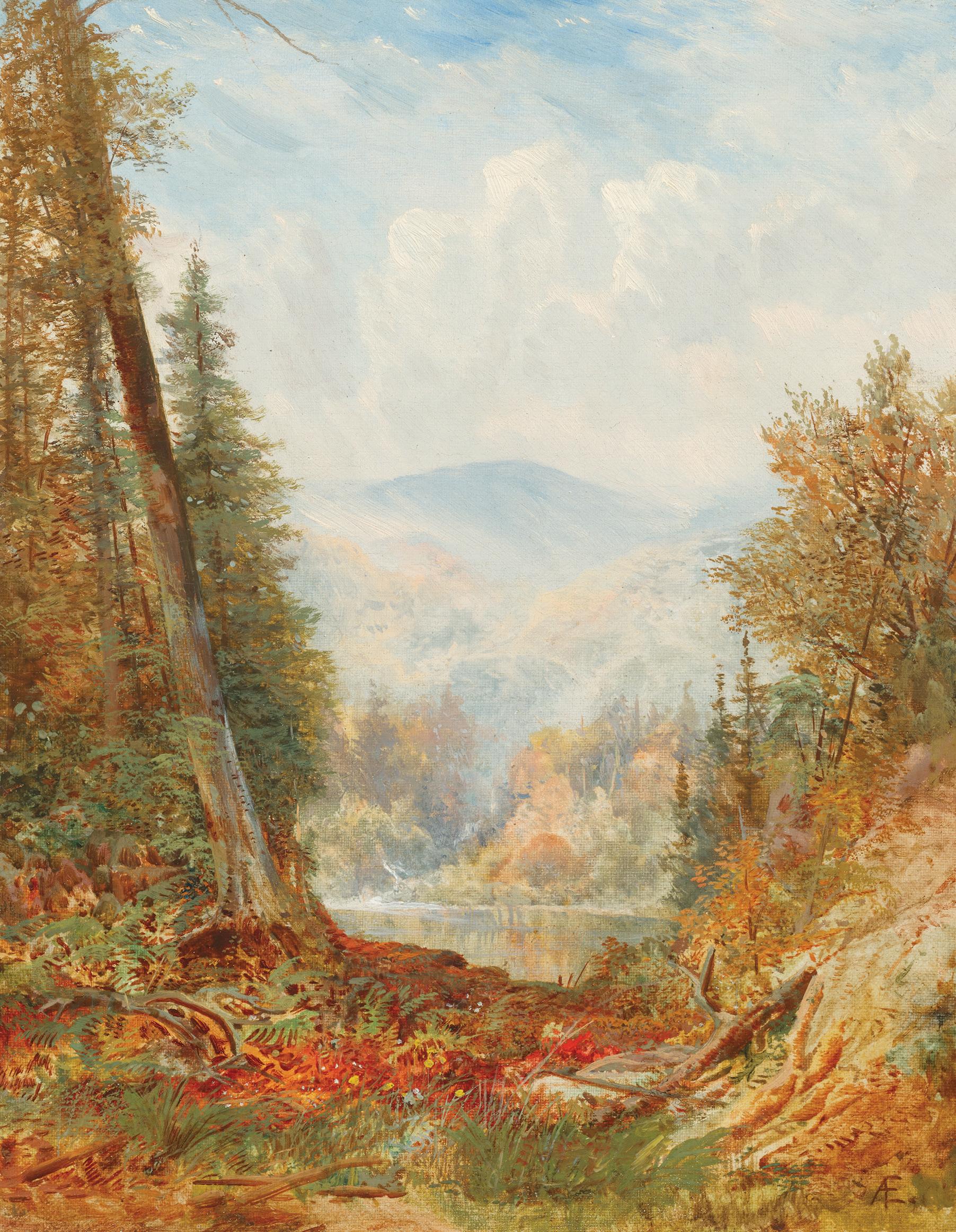
$1,000–$1,500
Additional images, details and extended essays related to the works of art included in the auction can be viewed at cowleyabbott.ca
COWLEY ABBOTT | An Important Private Collection of Canadian Art - Part II - Spring 2023 91 148
The provisions of these Terms and Conditions of Sale shall govern any proposed or actual transaction between Cowley Abbott (aka Consignor Auctions Limited) (“CAL”) and the prospective buyer/ bidder (“Bidder”). CAL is acting as agent for the person who has consigned the property to CAL for sale, whether as principal, owner or agent (“Consignor”).
1. The descriptions of items offered by CAL (“Property”), including artist, title, medium, size, date of execution, provenance, exhibition history, inclusion/reproduction within literature sources, attribution and genuineness, are subject to change leading to the final sale of said Property (including the process during which bidding is active for the Property during CAL online auctions). Descriptions of Property provided by CAL are not meant to stand as a representation to Bidders and no guarantee or warranty of complete accuracy of the provided descriptions is intended or should be assumed. Bidders are provided the opportunity to view and inspect all Property offered for sale by CAL through public and/or pre‒arranged private viewings prior to a sale’s completion. No sale shall be rescinded due to a lack of correspondence between the provided description of the Property by CAL and the Property itself, including the illustration of the Property provided by CAL. It is the sole responsibility of a Bidder to make arrangements for the inspection of the Property of interest (by the Bidder itself and/ or by the Bidder’s advisers) prior to sale, and to bid in accordance to this actual inspection and/or reliance upon their advisers’ guidance.
2. The Bidder who has successfully bid on Property (the “Successful Bidder”) confirms that any claims relating thereto shall be claims against Consignor, without recourse to CAL. CAL represents the Consignor exclusively and makes no representation or warranty, express or implied, regarding legal title or ownership of the Property offered by CAL and has relied upon the Consignor confirming same to CAL, without further independent investigation. The Bidder shall be solely responsible for satisfying itself of the legal title or ownership of the Property and liens or encumbrances affecting same and the capacity of the Consignor to sell the Property offered.
However, notwithstanding the stipulations listed above, the Successful Bidder may make arrangements for a recognized and fully‒qualified authority, who is accepted by CAL, to inspect the Property prior to collection by the Successful Bidder from CAL’s premises. Should this authority submit in writing to CAL a statement regarding the challenge of genuineness and/ or authenticity of the lot in question, the sale can be rescinded by CAL and a full refund will be provided to the Successful Bidder. The above process must take place within seven days of the final sale of the Property.
3. CAL is pleased to offer a service of providing condition reports on the lots which are offered through its auctions. Please note that these reports are matters of opinion and are prepared by CAL specialists and are not a substitute for a physical inspection of the artwork by the Bidder or their advisors. CAL specialists are not trained restorers and the provided condition reports are not meant to equal a comprehensive report created by a professional restorer. The reports provided by CAL are meant to provide assistance to the Bidder through observations of the artwork and the report will not disclose any imperfections which might be revealed through the process of subsequent restoration. In all cases, the Bidder is advised to consult their own conservator for a complete report with regard to condition (CAL is happy to provide access to the artwork by conservators through public previews and private pre‒arranged appointments). Bidders should be aware that CAL’s warranties with regard to the Property offered through their auctions are limited to the terms listed in the Terms and Conditions of Sale and in no case extend to the condition of the artwork.
4. A buyer’s premium of 20% of the successful bid price is to be paid by the Successful Bidder to CAL as part of the purchase price (a buyer’s premium of 21% of the successful bid price is to be paid by the Successful Bidder to CAL as part of the purchase price where the Auction Mobility technology is used to bid successfully during a live/catalogue auction). In addition, 13% HST (Harmonized Sales Tax) is applied to the successful bid (hammer) price and buyer’s premium. However, HST will not be charged on purchased Property which is shipped outside of Canada. Where purchased Property is shipped outside of the Province of Ontario but within Canada, the applicable HST or GST will be charged based on the tax applications within the province or territory of destination. In both cases, the Property must be collected from the offices of CAL with a waybill provided indicating the destination. It is the sole responsibility of the Purchaser to provide acceptable details and make the necessary arrangements to meet the requirements for altered tax responsibilities based on the destination of the shipped Property. Alterations of invoices and/ or crediting of tax payments will not be completed once CAL has released the Property.
5. The Bidder acknowledges that CAL may collect a commission and associated fees through its agreement with the Consignor of a lot included in a CAL auction.
6. Purchases completed through CAL auctions are not represented to necessarily include copyright allowances to the Successful Bidder for the purchased Property.
7. CAL reserves the right to withdraw any Property from sale for any reason whatsoever and without liability. This withdrawal may occur up to the close of bidding for the Property. CAL also reserves the right to divide lots of Property into smaller lots or to combine individual lots of Property into larger lots. The above can be carried out at the sole discretion of CAL and can occur without notice.
8. Each Bidder must register with CAL, agreeing to the Terms and Conditions of Sale. Registered Bidders represent that they are bidding on their own behalf and are responsible for those lots in which they are the successful high bidder (becoming the Purchaser or Successful Bidder). In the event that a registered Bidder is representing another party, CAL must be contacted regarding this arrangement at least twenty‒four hours prior to the opening of bidding for a particular auction and CAL reserves the right to refuse this arrangement for any reason whatsoever. Failure to abide by this provision shall entitle CAL to deem the Bidder as bidding on its own behalf. Splitting of and/or transferring of an invoice to an individual and/or organization other than the registered Bidder can only be completed at the discretion of CAL and must meet the requirements of such an amendment, including written authorization from both the registered Bidder and its beneficial buyer and the individual or representative of the individual who will become the new invoiced client in such an arrangement.
9. CAL reserves the right to refuse any bid and/or bidd ing registration application at their absolute discretion. Further, CAL also reserves the right to suspend or cancel any account used for bidding at their sole and absolute discretion. CAL also reserves the right to refuse any bid which is not in relation to the provided pre‒sale auction estimate provided by CAL and also reserves the right to not accept a bid recognized to not fall within the set bidding increments during sale. Additionally, CAL reserves the right to accept any bid which does not meet any pre‒established reserve. In no instance may a Bidder withdraw or alter their submitted bid.
10. CAL reserves the right to accept and execute absentee or telephone bids on behalf of prospective purchasers, unable to directly participate in the particular auction. In such a case, CAL provides the service of absentee or telephone bidding as a privilege and shall not be responsible for failure to execute the absentee bid(s)
COWLEY ABBOTT | An Important Private Collection of Canadian Art - Part II - Spring 2023 92
Terms & Conditions of Sale
for any reason whatsoever and shall also not be responsible for errors and/or omissions related to the process. Bidders who wish to employ CAL in the process of absentee or telephone bidding must complete and sign the required documentation (absentee/ telephone bidding form) prior to the start of bidding for the particular auction. In the event that two identical absentee bids are submitted to CAL, the bid which is received earlier (and which has been submitted through a completed and signed absentee bidding form) will take precedence over the later bid(s), allowing the earlier submitted bid(s) to potentially purchase the lot(s) at bid level submitted.
CAL reserves the right to request and charge a deposit to a Bidder submitting an absentee or telephone bid, in relation to the value of the artwork, to a maximum of $10,000 CAD. CAL reserves the right to hold and apply this Deposit to the invoice, should the Bidder become the Successful Bidder. In the event that final payment and invoice settlement is not made within 30 days following the completion of the live auction, then CAL shall have the right to rescind the purchase and the Deposit shall be retained by CAL as liquidated damages. In the event that the Bidder is not successful, the Deposit will be refunded within 10 business days following the completion of the auction.
11. CAL is pleased to provide the opportunity for bidders to participate through online bidding during live auctions via Auction Mobility, a third‒party provider of these services. Please be aware that CAL is not responsible for errors or issues associated with this service which may have an adverse effect on the Client’s ability to bid. A buyer’s premium of 21% of the successful bid price is to be paid by the Successful Bidder to CAL as part of the purchase price where the Auction Mobility technology is used to bid successfully during a live/catalogue auction.
12. At the completion of the sale, the Successful Bidder shall be recognized as the Purchaser and shall then take on complete responsibility and risk for the purchased Property, adhering to all of the Terms and Conditions of Sale. In the event of a dispute between the Successful Bidder and any other Bidder regarding the result of the auction, CAL will have absolute discretion to rescind any transaction with the Successful Bidder and designate a new winning buyer or to withdraw the Property from the auction. In such a case, CAL may choose to re‒offer the Property in a future auction or private sale. In all such cases, final decision shall be made solely by CAL.
13. The Successful Bidder shall make arrangements with CAL for the payment of the whole invoiced amount following the immediate close of the auction, unless alternate arrangements are agreed by CAL for payment of a portion of the invoiced amount. Until full and final settlement of the invoice is completed by the Successful Bidder, the purchased Property will not be released to the Successful Bidder. Failure to pay for purchases may lead to the cancellation of the sale with no promise of re‒offering in a future auction. In the event of failure of payment by the Successful Bidder, CAL reserves the right to suspend and/or delete the bidding account of the Bidder and/or their representatives, all at the sole discretion of CAL. The artwork must be collected by the Successful Bidder or his/her representative or delivered to the shipping destination within 14 days of the invoice date.
14. Immediately following the completion of a CAL online auction, the Successful Bidder shall be charged 10% up to a maximum of $10,000 of the hammer price (the “Deposit”), which amount will be held as a deposit against payment for the Property purchased. The Successful Bidder hereby authorizes CAL to charge the Successful Bidder’s registered credit card with the Deposit. The Successful Bidder shall settle final payment and collect their purchase(s) from CAL within five business days following the completion of any CAL auction. Failure to settle payment and/ or collect the property from CAL within five business days may lead to monthly interest charges of 1.5% in addition to the invoice
amount and/or storage charges for the Property being held on the premises of CAL. Property being held by CAL is being stored at the sole risk of the Successful Bidder and may be stored either on the premises of CAL or at a secondary storage location. In the event that final payment is not made within 30 days following the completion of the auction, then CAL shall have the right to rescind the purchase and, if it is in an online CAL auction, the Deposit shall be retained by CAL as liquidated damages.
15. CAL, its employees or agents, shall not be liable for the loss or damage of any Property purchased through a CAL auction (through negligence or otherwise) while the Property remains in the possession of CAL and once the allowed five business days following an auction closure or completion of a private sale has passed.
16. In any event resulting in failure by the Successful Bidder (Purchaser) to pay for Property purchased either through the defined auction process or a private sale within the five day period following the sale, CAL, in its sole discretion, may re‒offer the Property in question without limiting the terms in place with the Consignor of the Property. Should CAL reoffer the Property, the original Successful Bidder (Purchaser) shall be responsible to CAL and the Consignor for the following: any difference marked as a deficiency between the price achieved and amount invoiced upon the re‒sale of the Property versus the price achieved and amount invoiced to the Purchaser upon the original sale of the Property; any storage charges to CAL for the holding of the Property between its original offering and the reoffering; and the total in sales commissions which CAL would have collected had the original sale of the Property been completed.
17. CAL accepts payment by cash, certified cheque, wire transfer, VISA, Mastercard and/or American Express (AMEX) for the settlement of invoices. Credit card purchases are limited to a maximum of $25,000 CAD and the credit card holder must be present at the time of payment. Artwork purchased with a certified cheque will not be released by CAL until the clearance of the cheque has been confirmed by CAL’s bank. Payments arranged by wire transfer may be subject to administrative charges related to the transfer and banking processes.
18. CAL is pleased to assist clients in arranging for the shipment of their artwork from our Toronto premises. However, it is the responsibility of the Successful Bidder to make these arrangements in full, including the packing, insuring and actual shipment of the Property. Assistance provided by CAL in this regard is provided as a service and CAL carries absolutely no liability through this courtesy. CAL carries absolutely no liability to possible damage of framing (including glass) during shipment arranged by CAL or otherwise.
19. Without limitation, the Purchaser accepts that any lot (Property) purchased through CAL may be subject to provisions of the Cultural Property Export and Import Act (Canada).
20. CAL reserves the right to refuse admission, enrolment and/ or participation in any of their events and/or auctions. Further, CAL reserves the right to refuse admission to their premises to any individual or group of individuals.
21. These Terms and Conditions of Sale and all agreements related to the business of CAL shall be construed under the laws of Ontario and the parties hereby attorn to the exclusive jurisdiction of the Ontario Courts.
22. This agreement may be executed and delivered in a number of counterparts, each of which when executed and delivered is an original but all of which taken together constitute, as applicable, one and the same instrument.
COWLEY ABBOTT | An Important Private Collection of Canadian Art - Part II - Spring 2023 93

Front Cover
Lawren Stewart Harris, Quiet Lake (Northern Painting 12), circa 1926-1928 (Lot 125)
Back Cover
James Wilson Morrice, À Venise (Study for “Red Houses, Venice”) (Lot 105)
Inside Front Cover
Alexander Young Jackson, Le Boulanger, Baie-Saint-Paul, circa 1925 (detail) (Lot 109)
Inside Back Cover
Paul Peel, The Young Gleaner (detail) (Lot 118)
Artwork Features
Page 1: Albert Henry Robinson, Les Éboulements en haut (detail) (Lot 104)
Page 2: Emily Carr, Kitwancool (detail) (Lot 108)
Page 4: Arthur Lismer, A September Gale, Georgian Bay (detail) (Lot 129)
Page 6: David Brown Milne, The Black Couch (detail) (Lot 114)
Page 95: Franklin Peleg Brownell, Tea Time (detail) (Lot 111)
Page 97: Mary Alexandra Bell Eastlake, In the Orchard, circa 1895-1897 (detail) (Lot 122)
Beau, Henri (1863-1949) 145 Bell-Smith, Frederic Marlett (1846-1923) 101 Brownell, Peleg Franklin (1857-1946) 111 Bruce, William Blair (1859-1906) 115 Carmichael, Franklin (1890-1945) 113 Carr, Emily (1871-1945) 108, 135 Clapp, William Henry (1879-1954) 128 Eastlake, Mary Alexandra Bell (1864-1951) 122 Edson, Aaron Allan (1846-1888) 148 Fowler, Daniel (1810-1894) 147 Franchère, Joseph-Charles (1866-1921) 123, 124 Fraser, John Arthur (1838-1898) 140 Hamel, Théophile (1817-1870) 119, 120 Harris, Lawren Stewart (1885-1970) 125 Harris, Robert (1849-1919) 142 Huot, Charles Edouard (1855-1930) 143 Jackson, Alexander Young (1882-1974) 109, 134 Johnston, Frank Hans (1888-1949) 127 Julien, Octave Henri (1852-1908) 132 Kerr-Lawson, James (1862-1939) 146 Krieghoff, Cornelius (1815-1972) 121 Lismer, Arthur (1885-1969) 129, 144 MacDonald, James Edward Hervey (1873-1932) 103, 133 Milne, David Brown (1882-1953) 114, 138 Morrice, James Wilson (1865-1924) 105 Napier, William Henry Edward (1829-1894) 130 O'Brien, Lucius Richard (1832-1899) 141 Peel, Paul (1860-1892) 118 Raphael, William (1833-1914) 107, 136, 137 Robinson, Albert Henry (1881-1956) 104 Roper, Edward (1857-1891) 106 Rosenberg, Henry Mortikar (1858-1947) 139 Sandham, Henry John (1842-1910) 110 Suzor-Coté, Marc-Aurèle de Foy (1869-1937) 112, 131 Thomson, Tom (1877-1917) 116 Varley, Frederick Horsman (1881-1969) 117 Walker, Horatio (1858-1938) 102, 126
INDEX OF ARTISTS

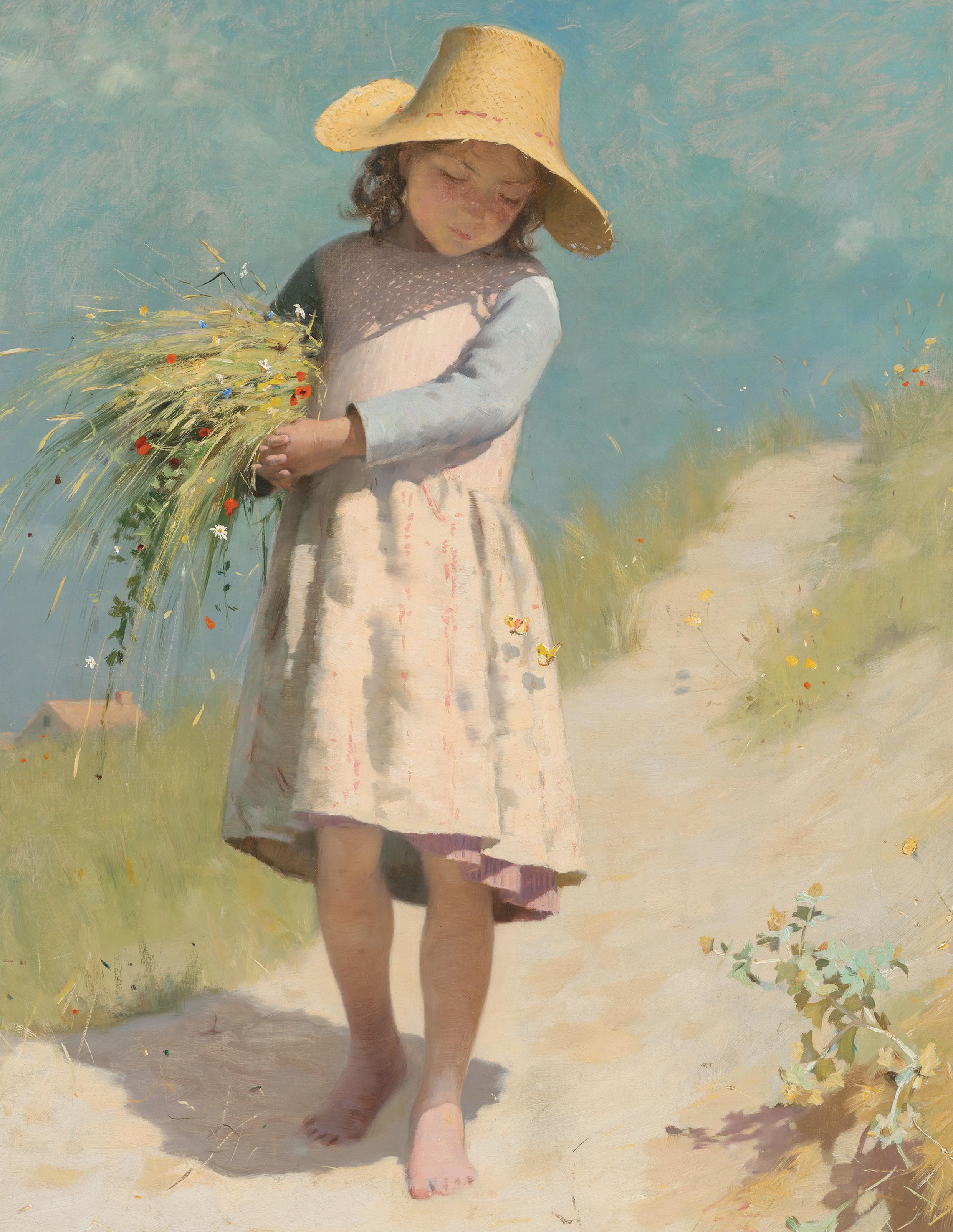
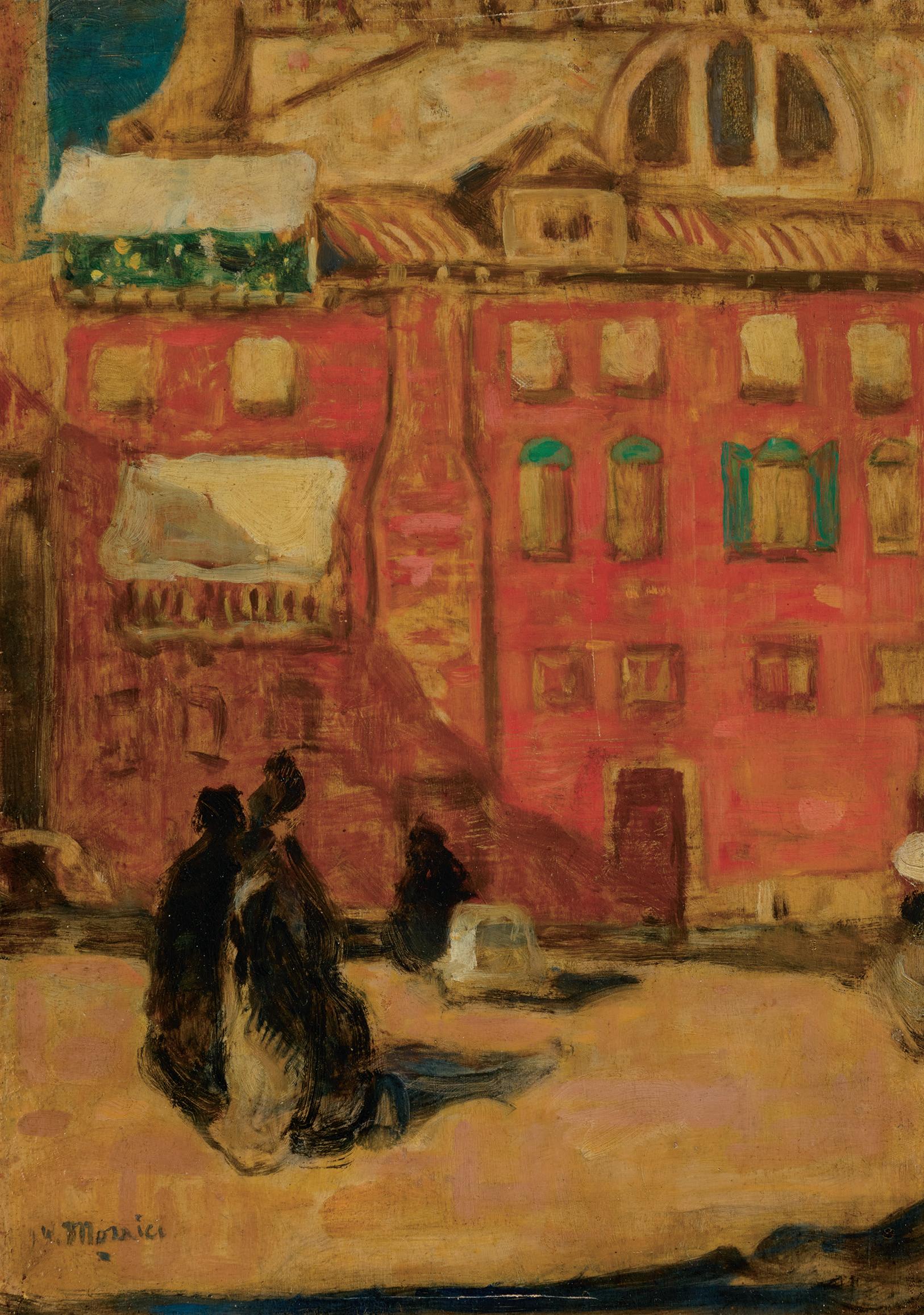



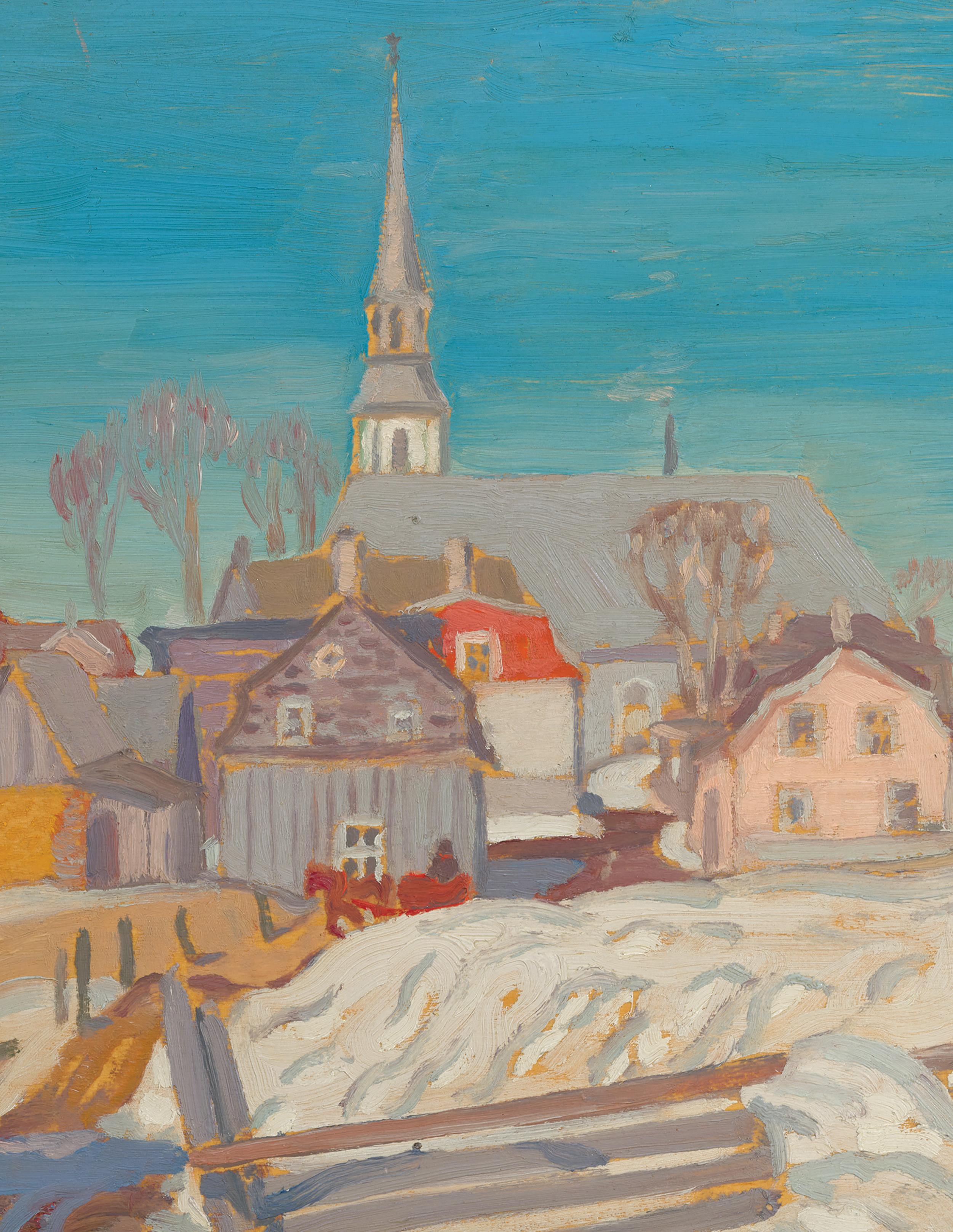
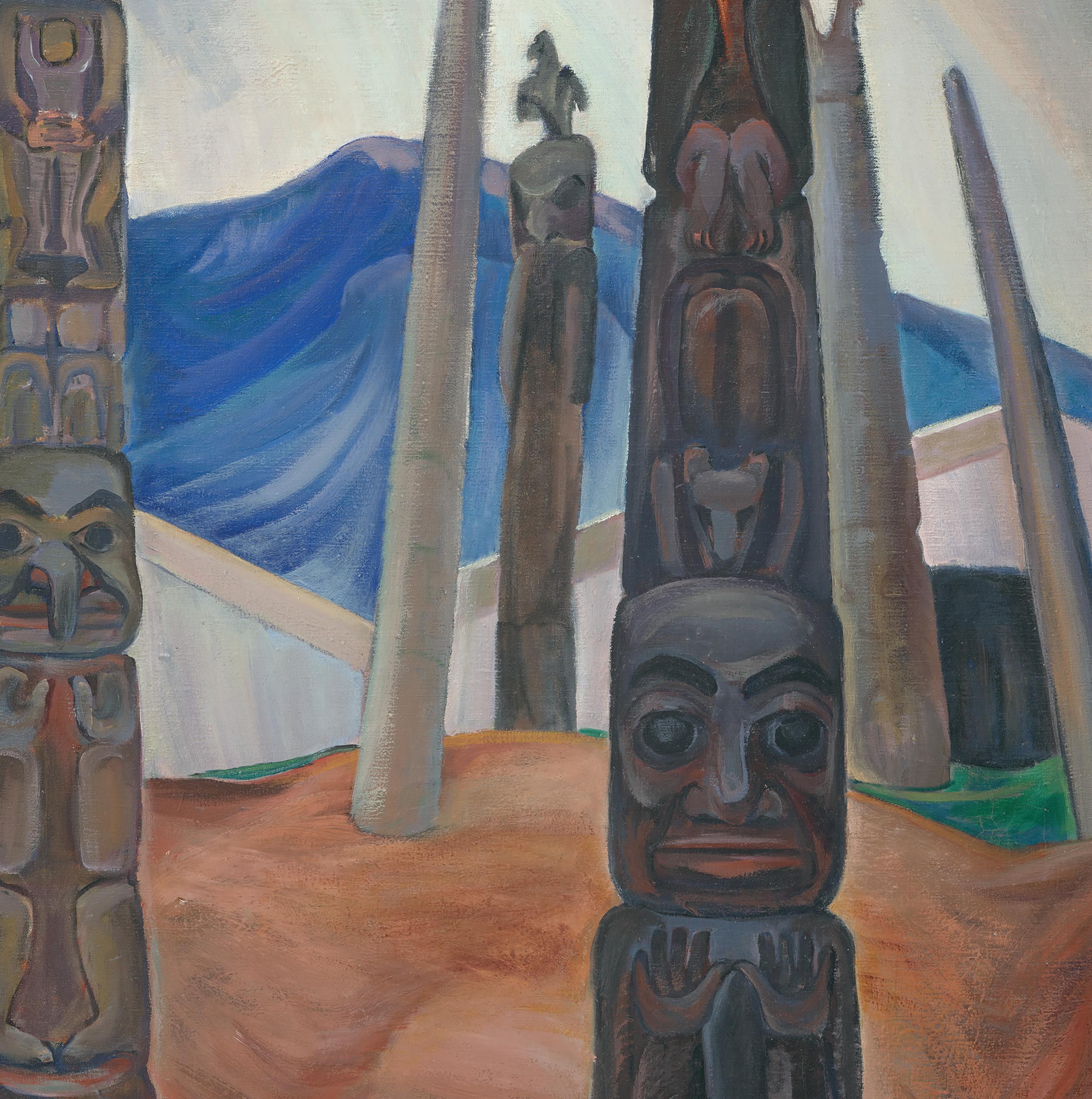










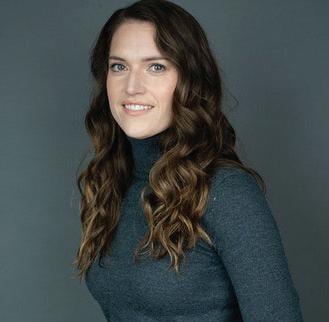










 Exhibition of Collector’s Canada: Selections from a Toronto Private Collection Art Gallery of Ontario, 1988
Photo: Art Gallery of Hamilton
Exhibition of Embracing Canada: Landscapes from Krieghoff to the Group of Seven Art Gallery of Hamilton, 2016
Exhibition of Collector’s Canada: Selections from a Toronto Private Collection Art Gallery of Ontario, 1988
Photo: Art Gallery of Hamilton
Exhibition of Embracing Canada: Landscapes from Krieghoff to the Group of Seven Art Gallery of Hamilton, 2016









































































